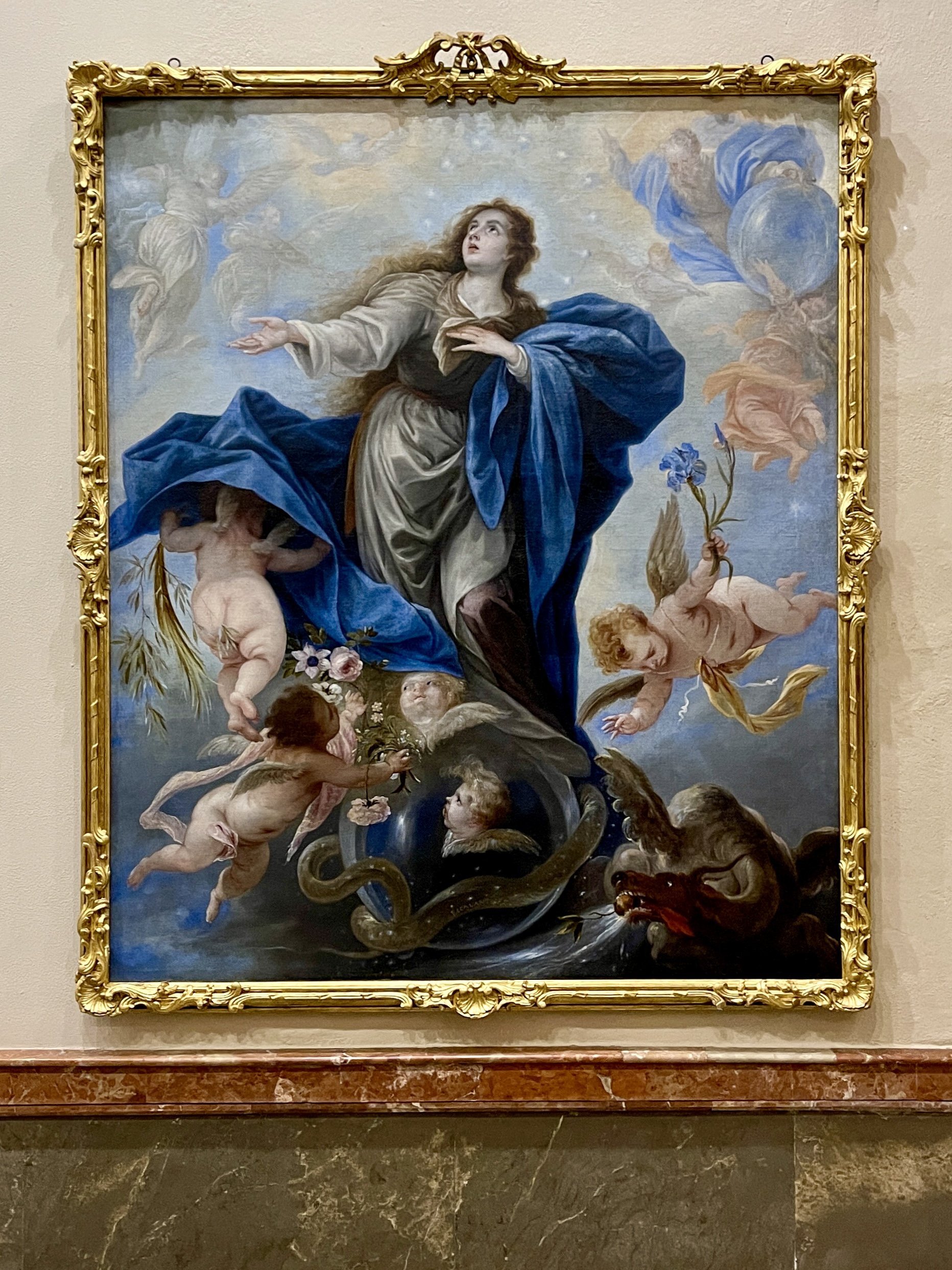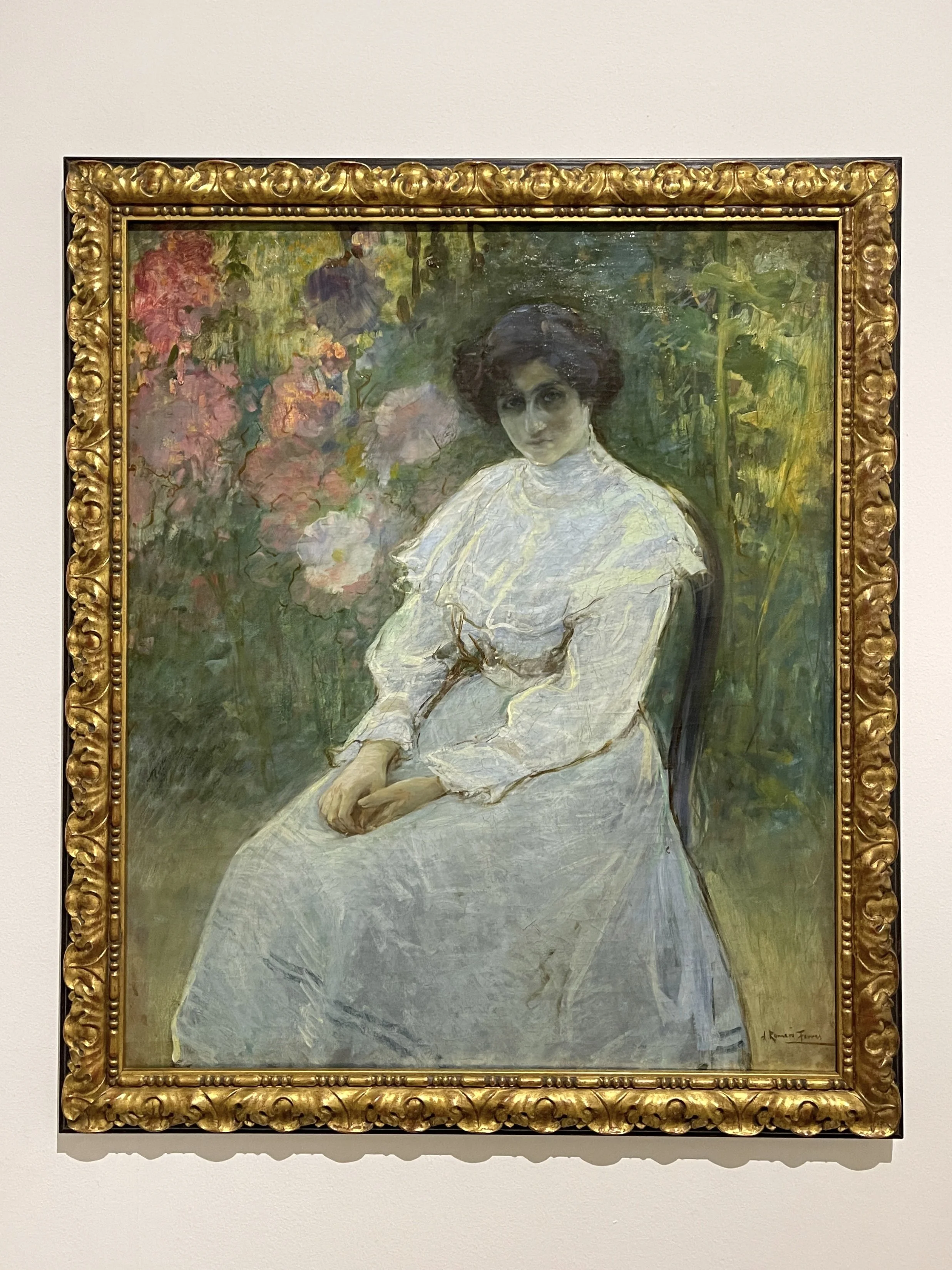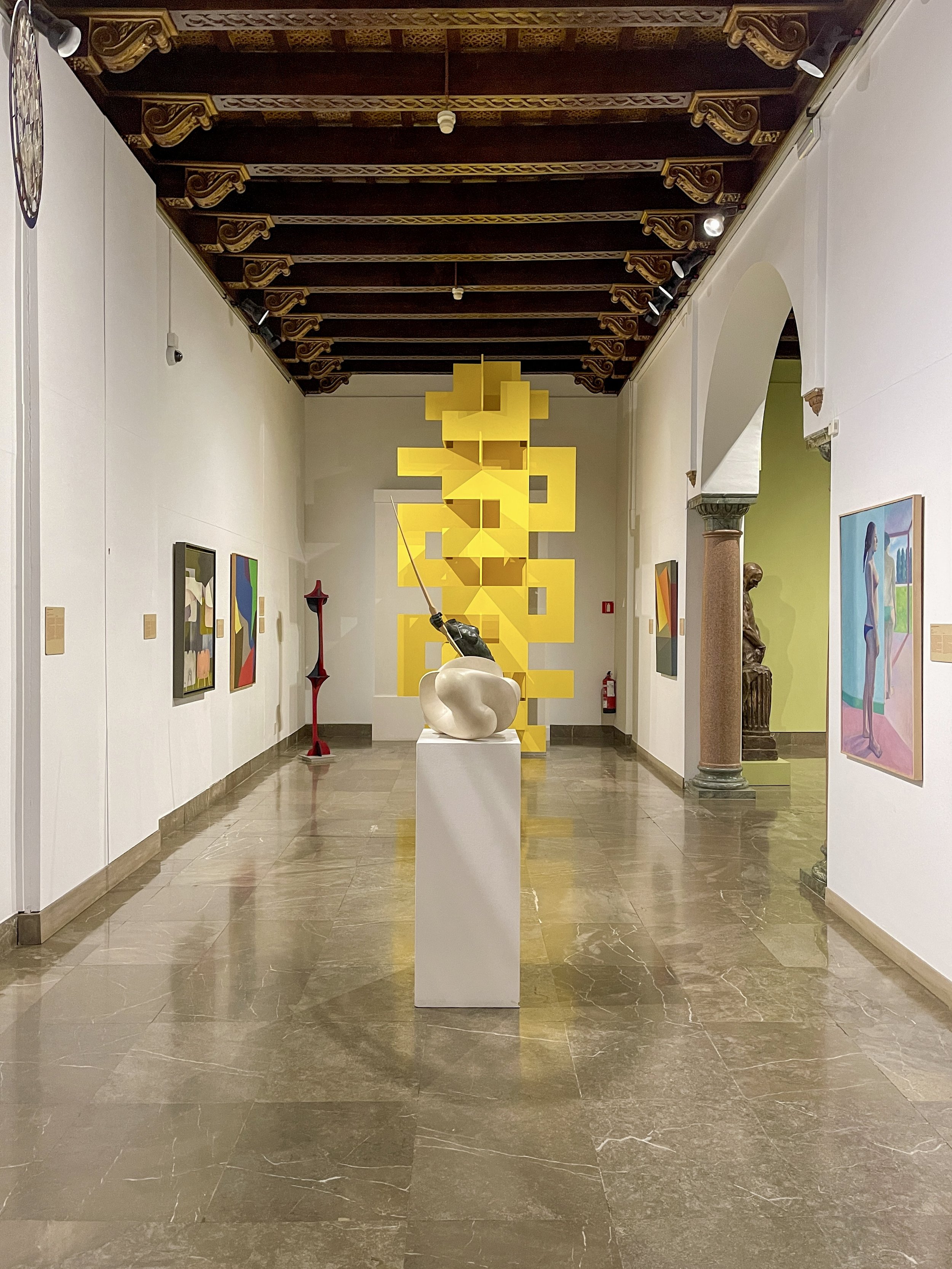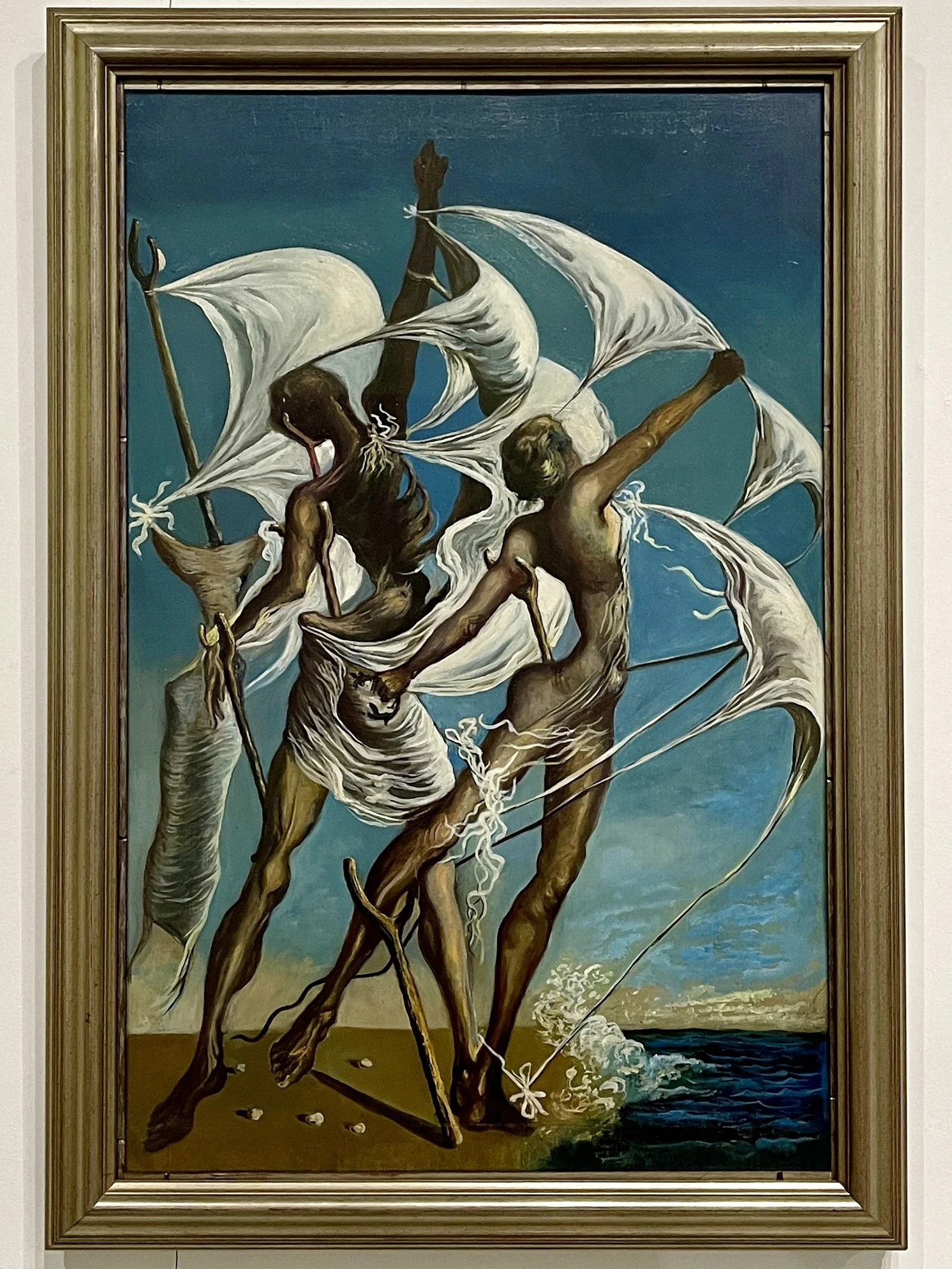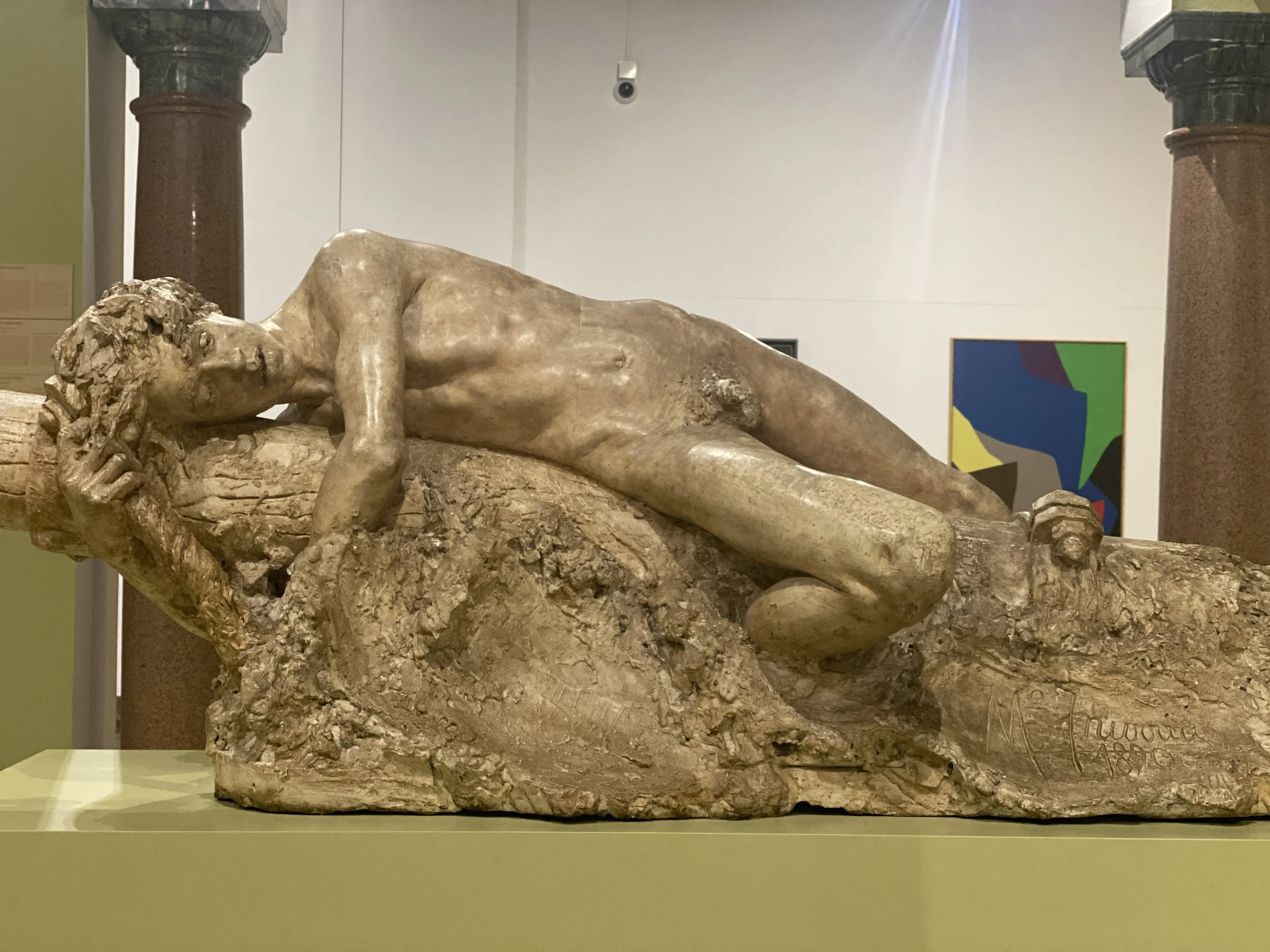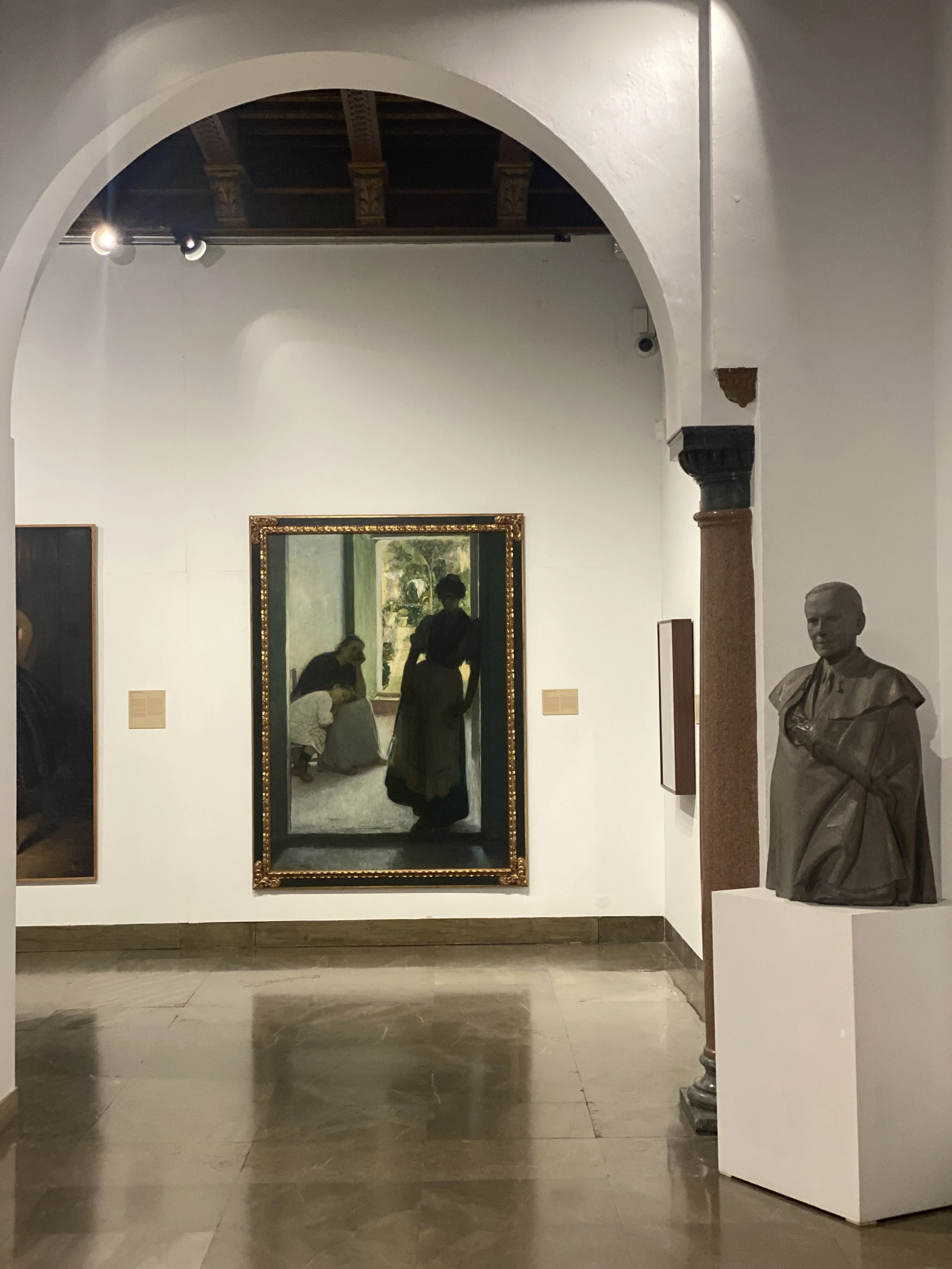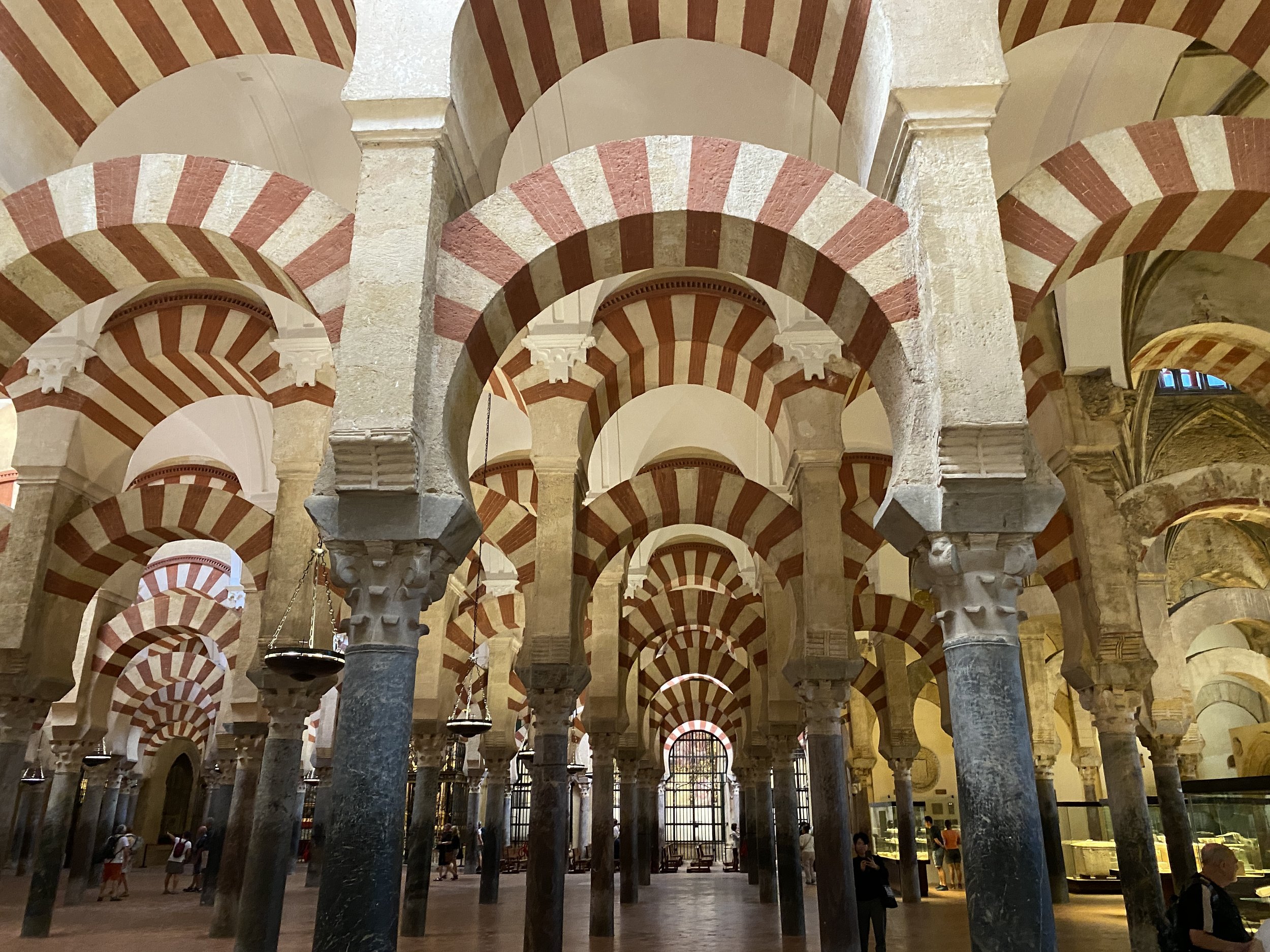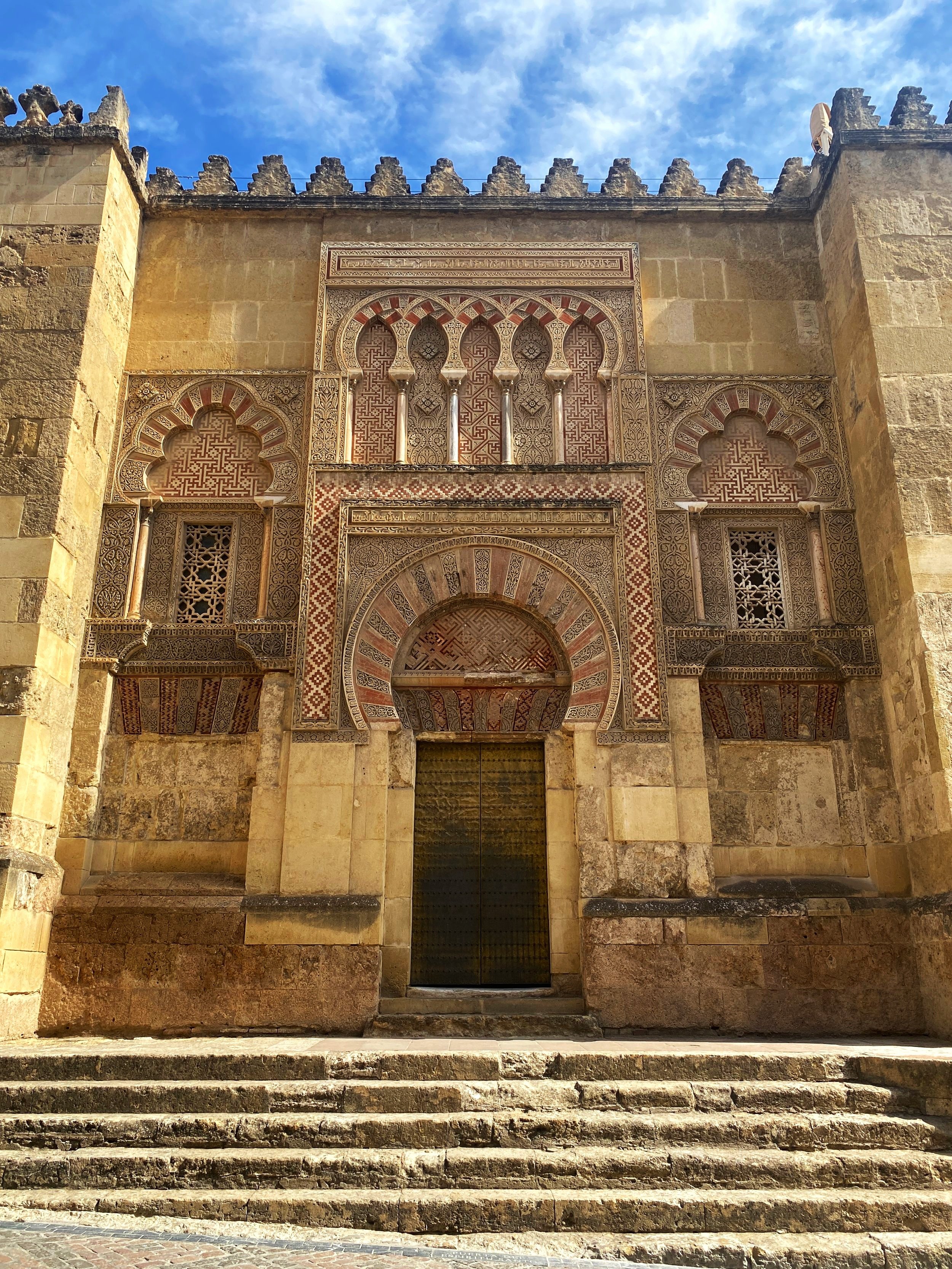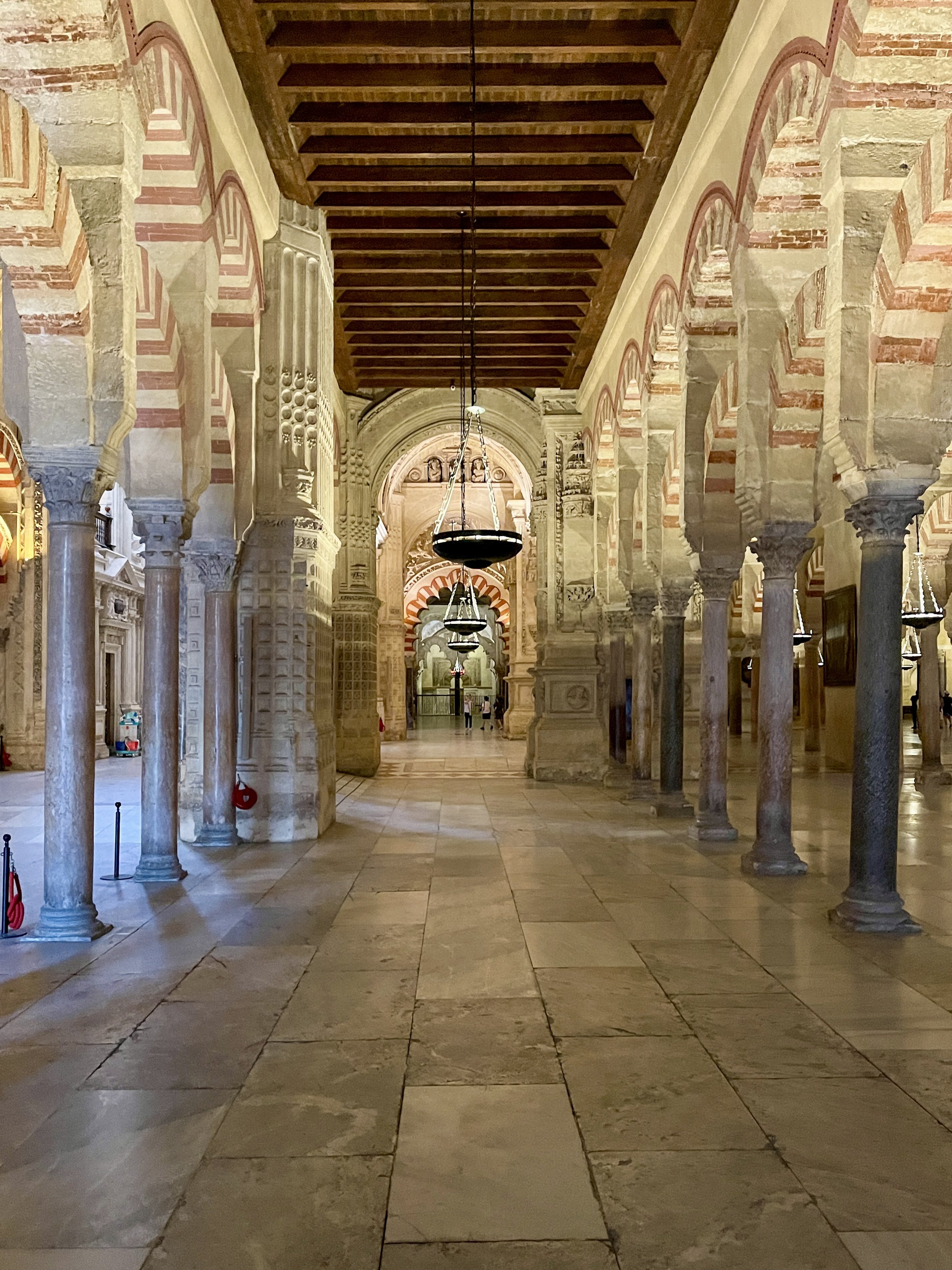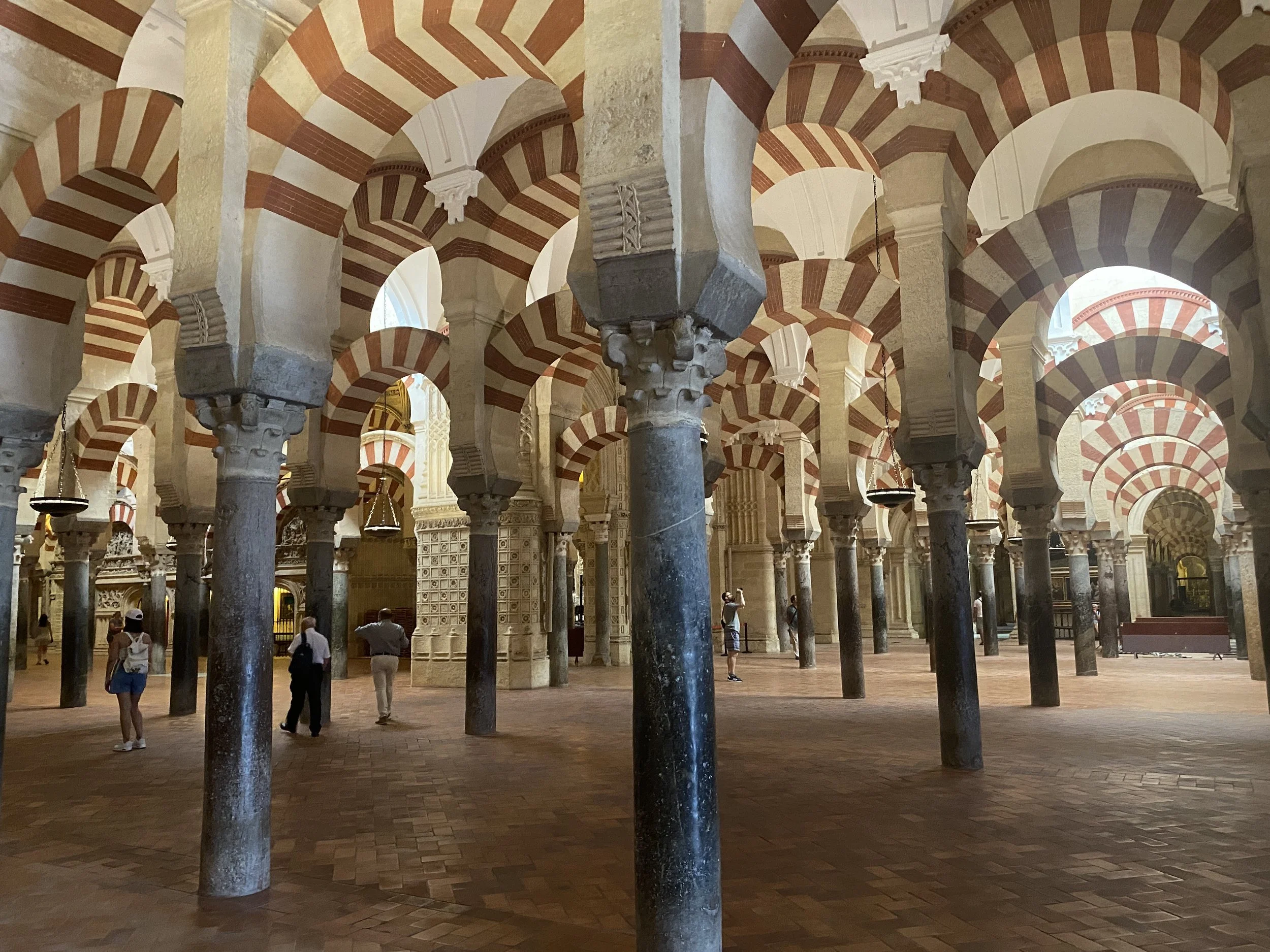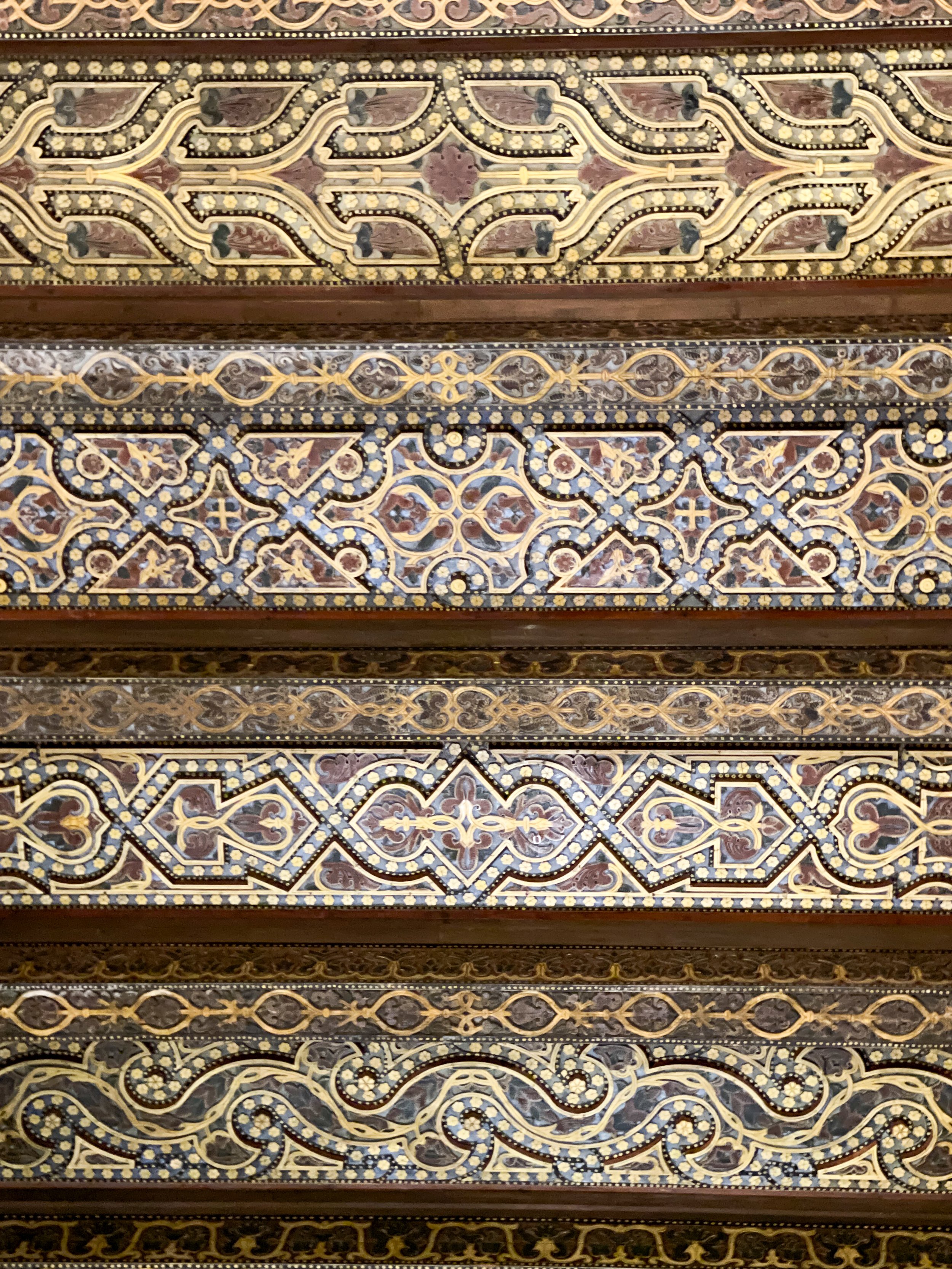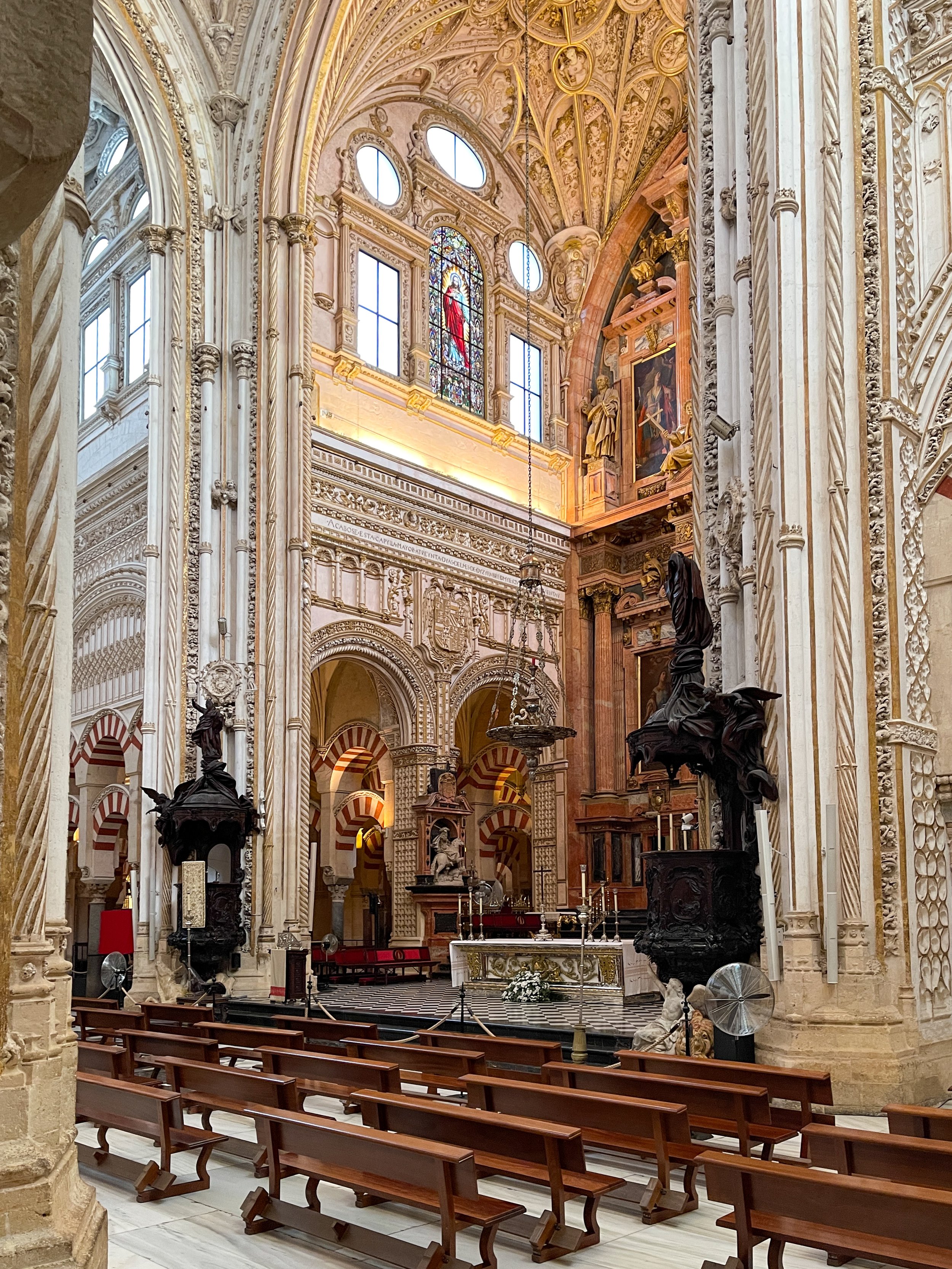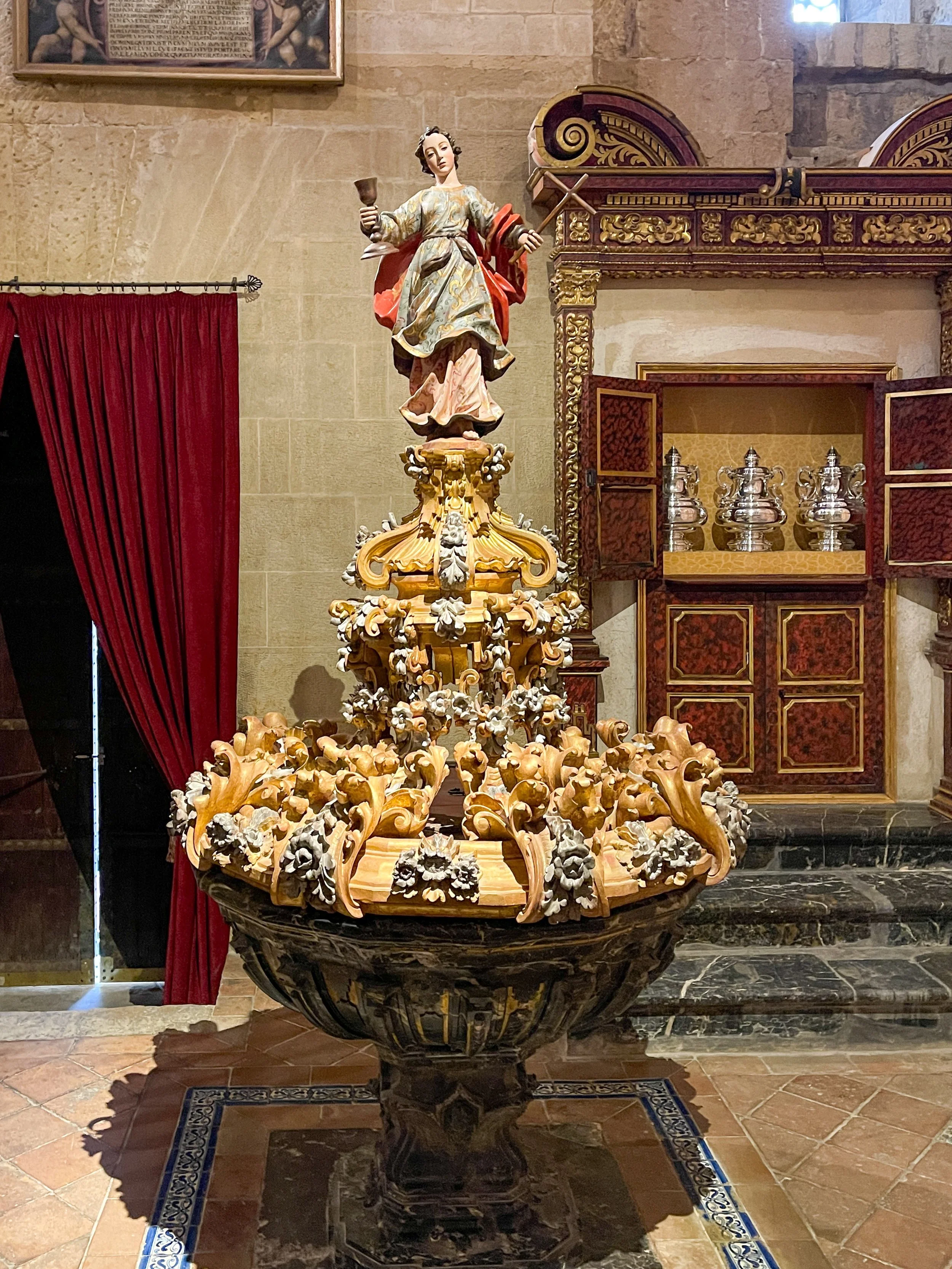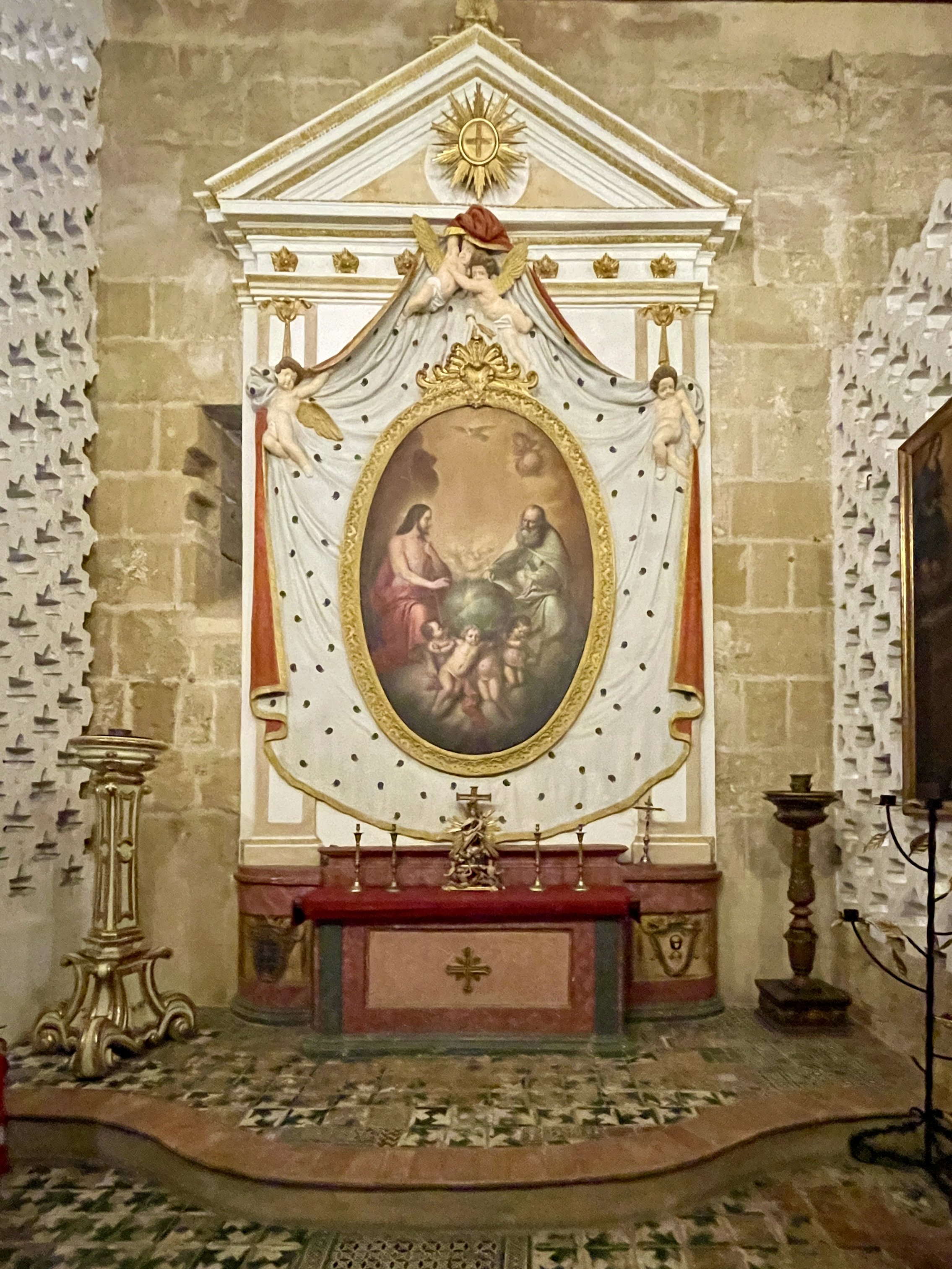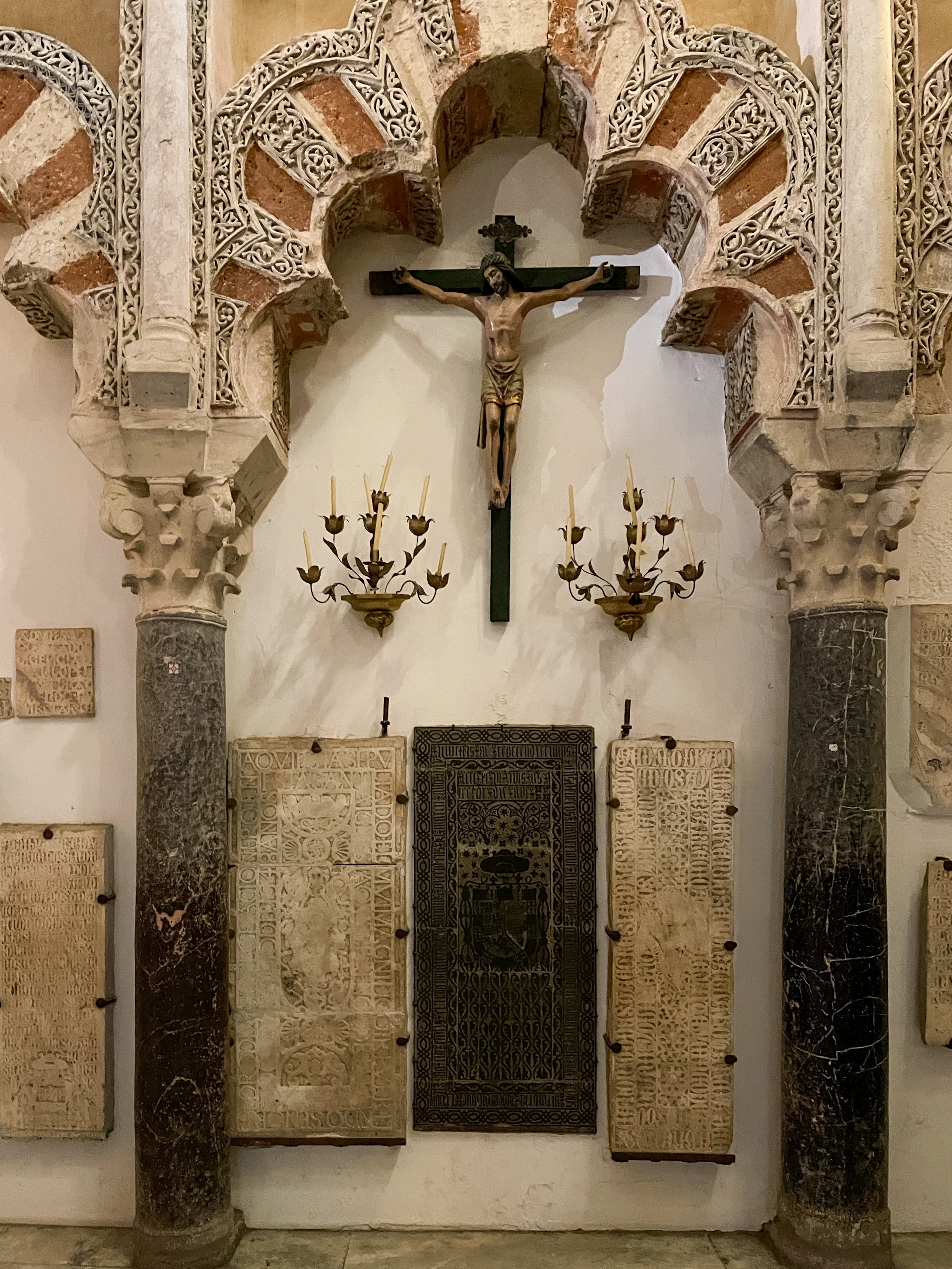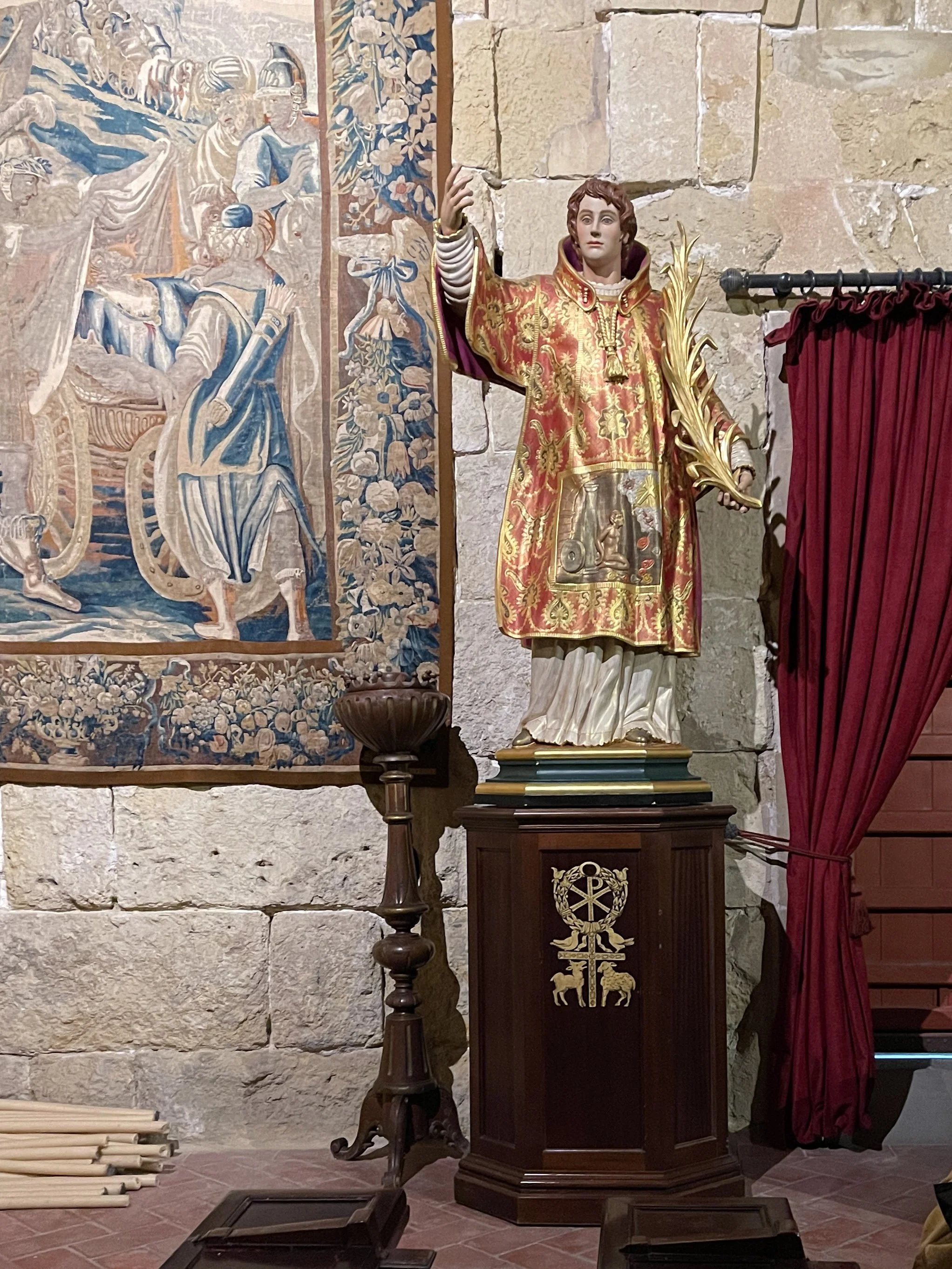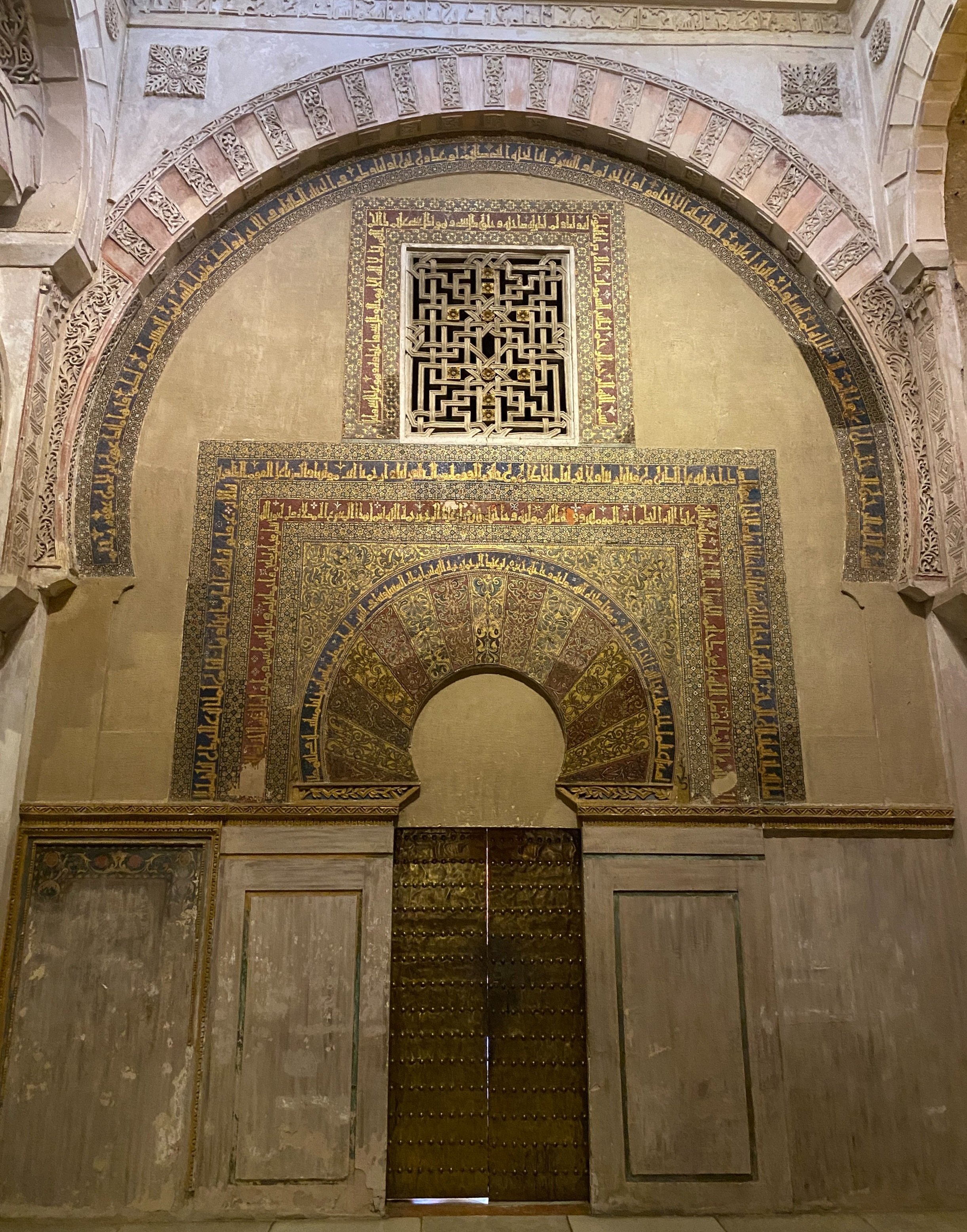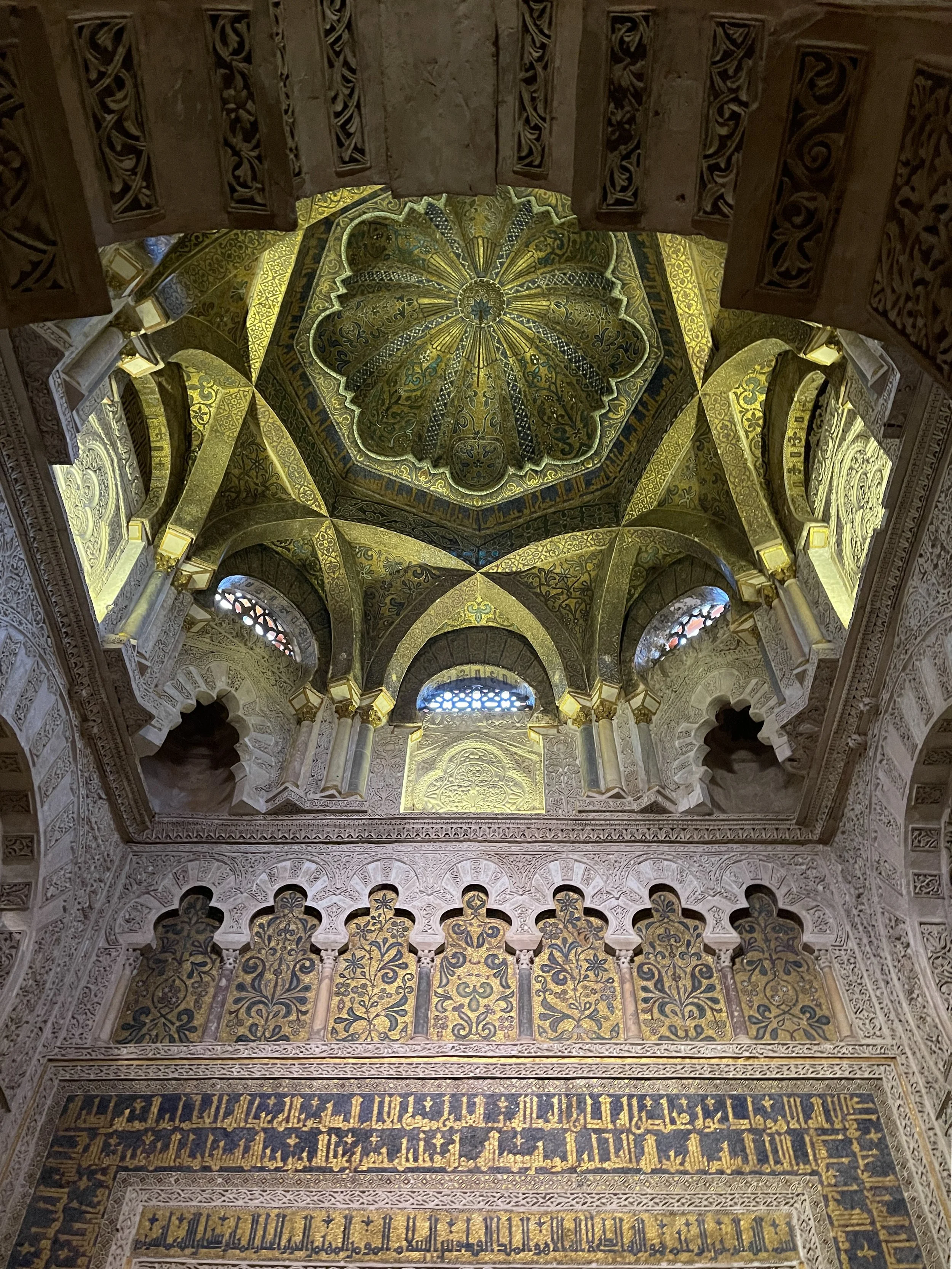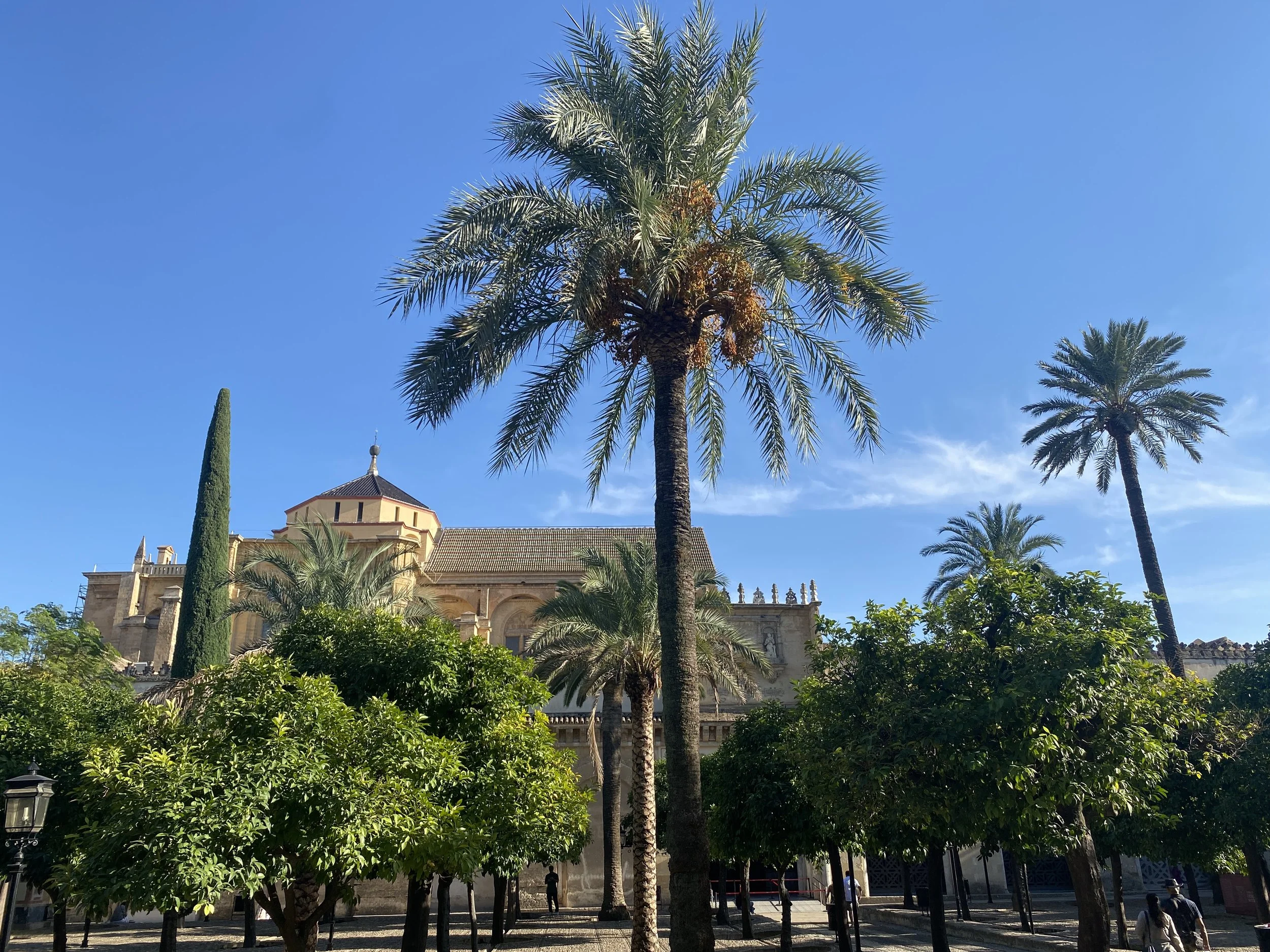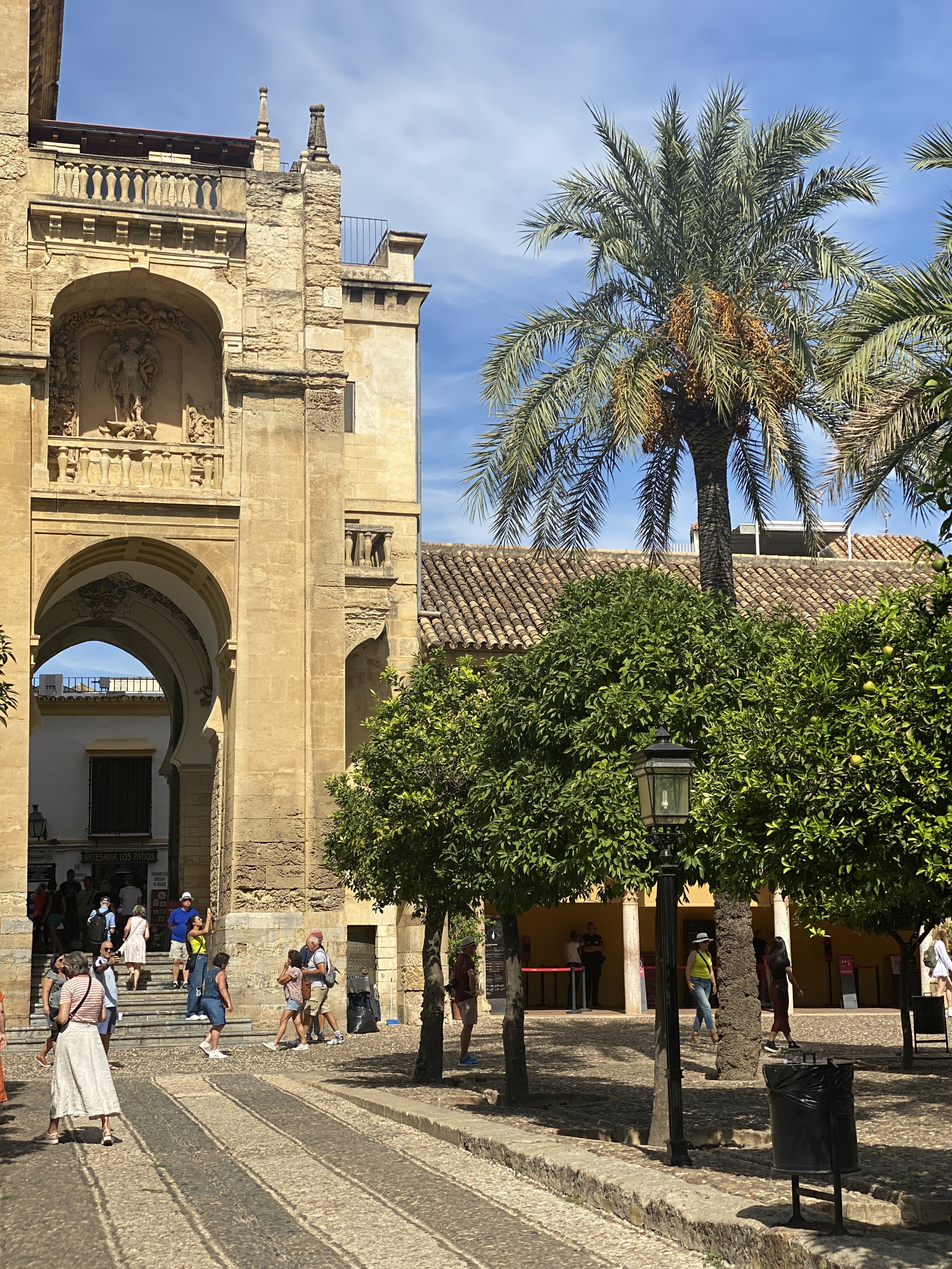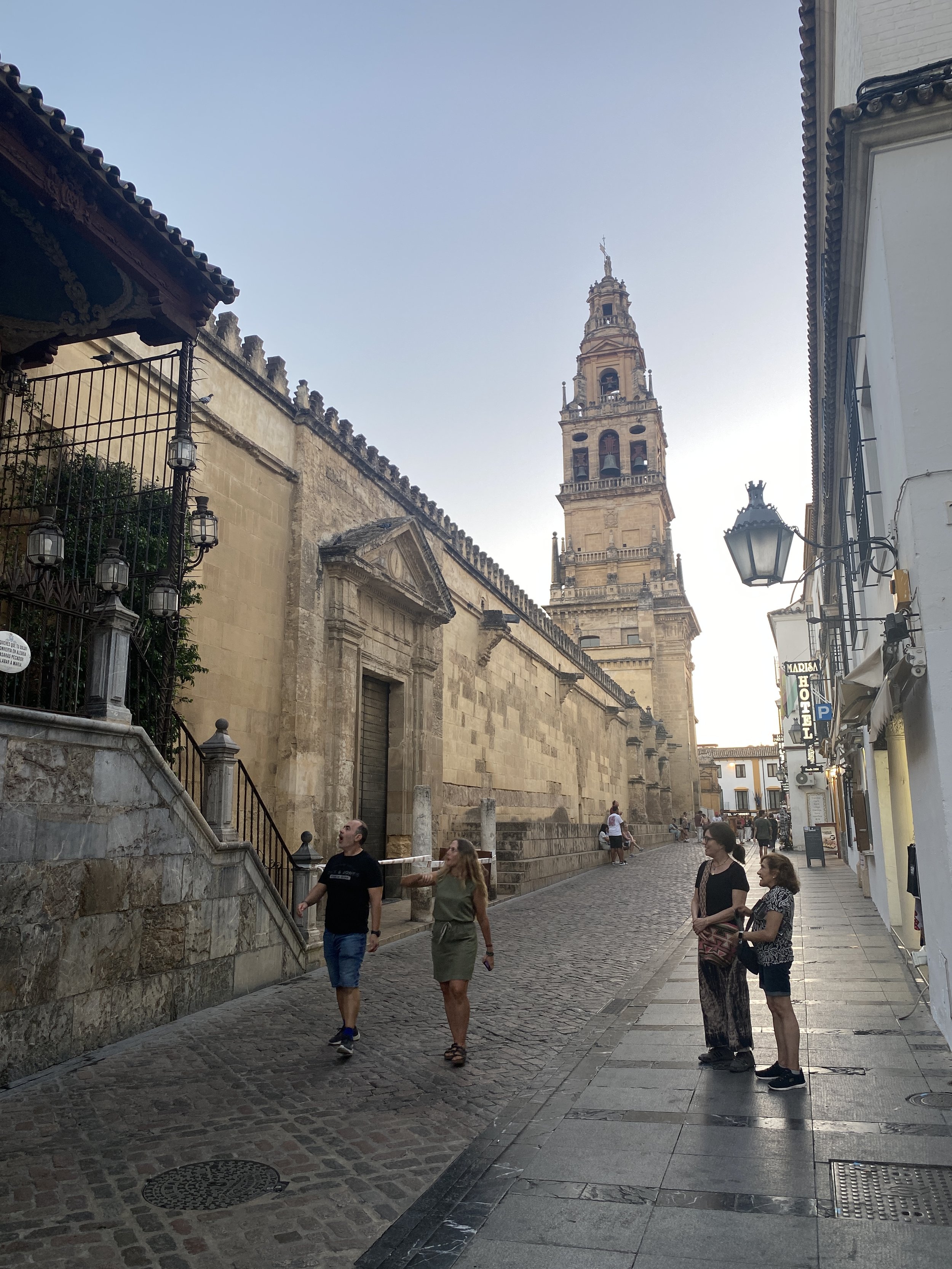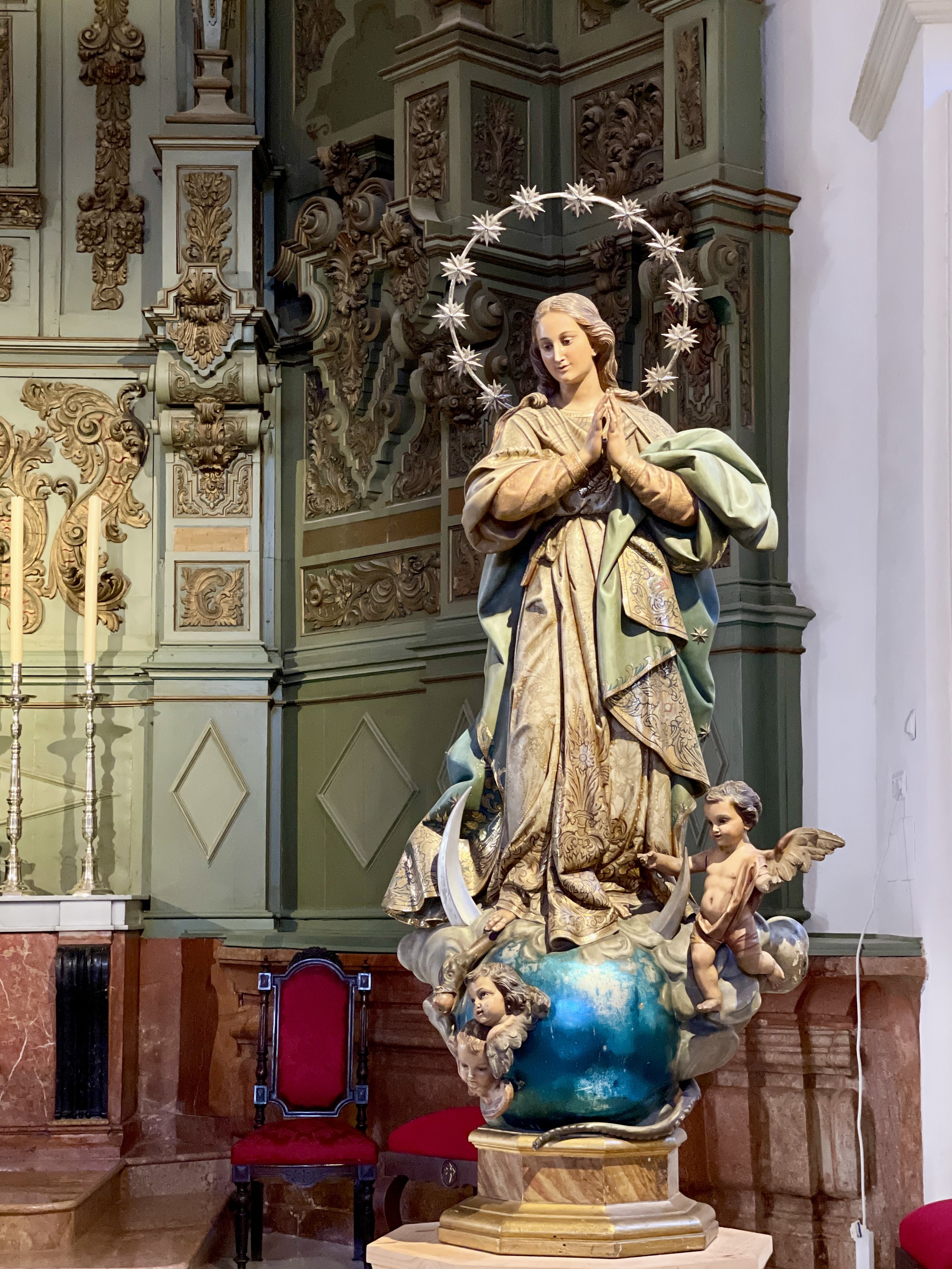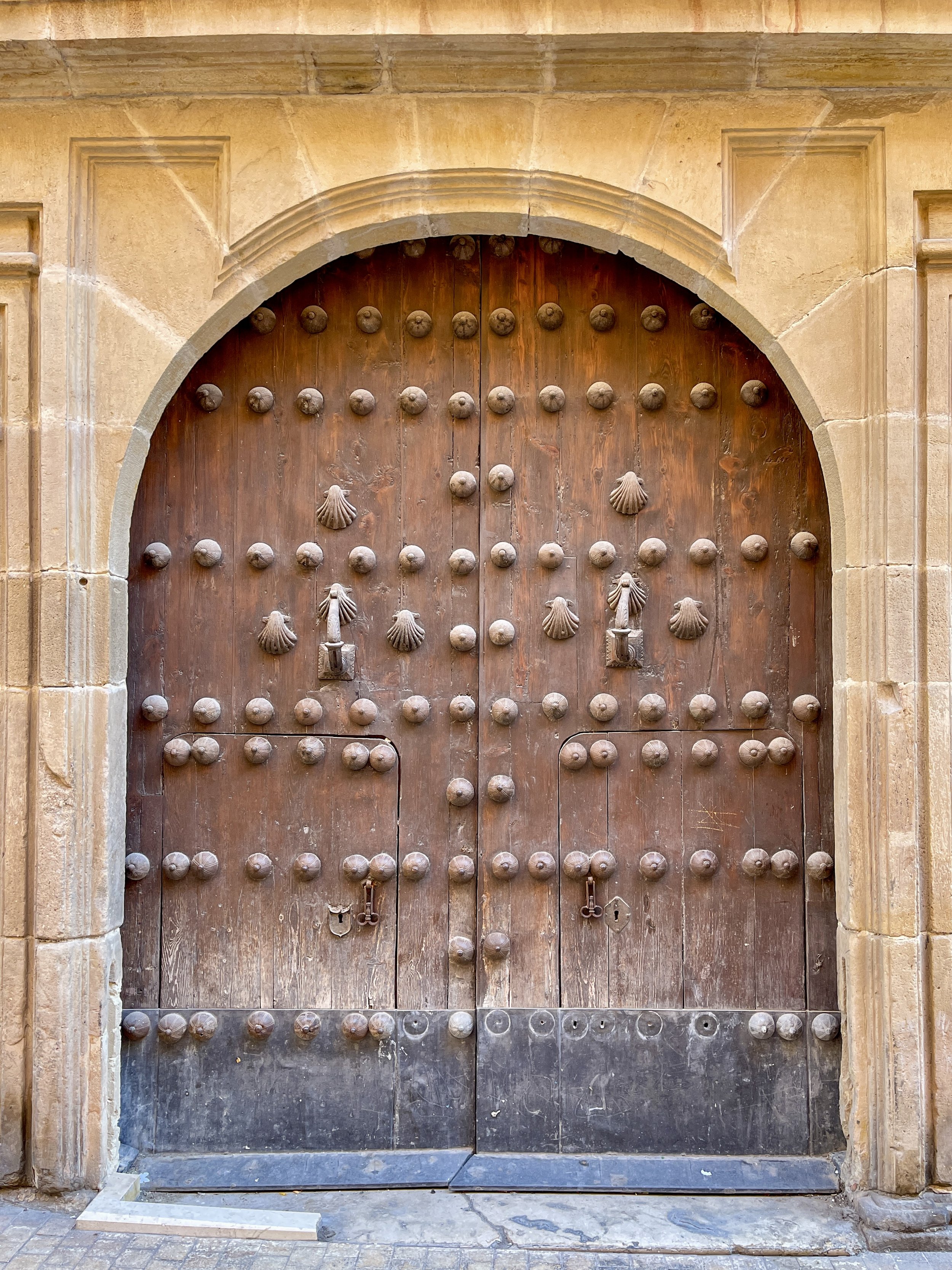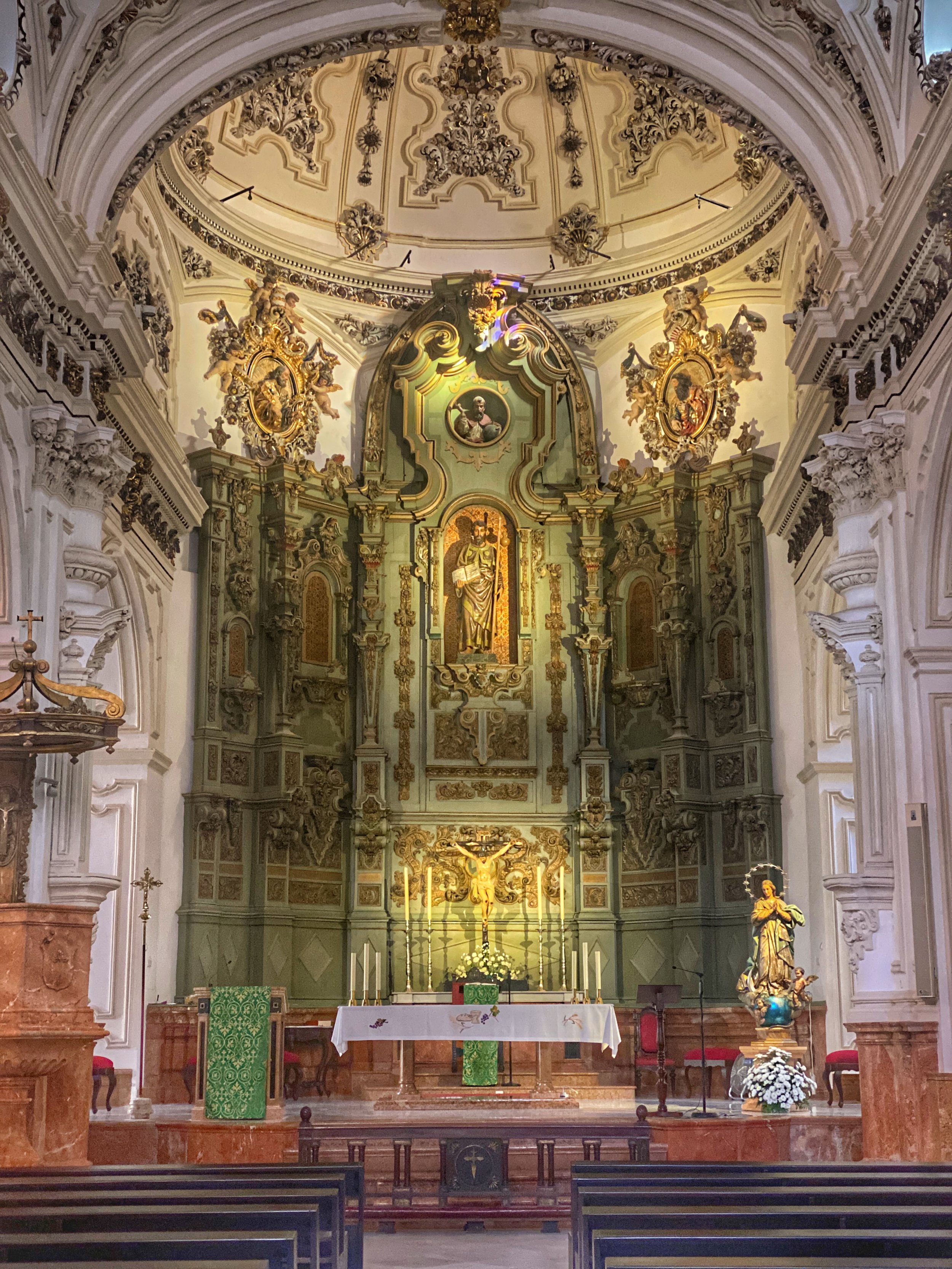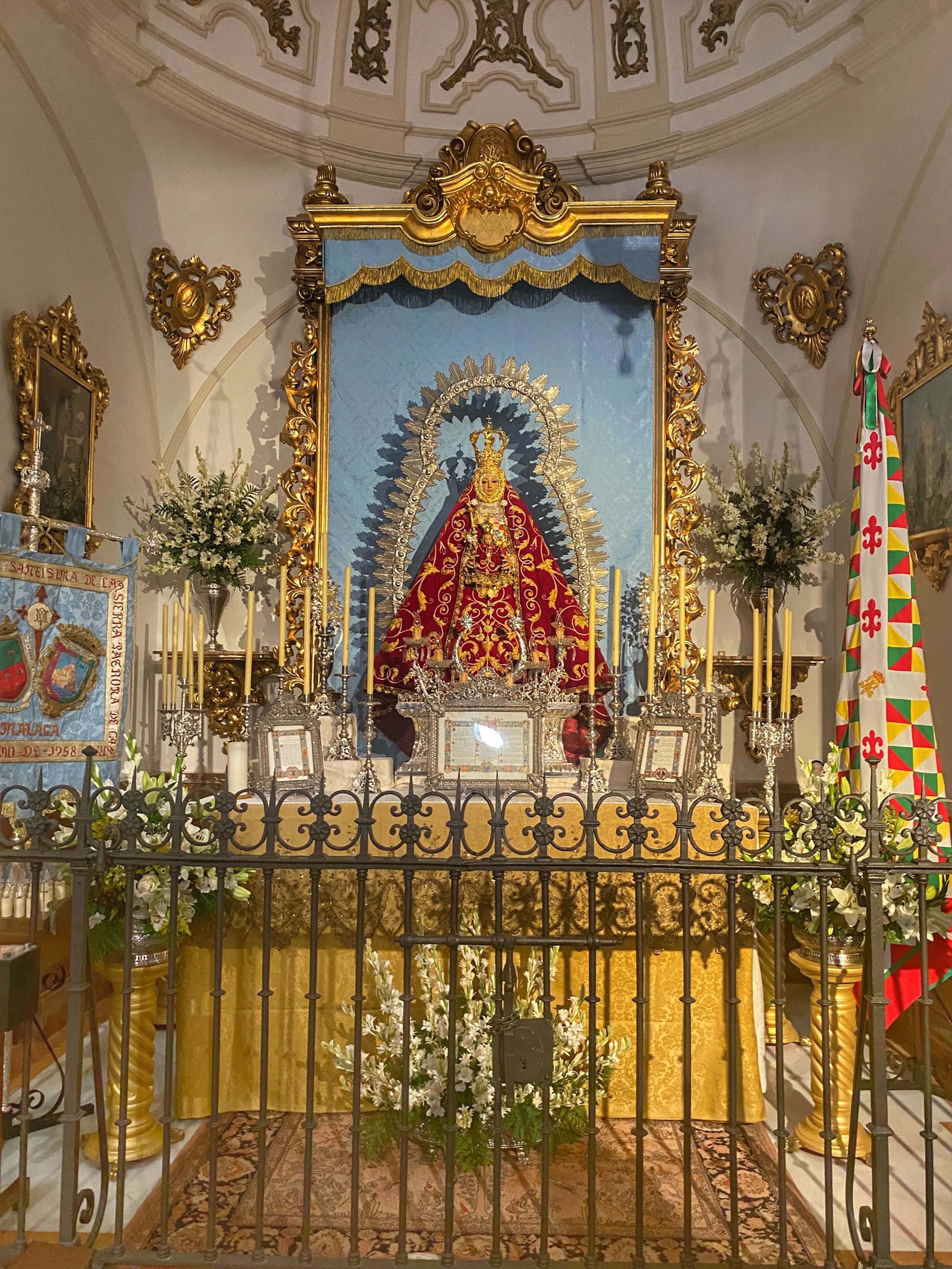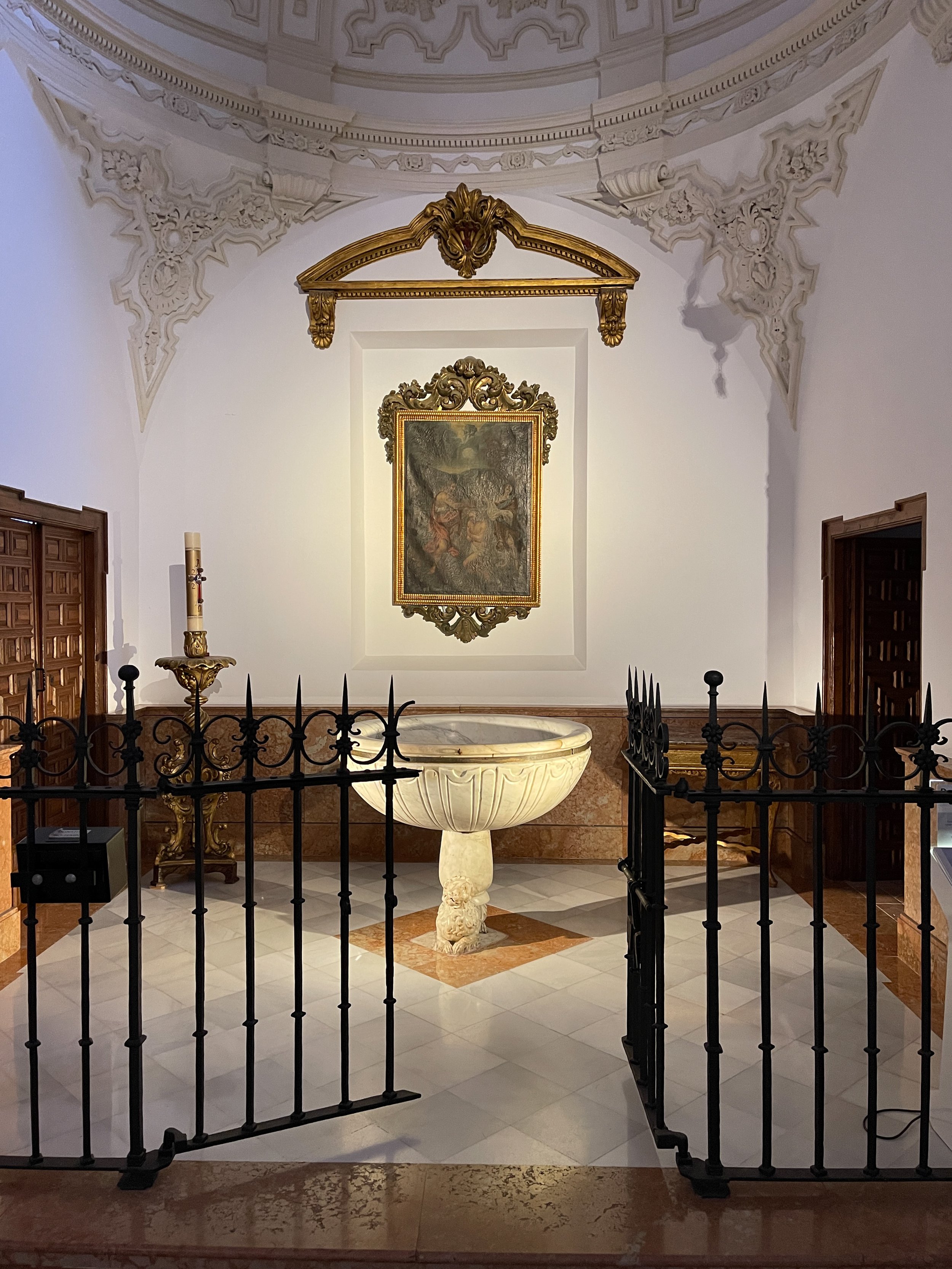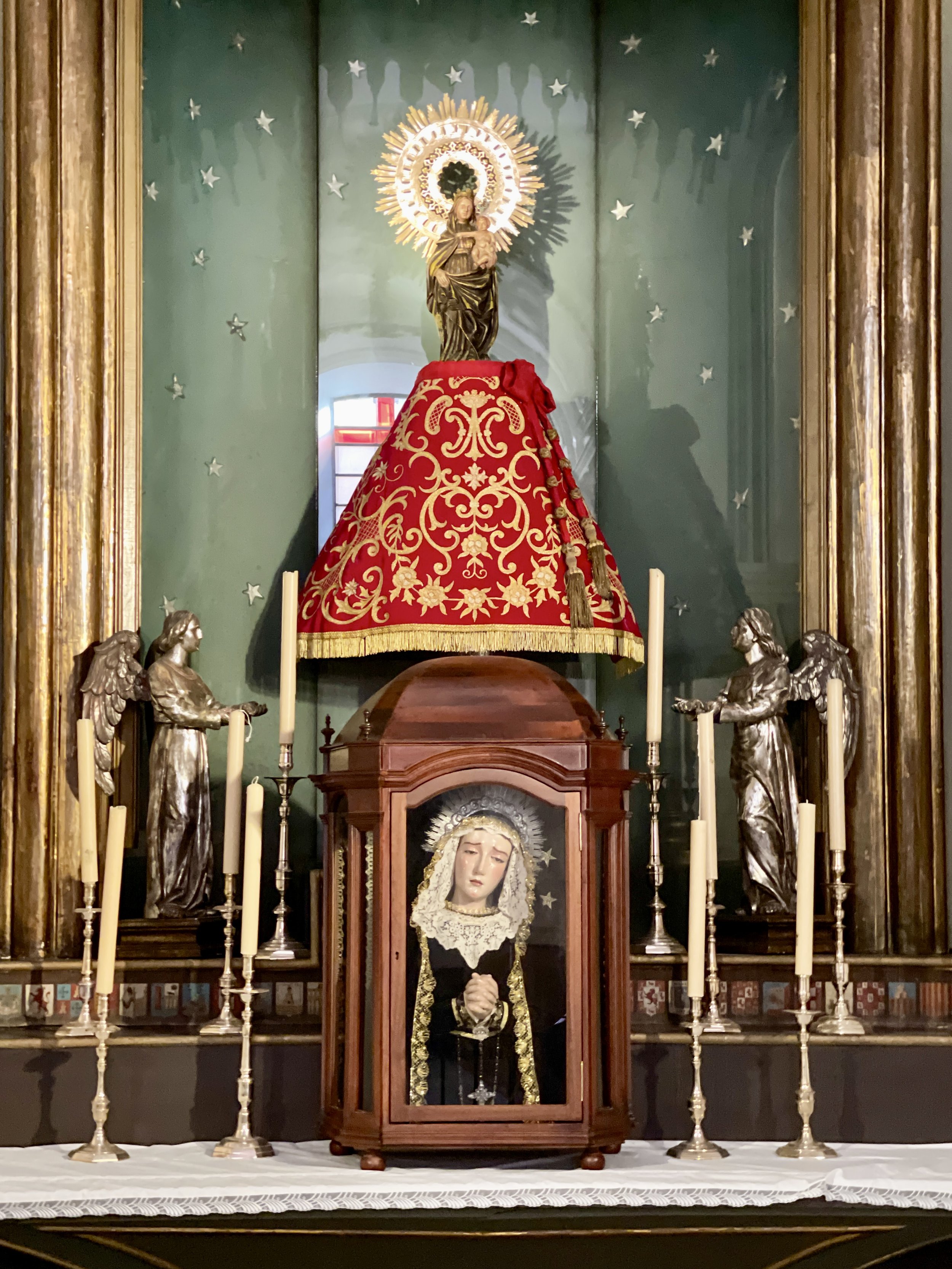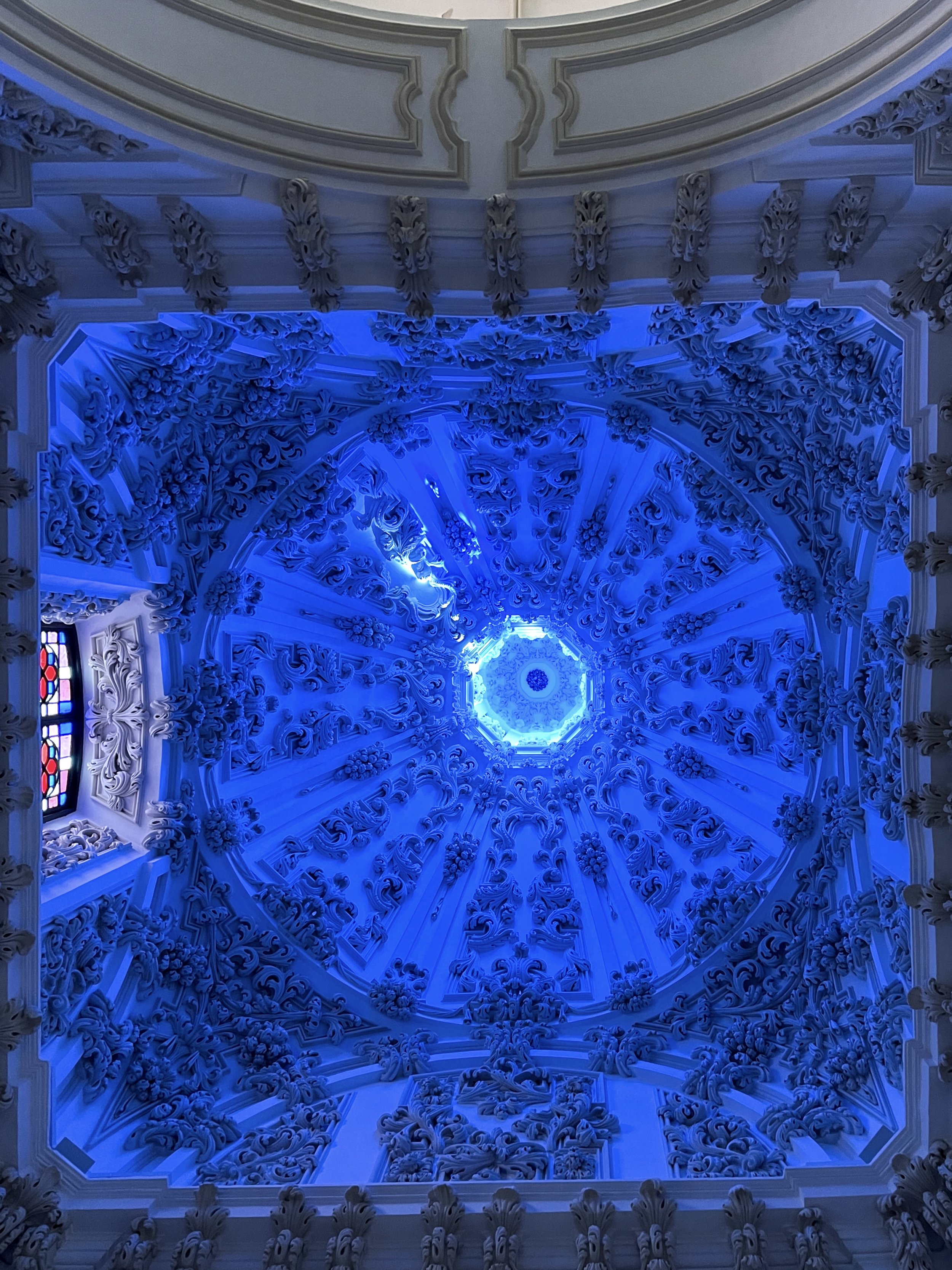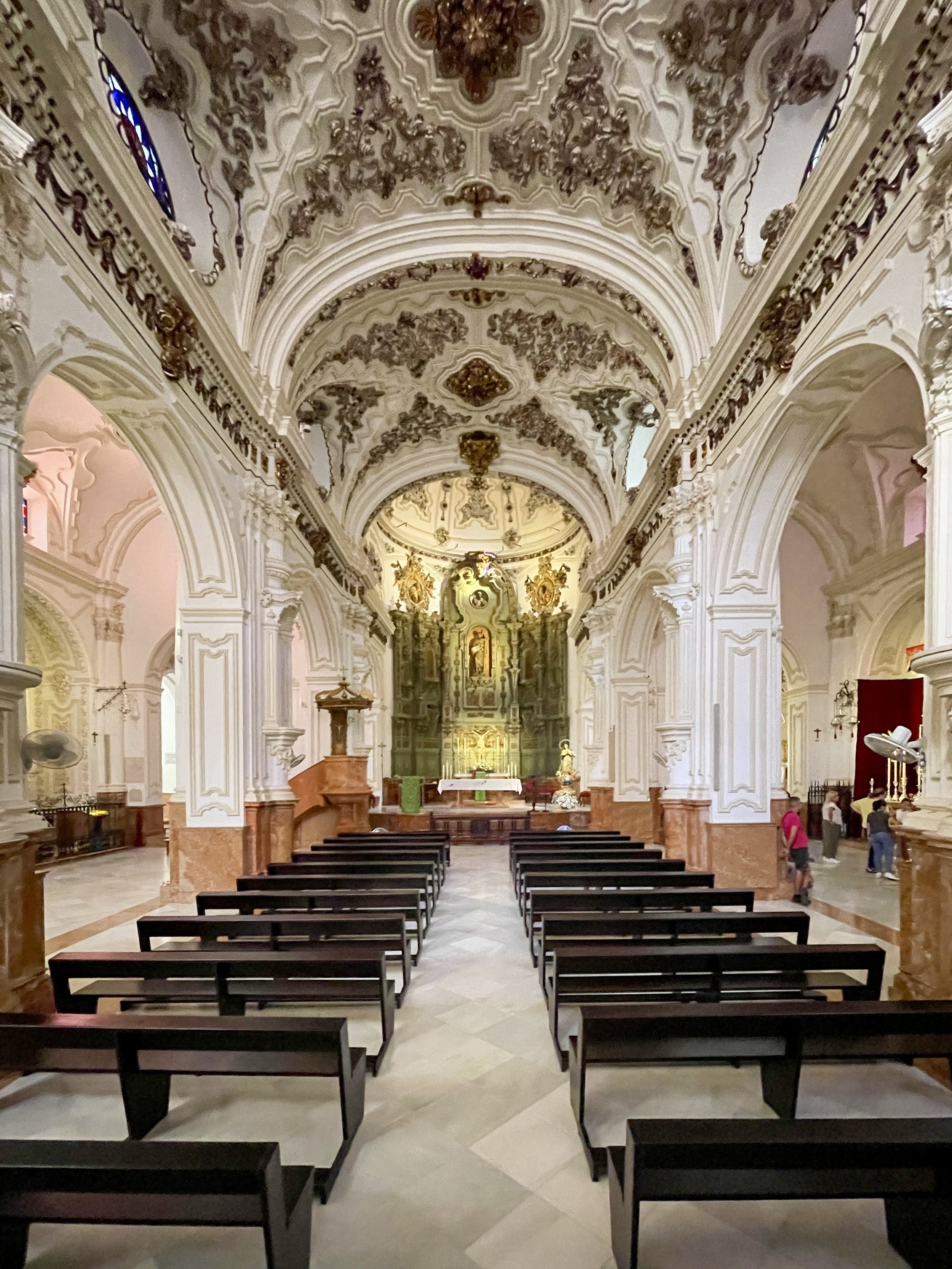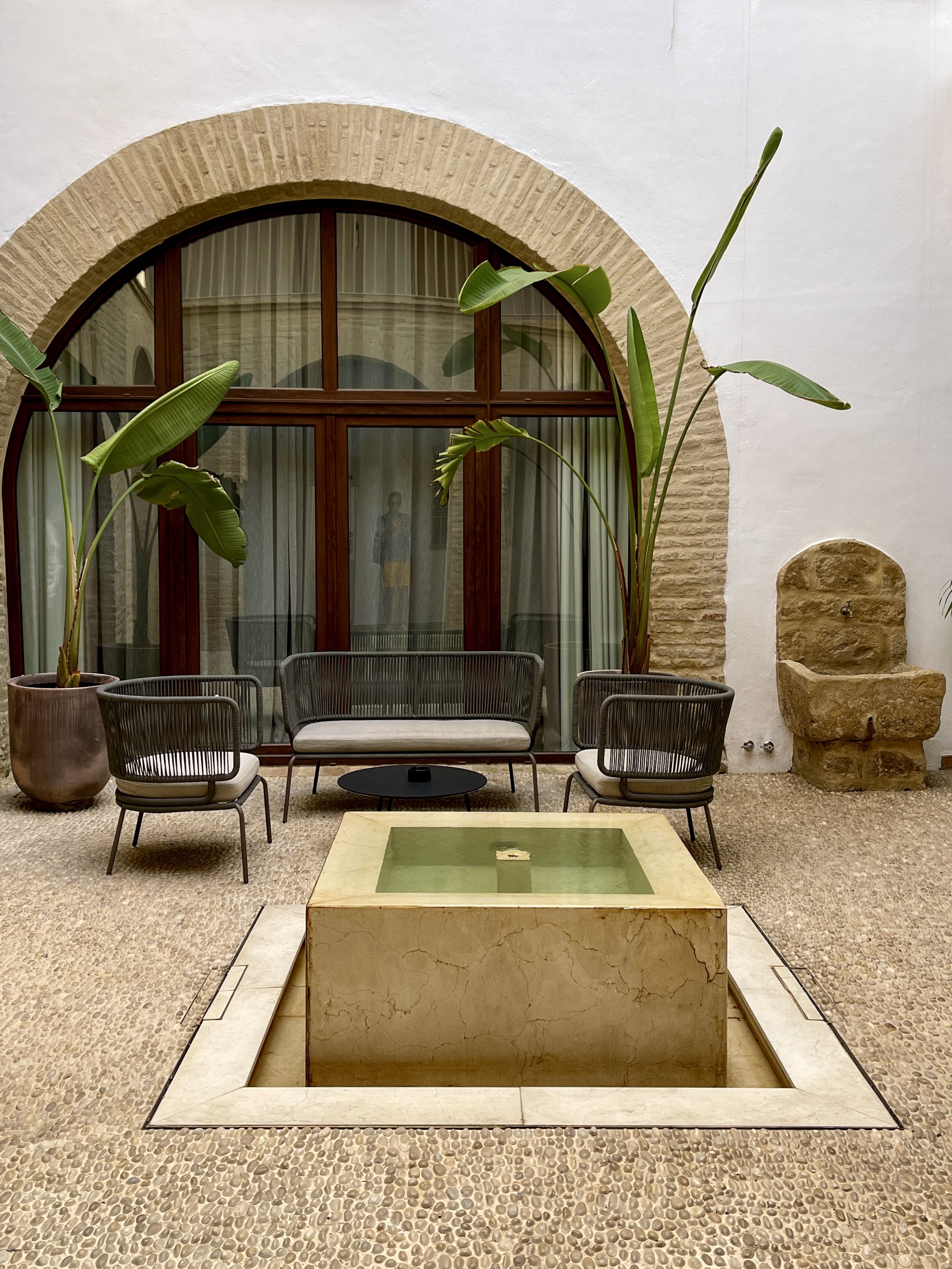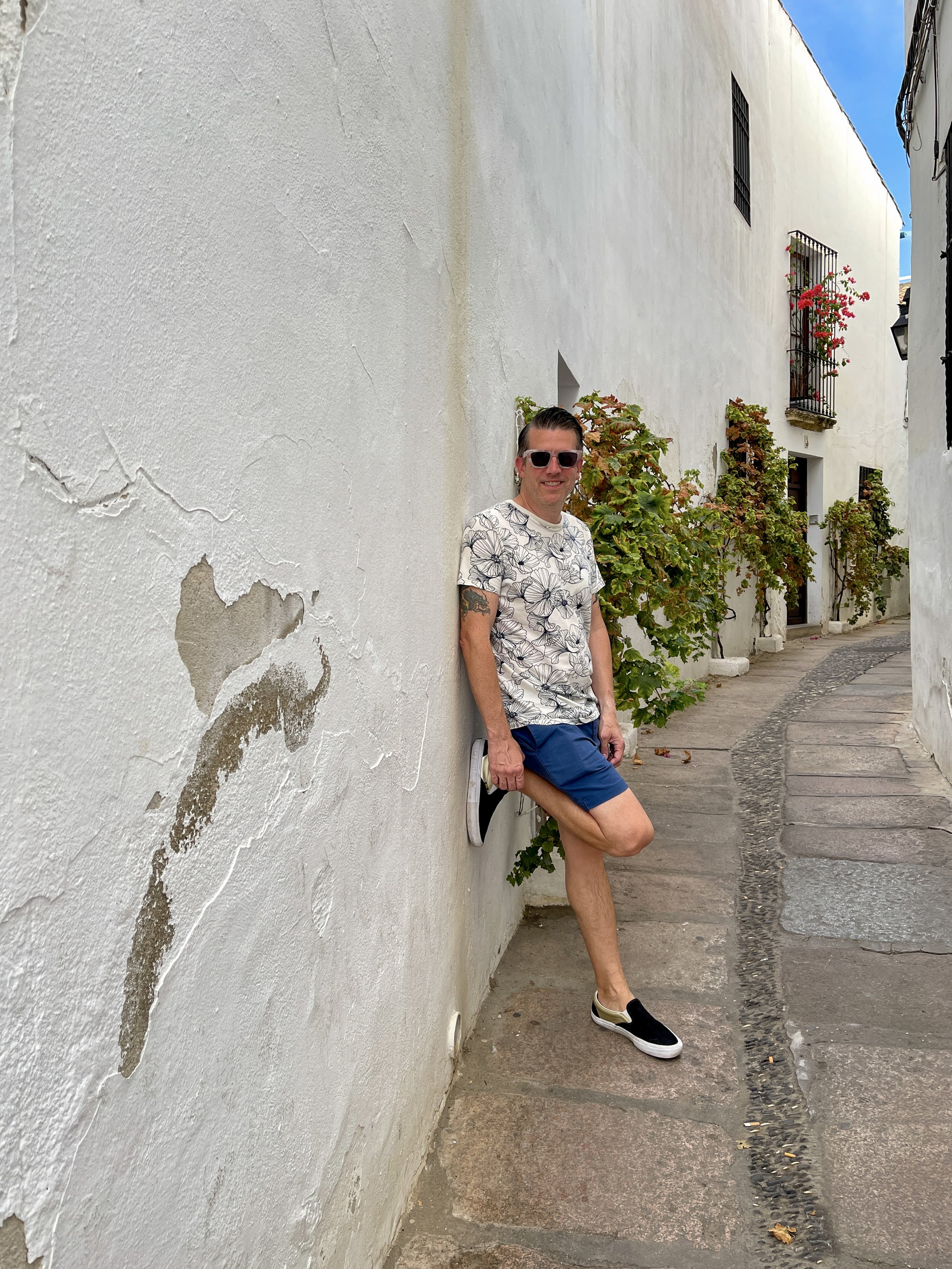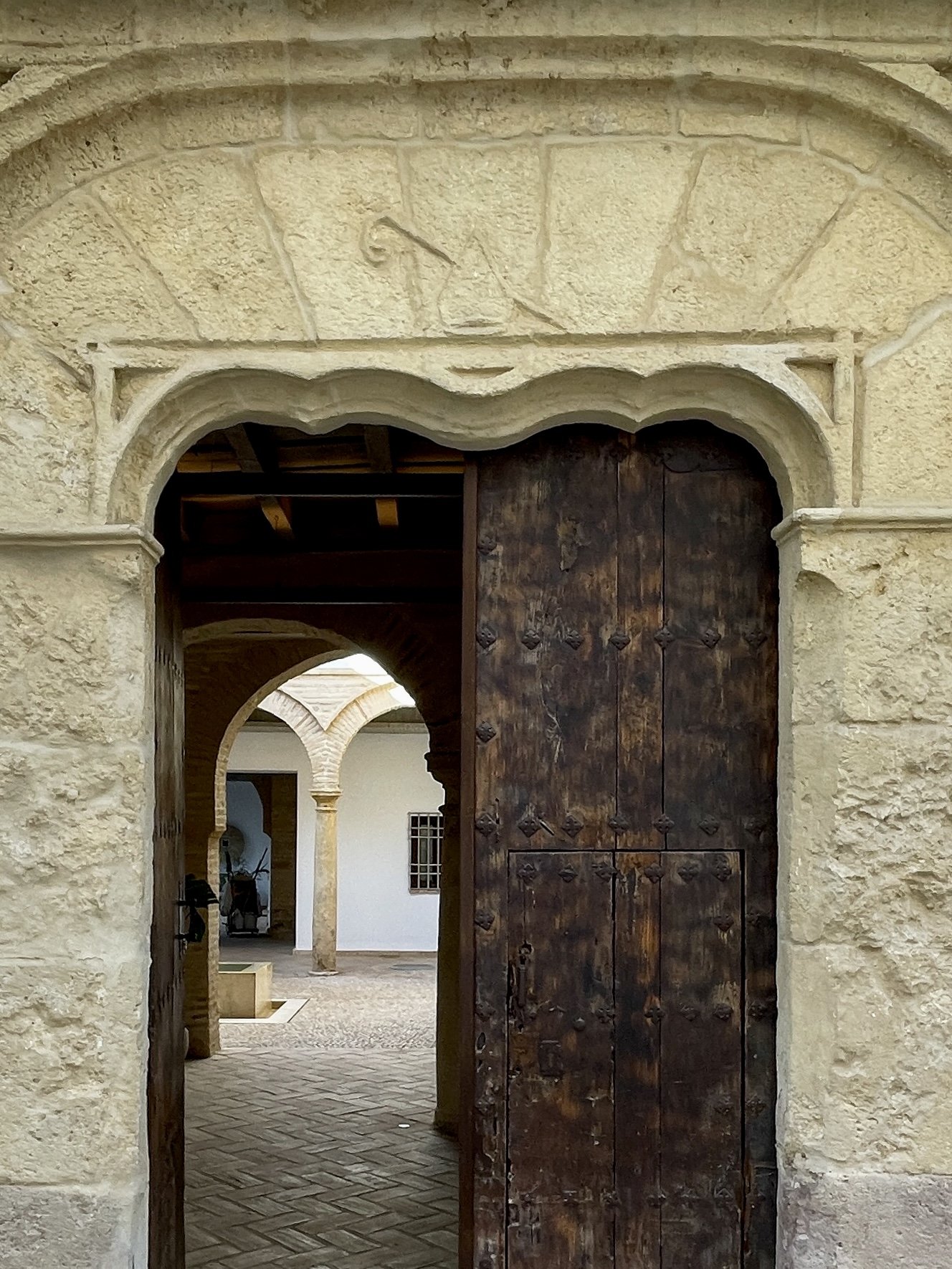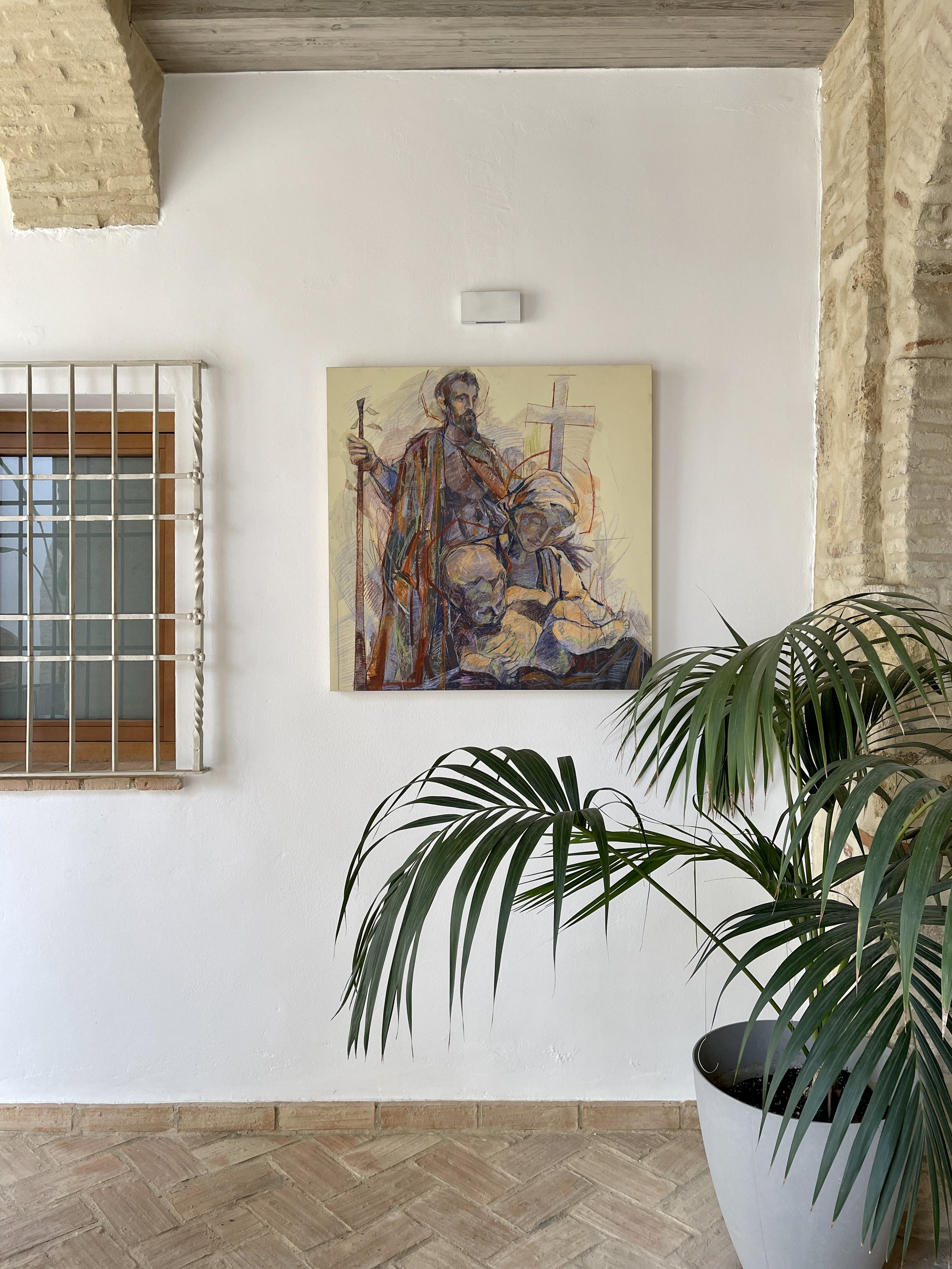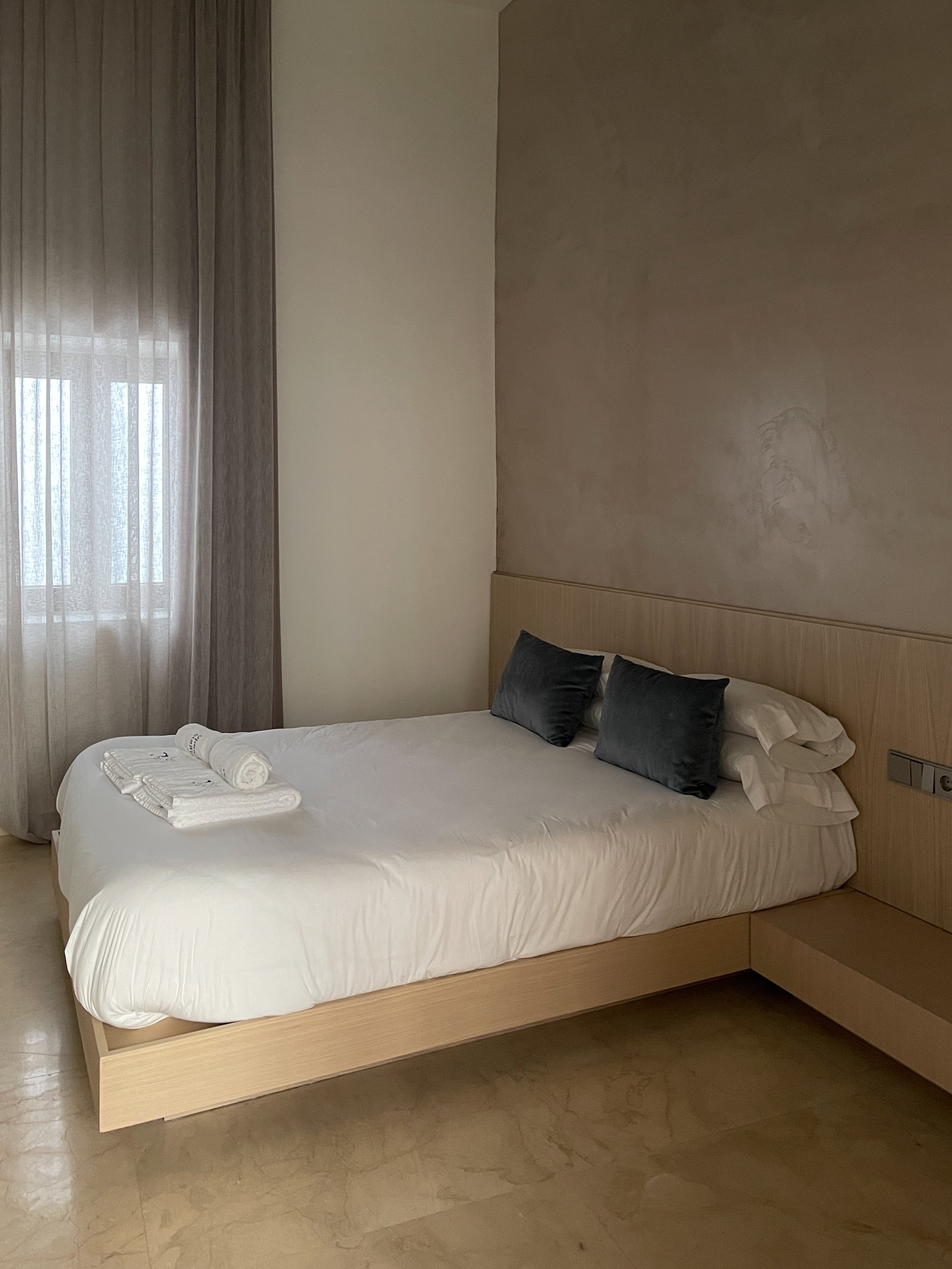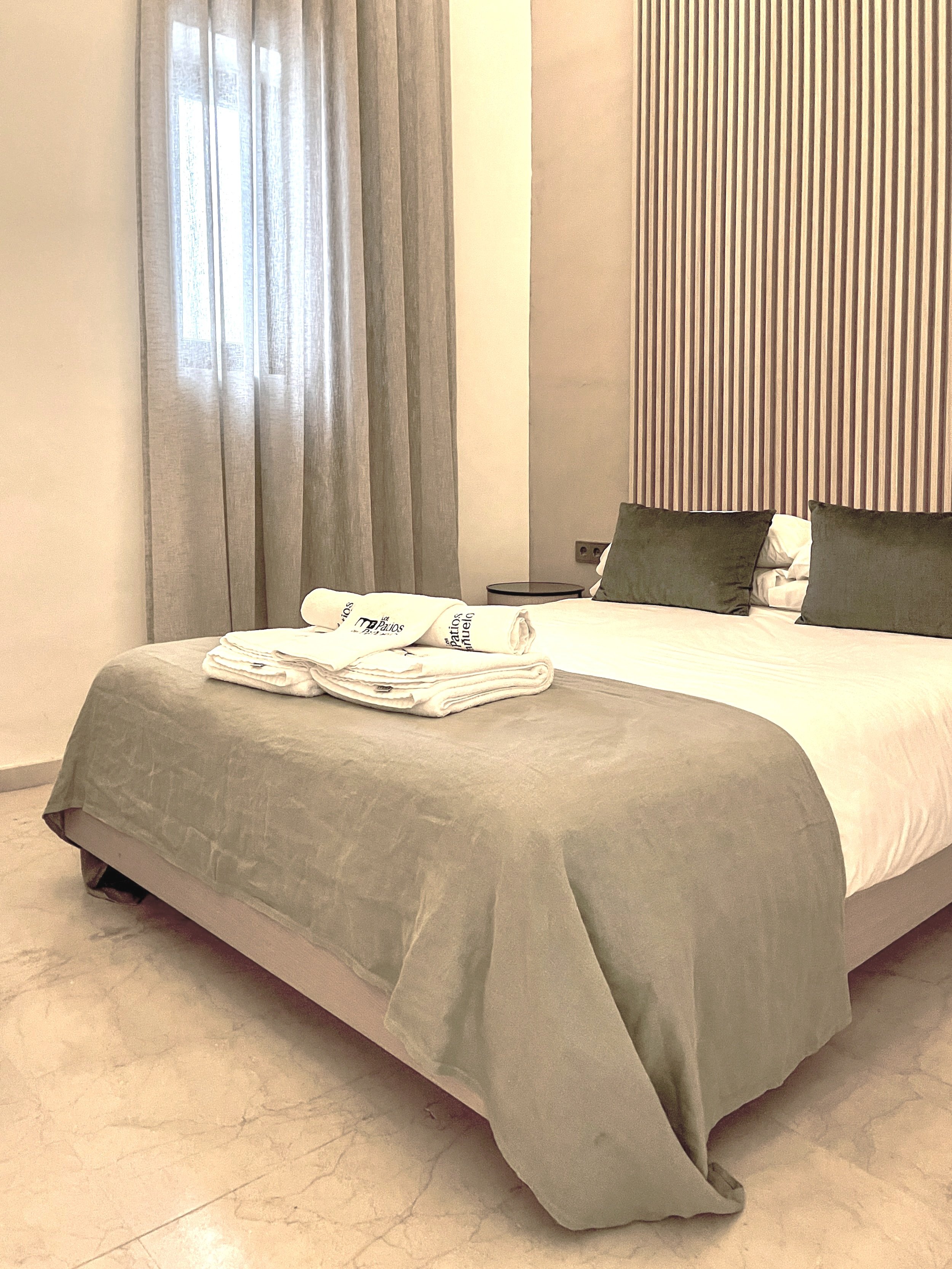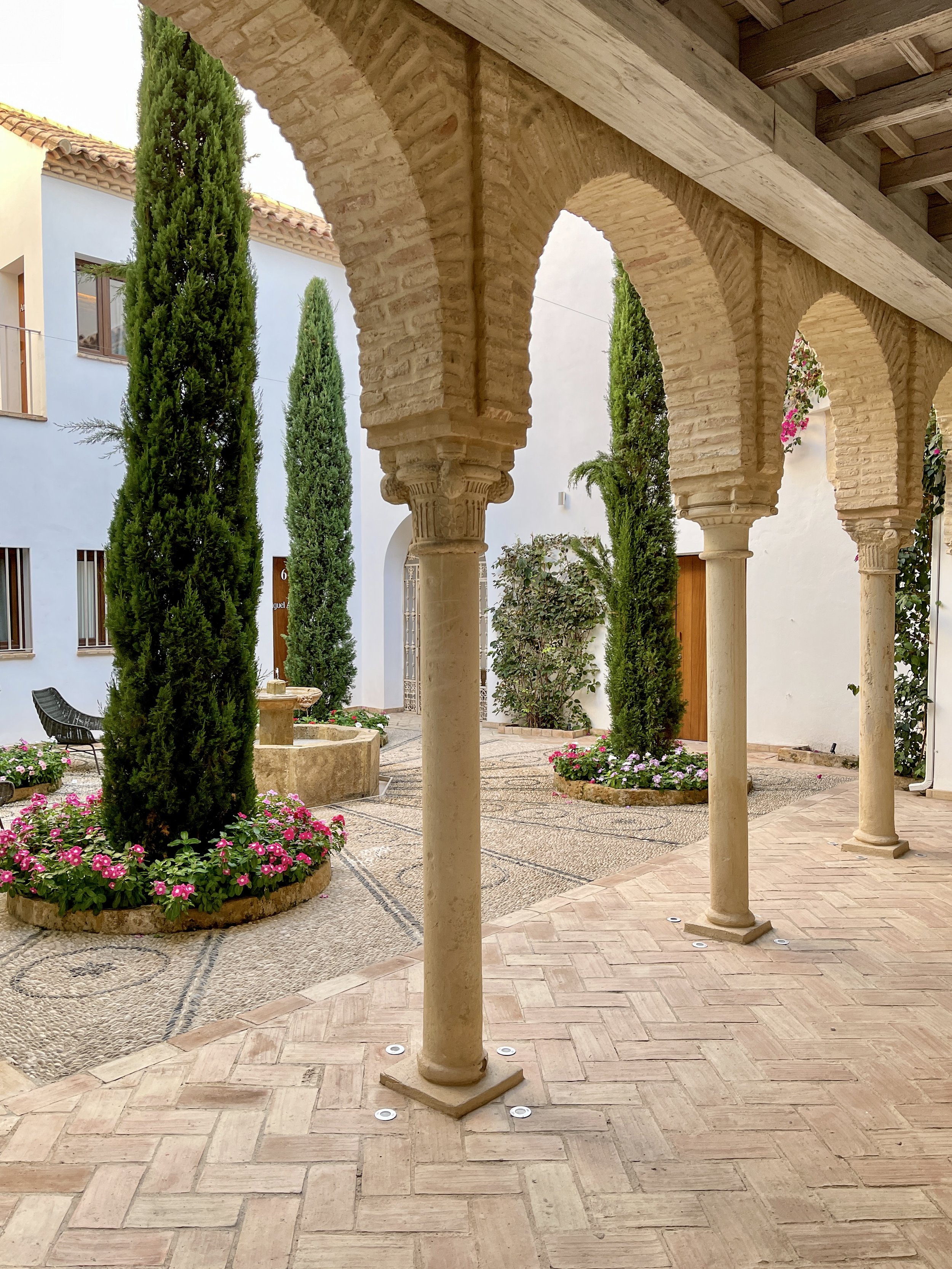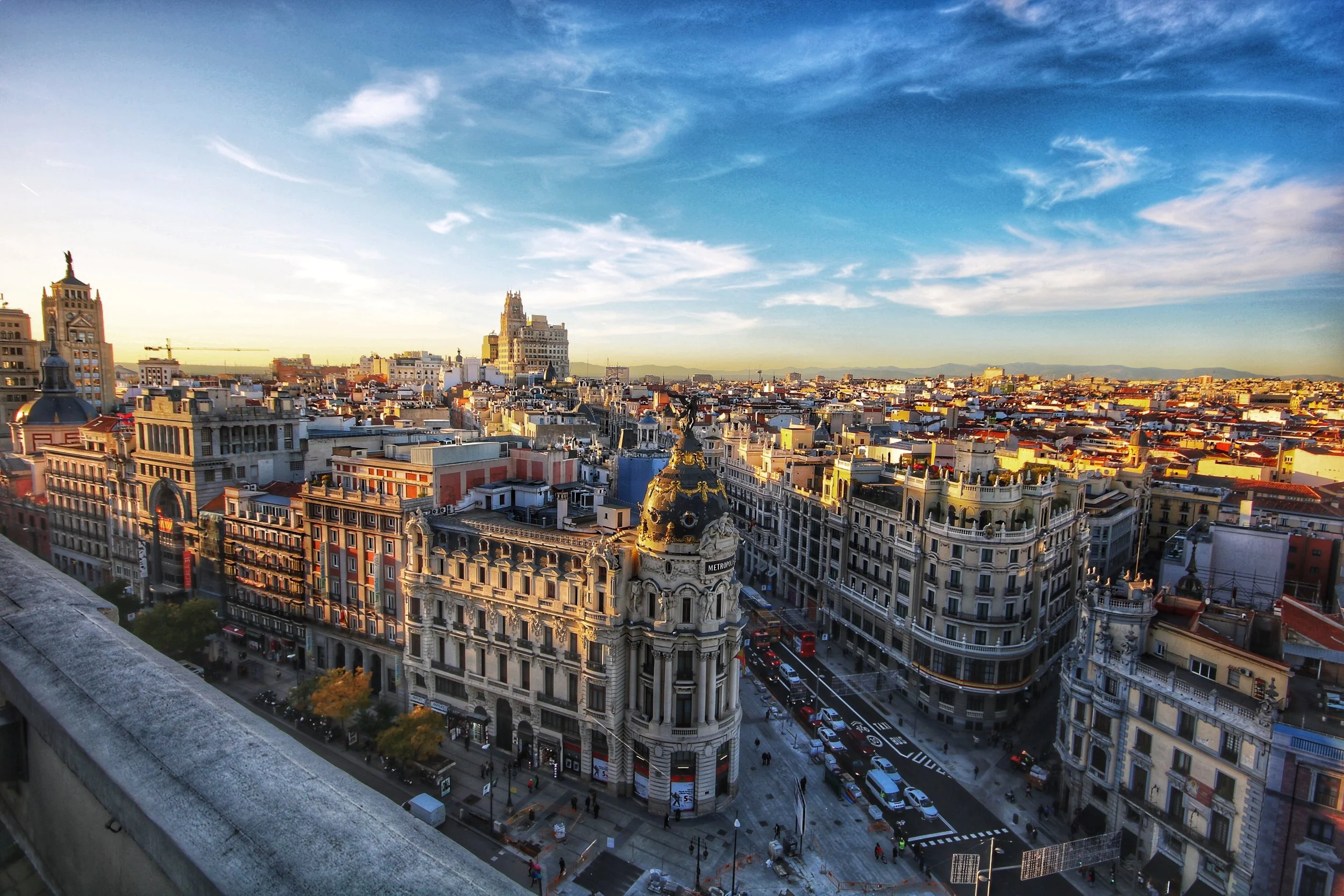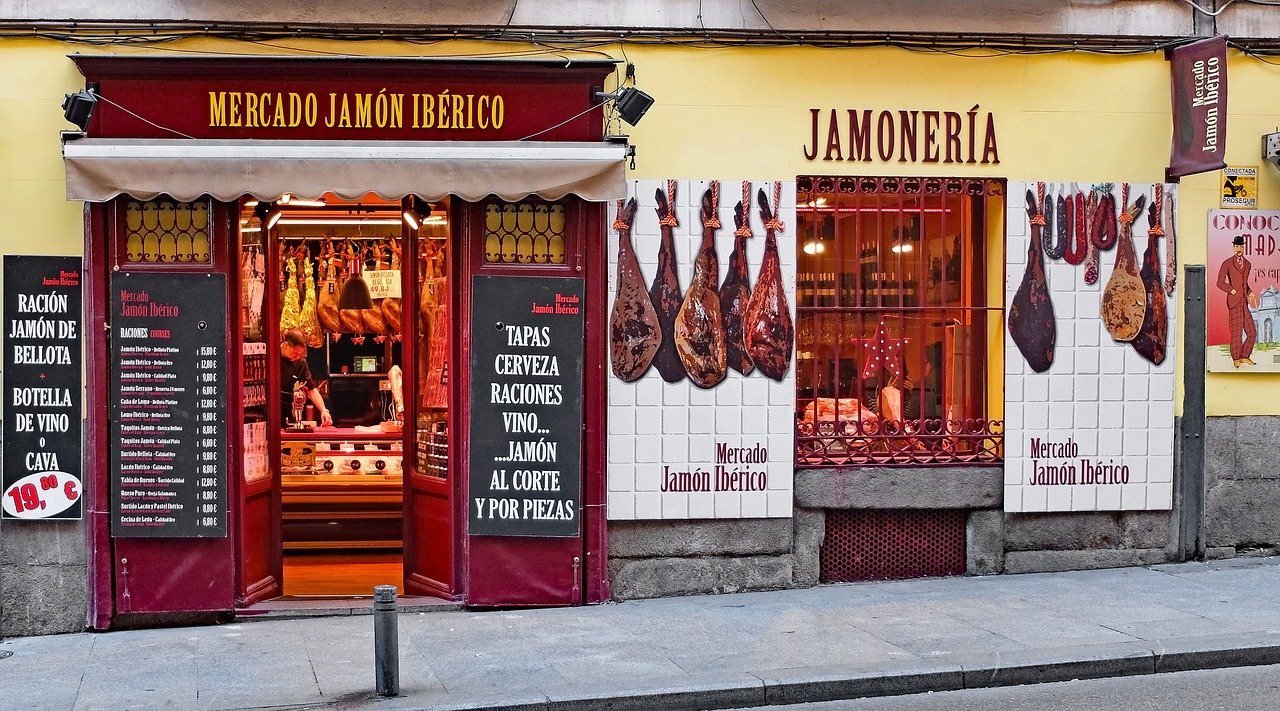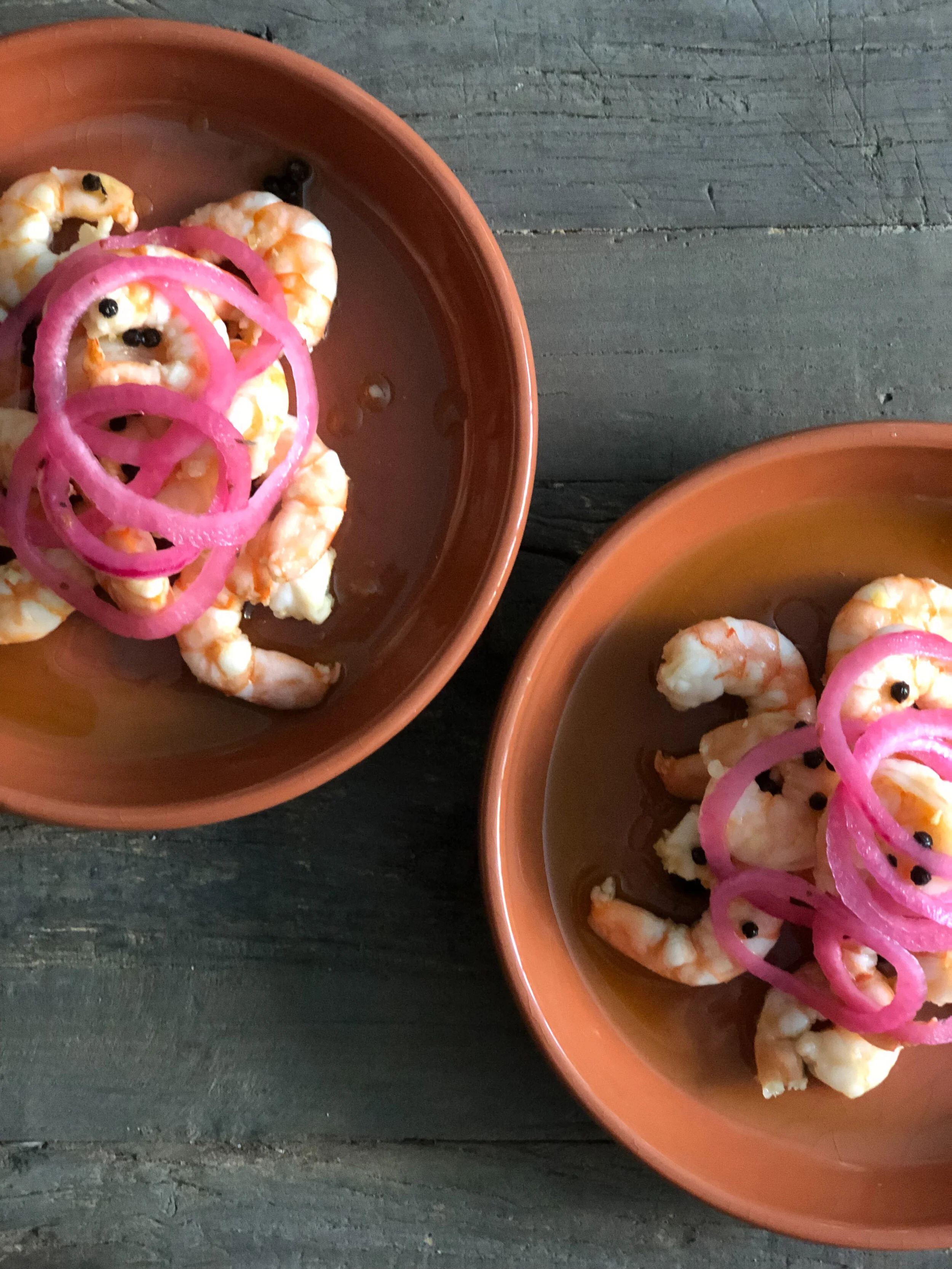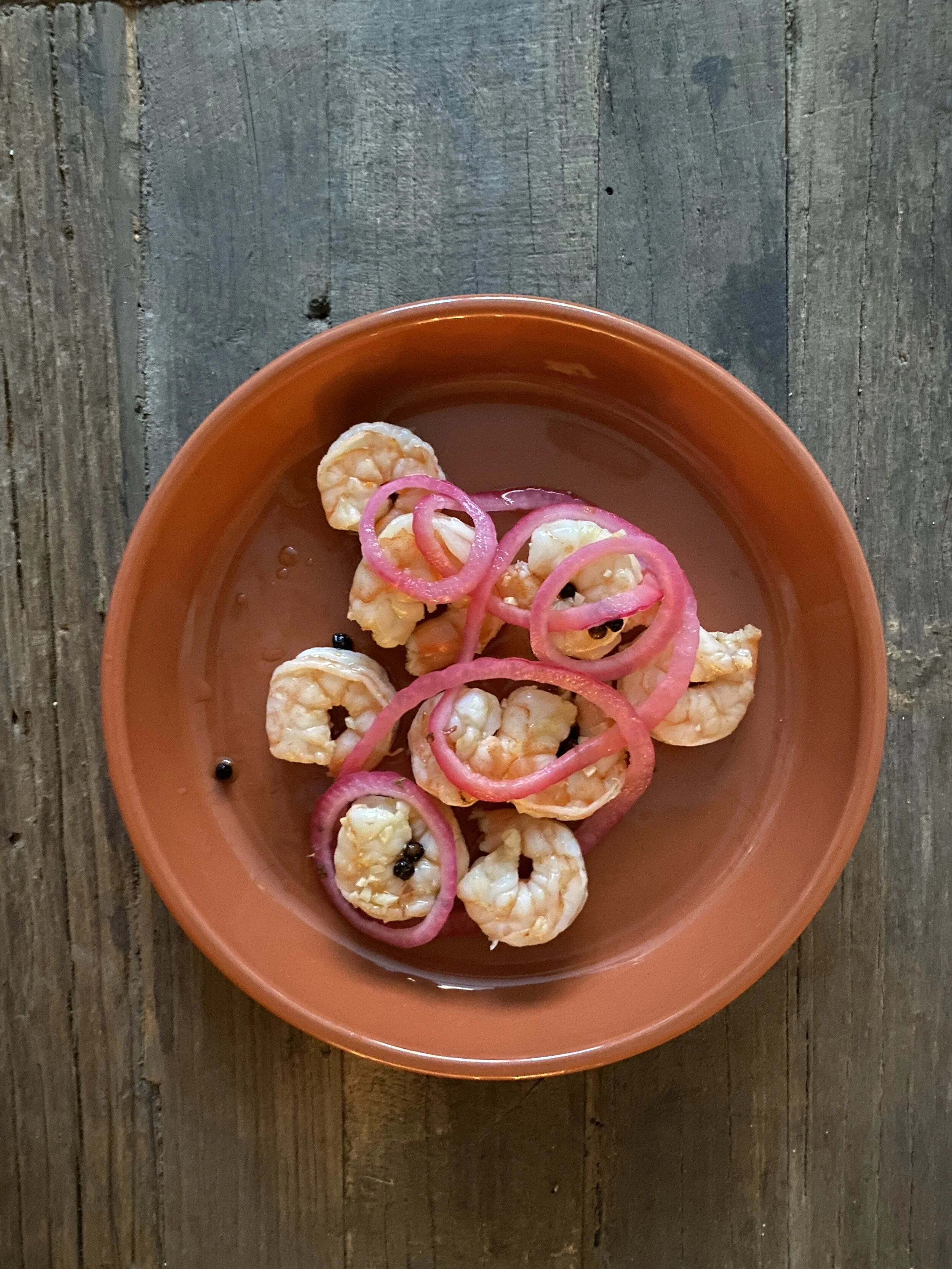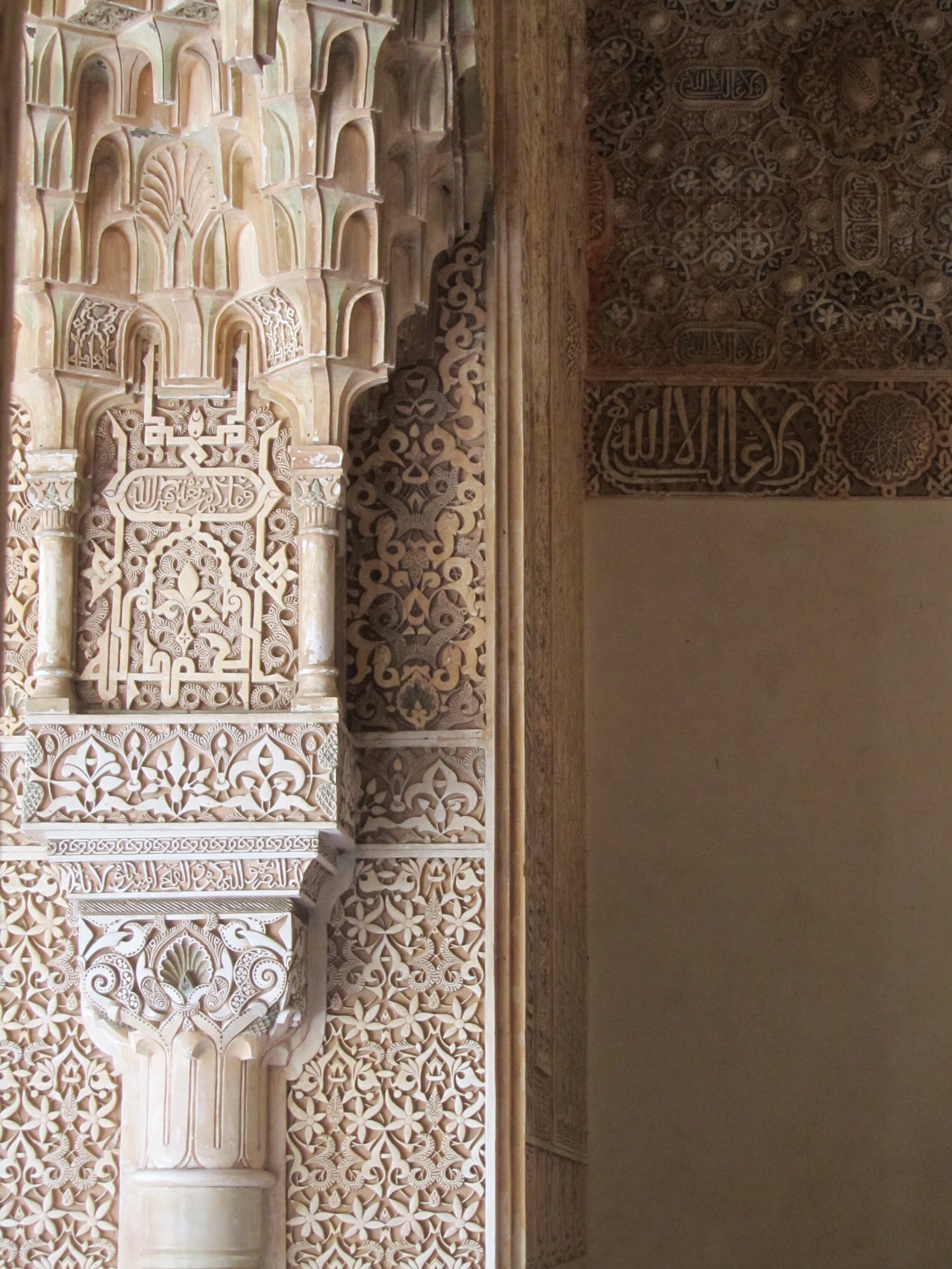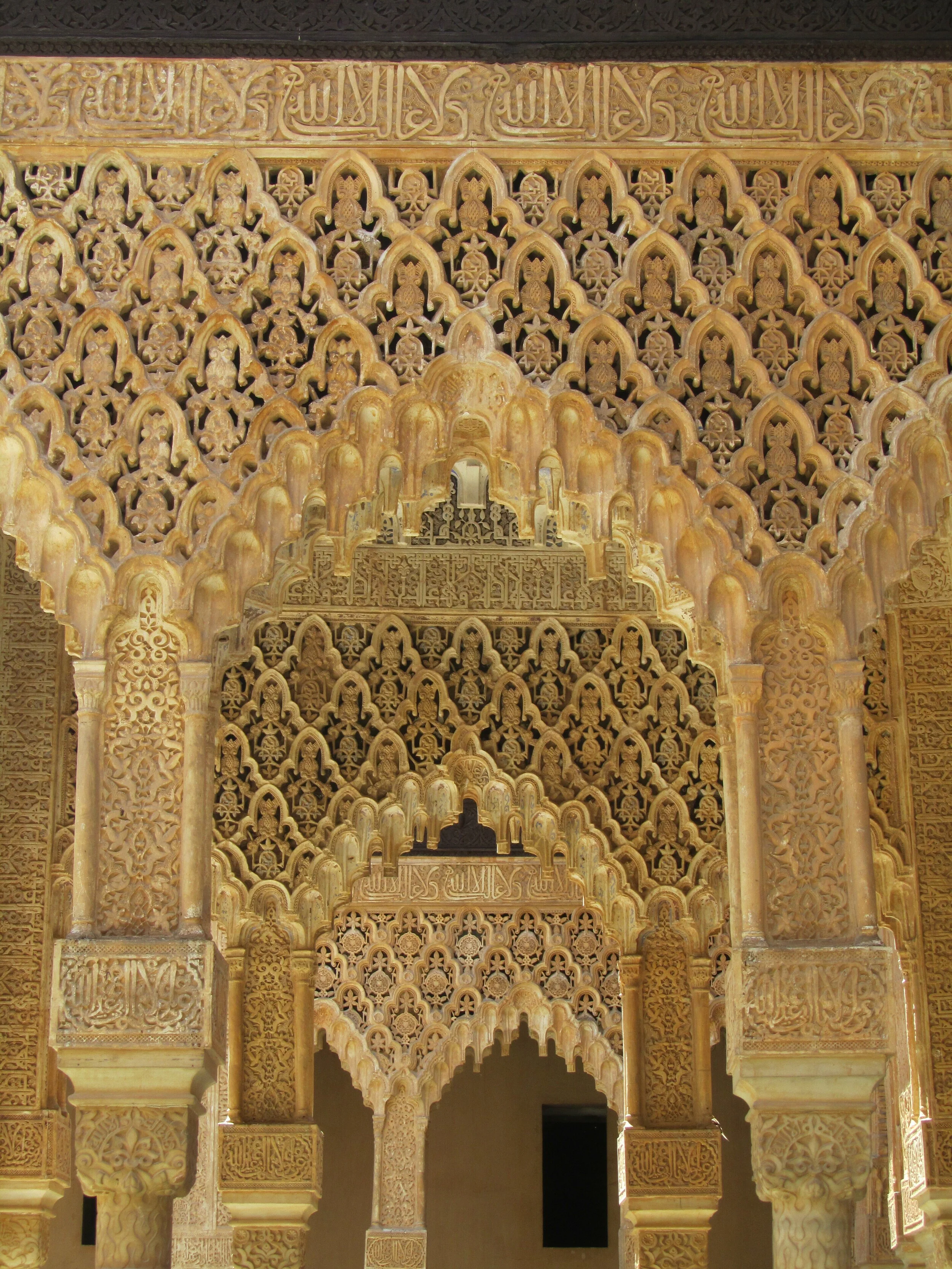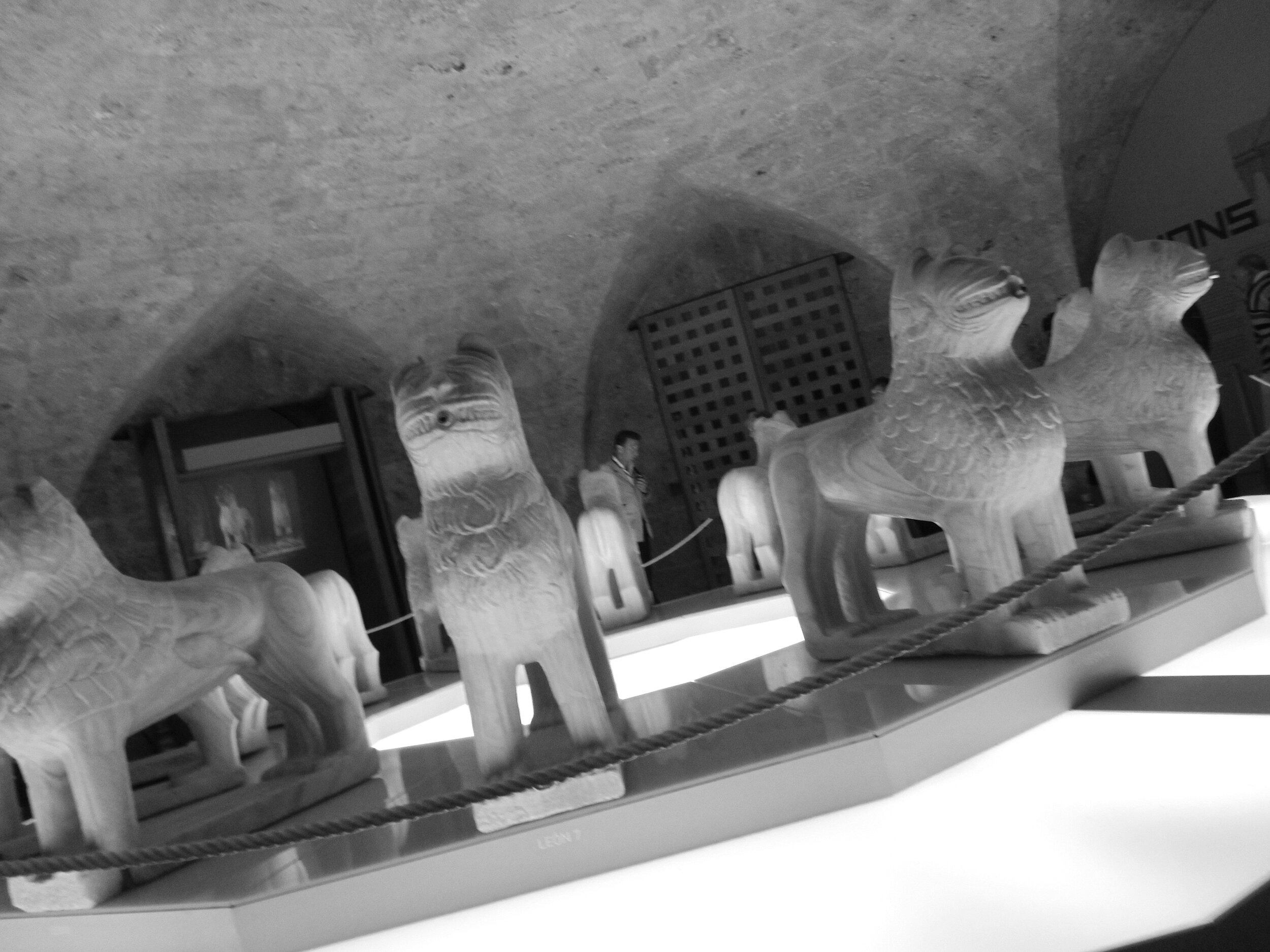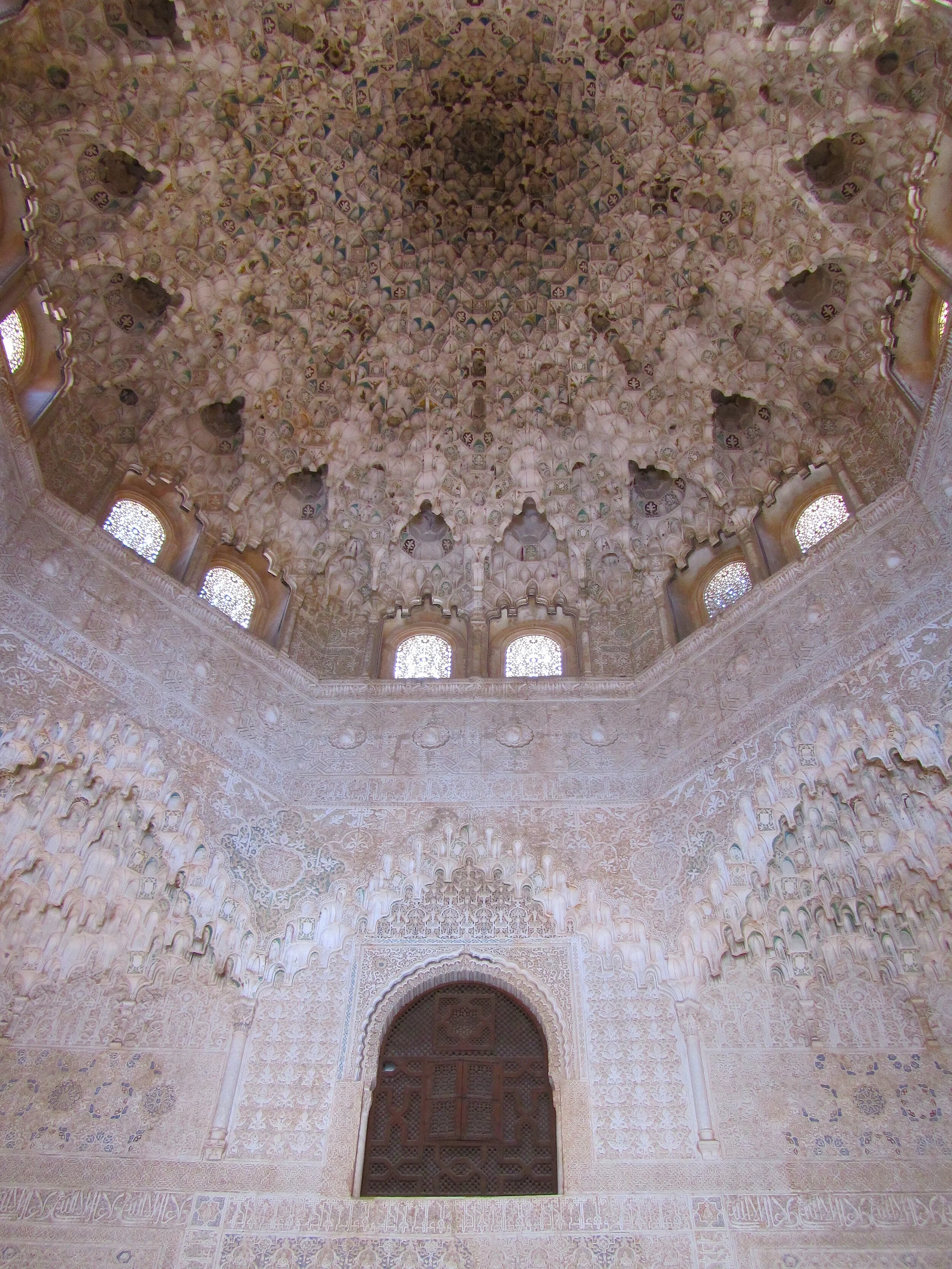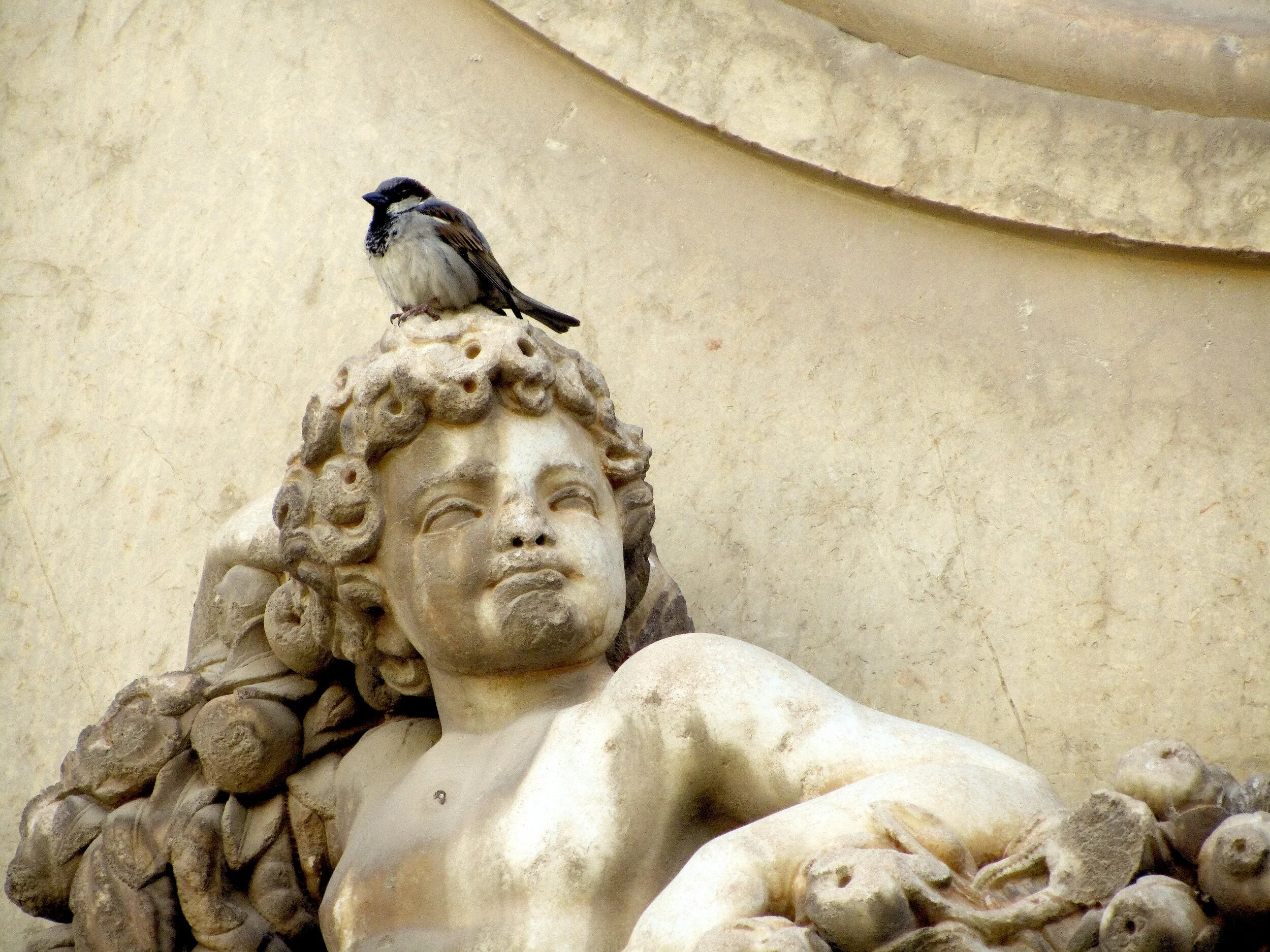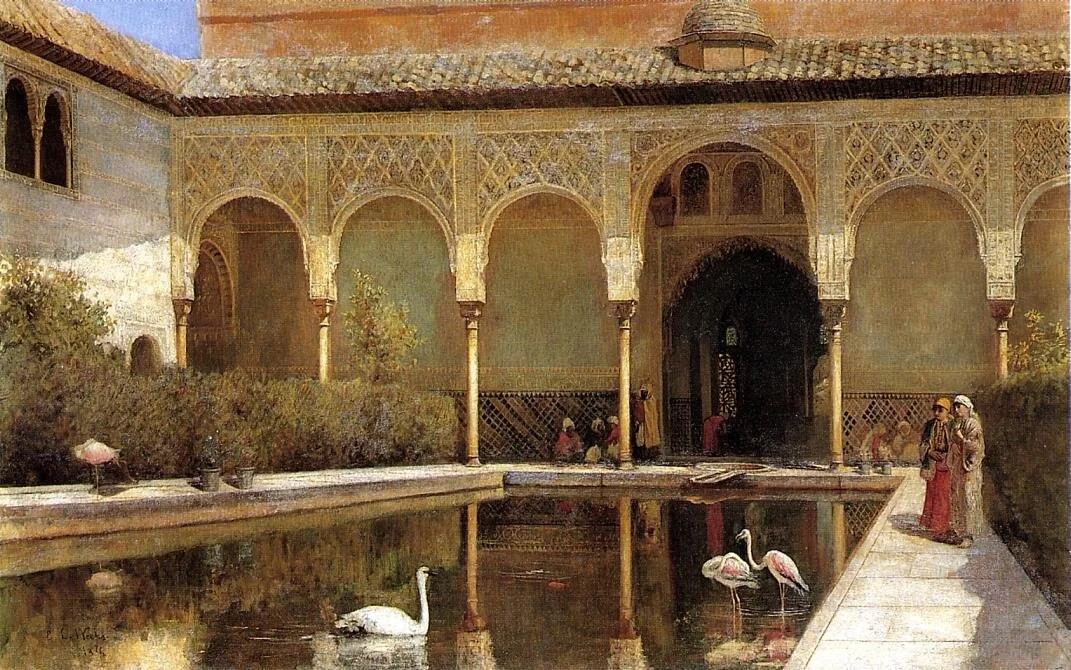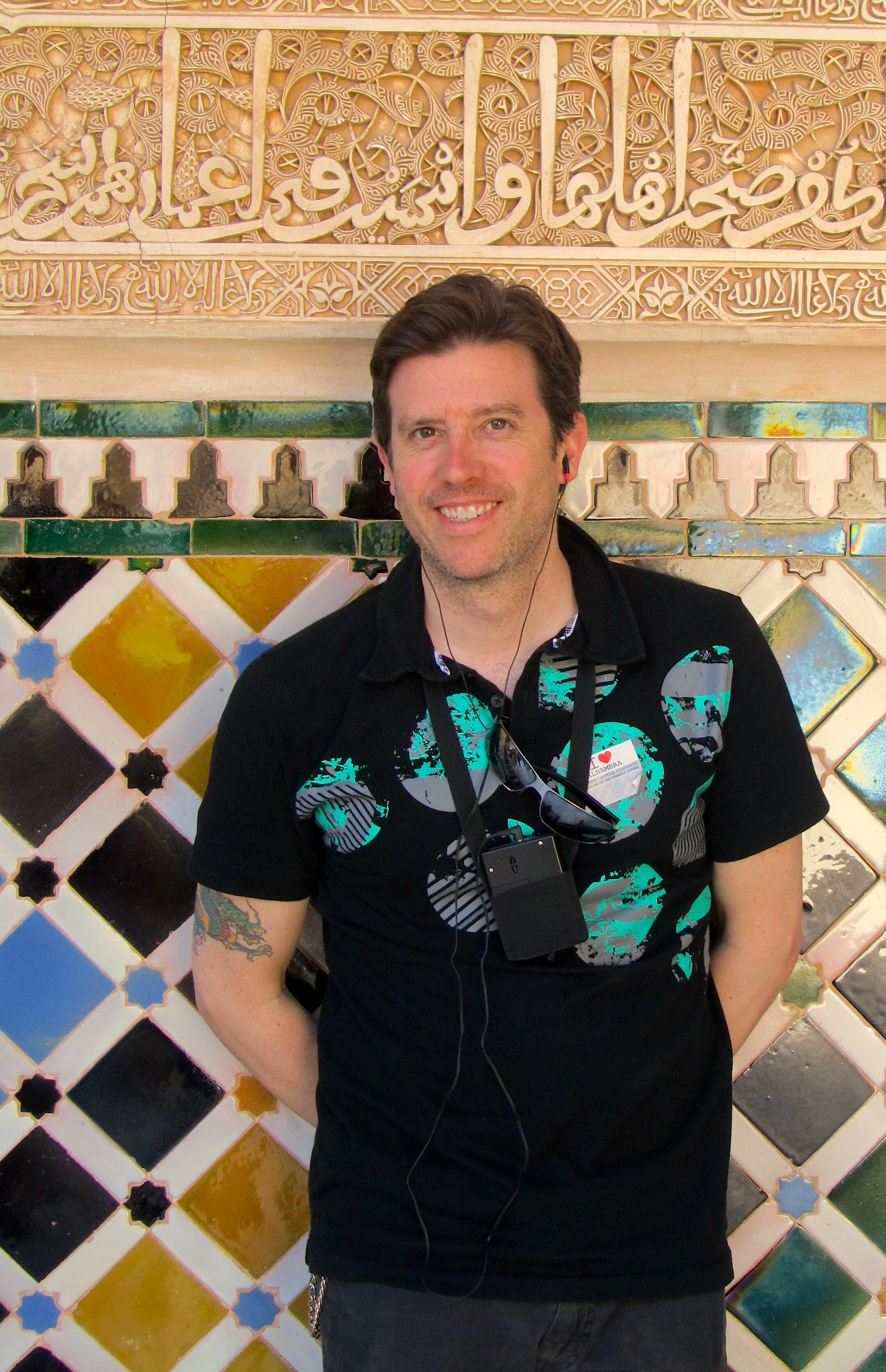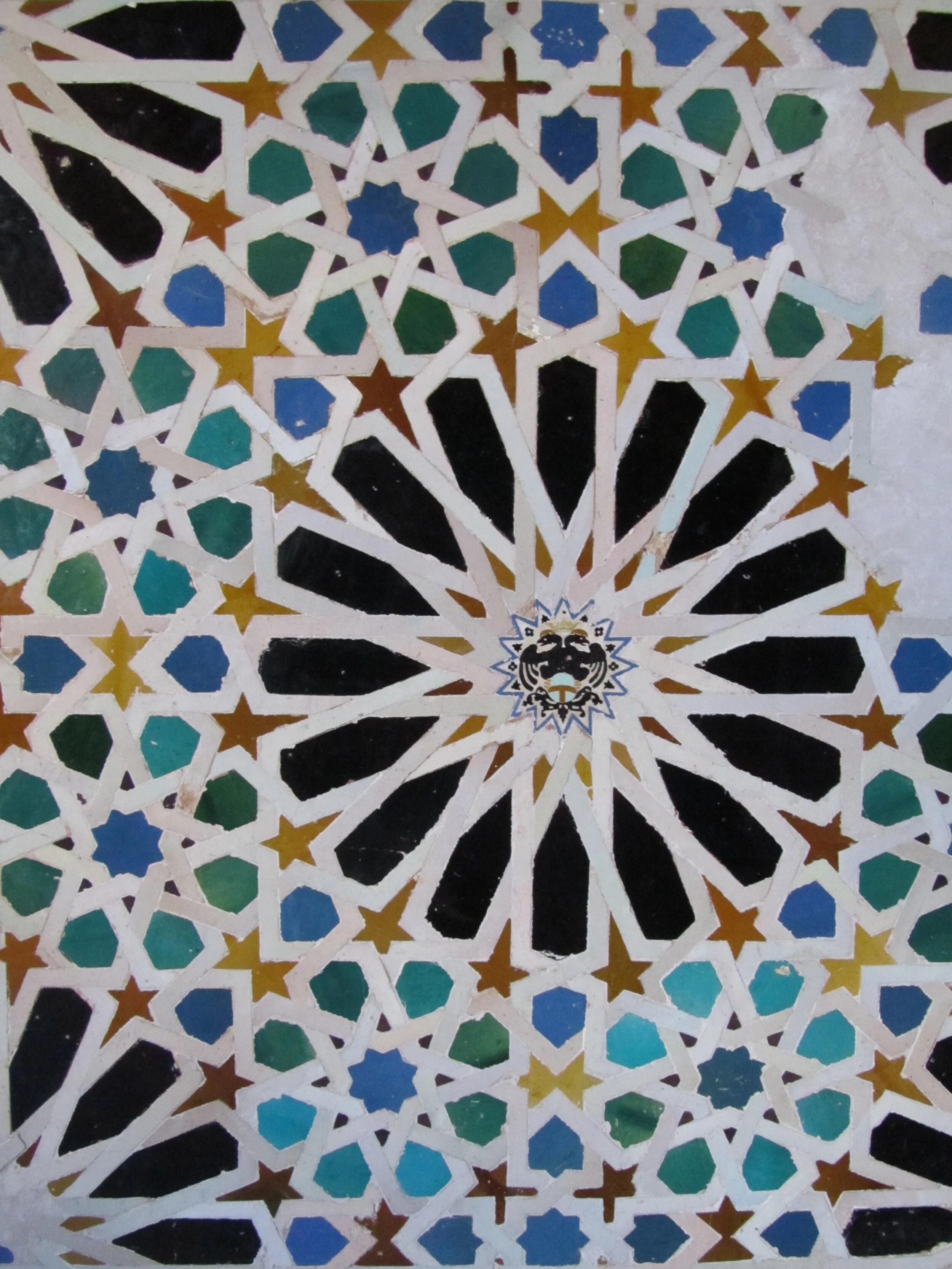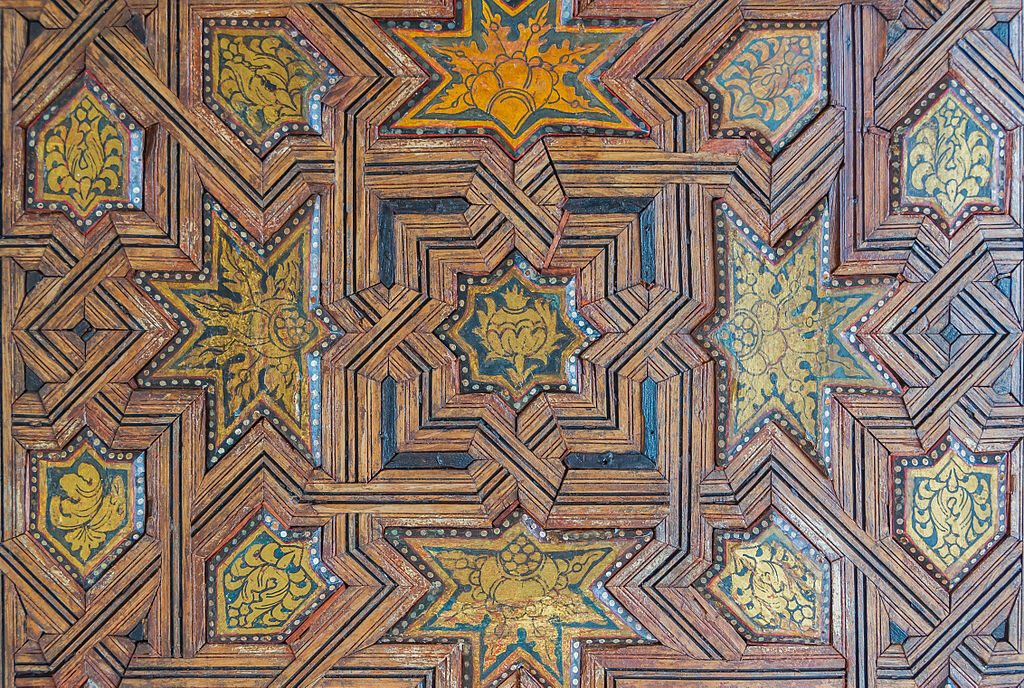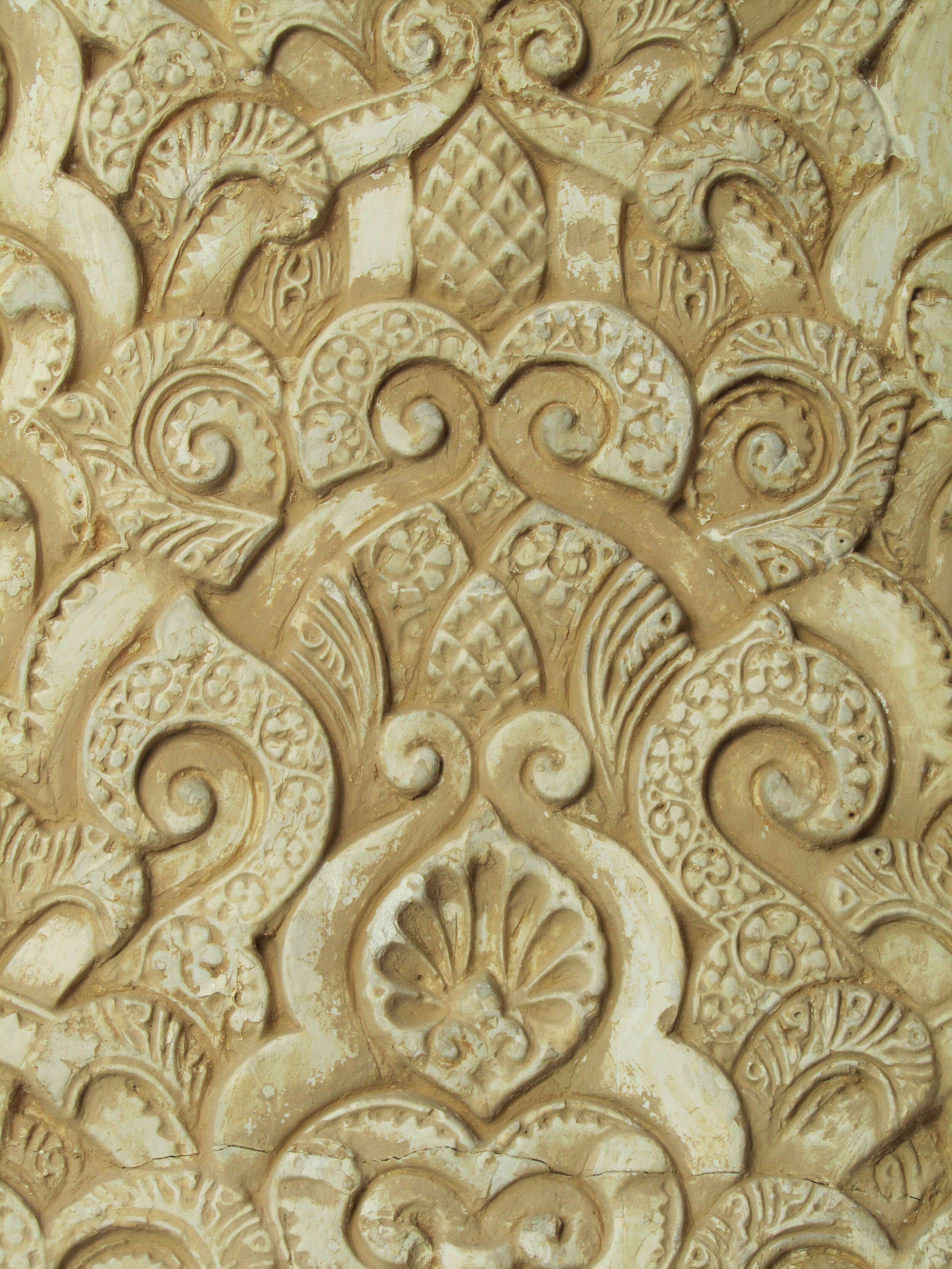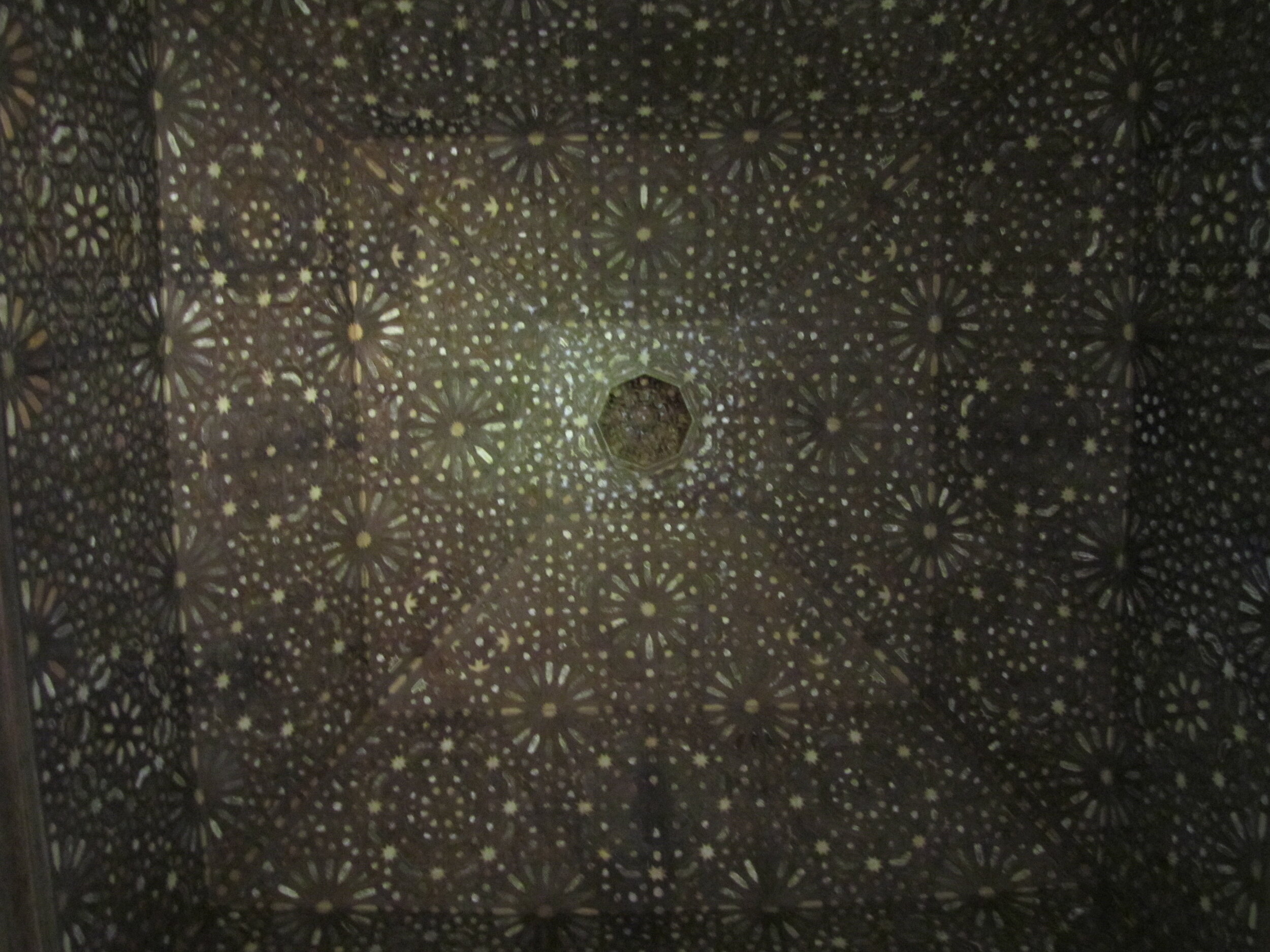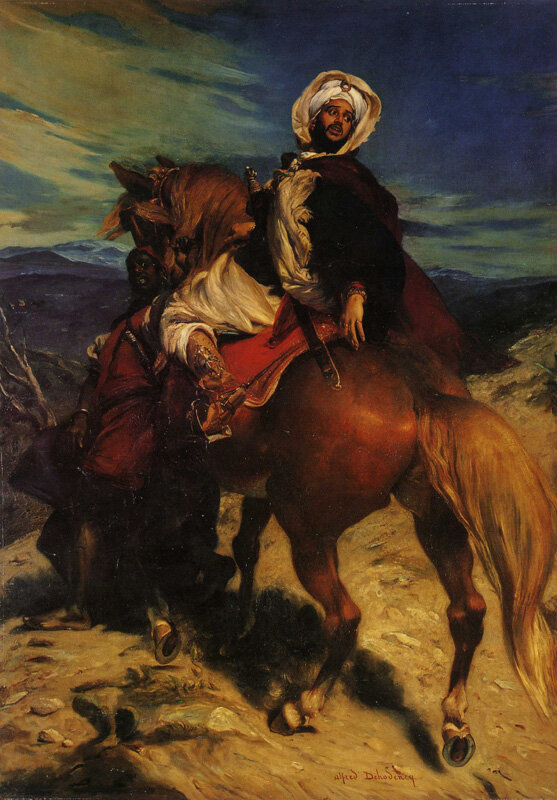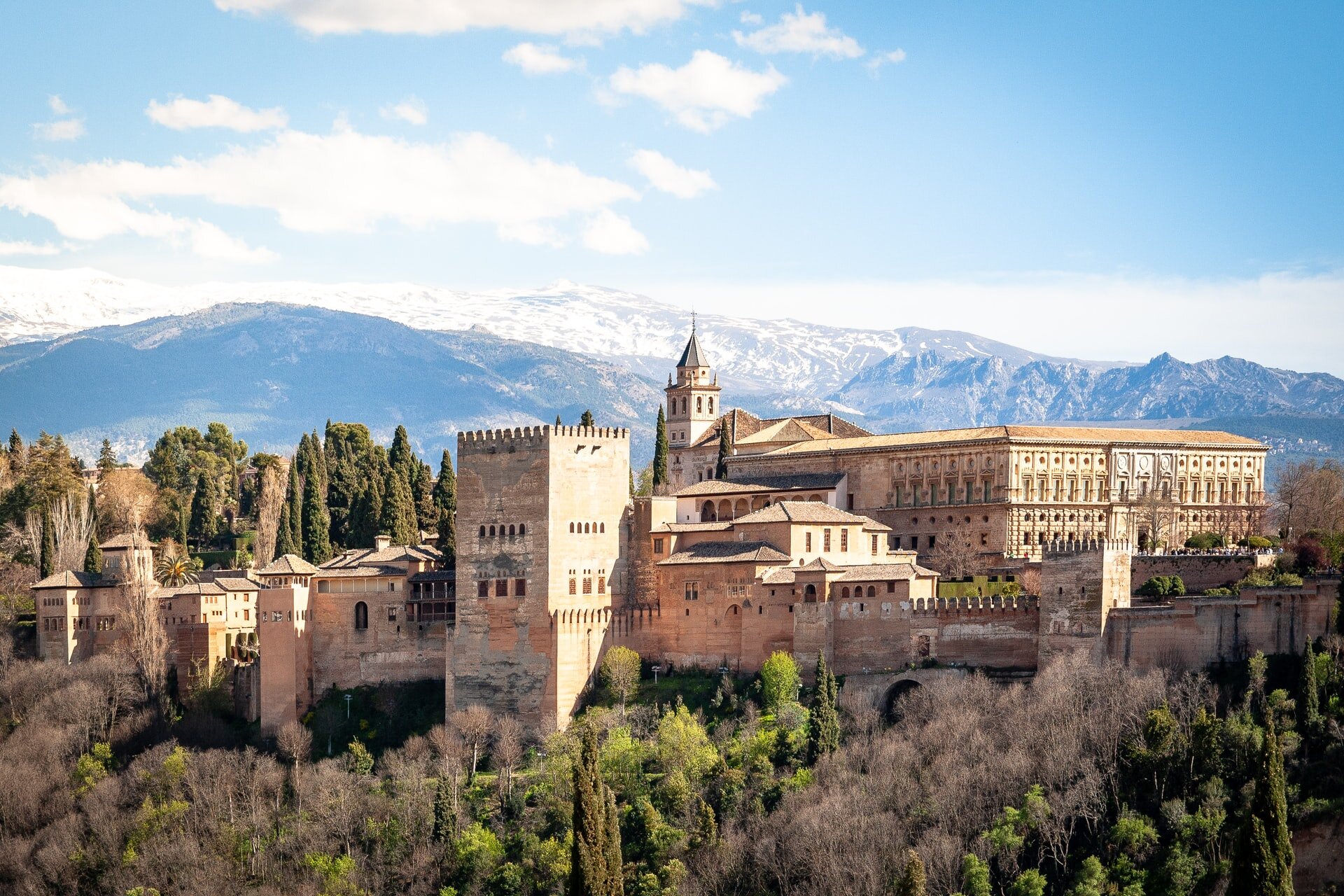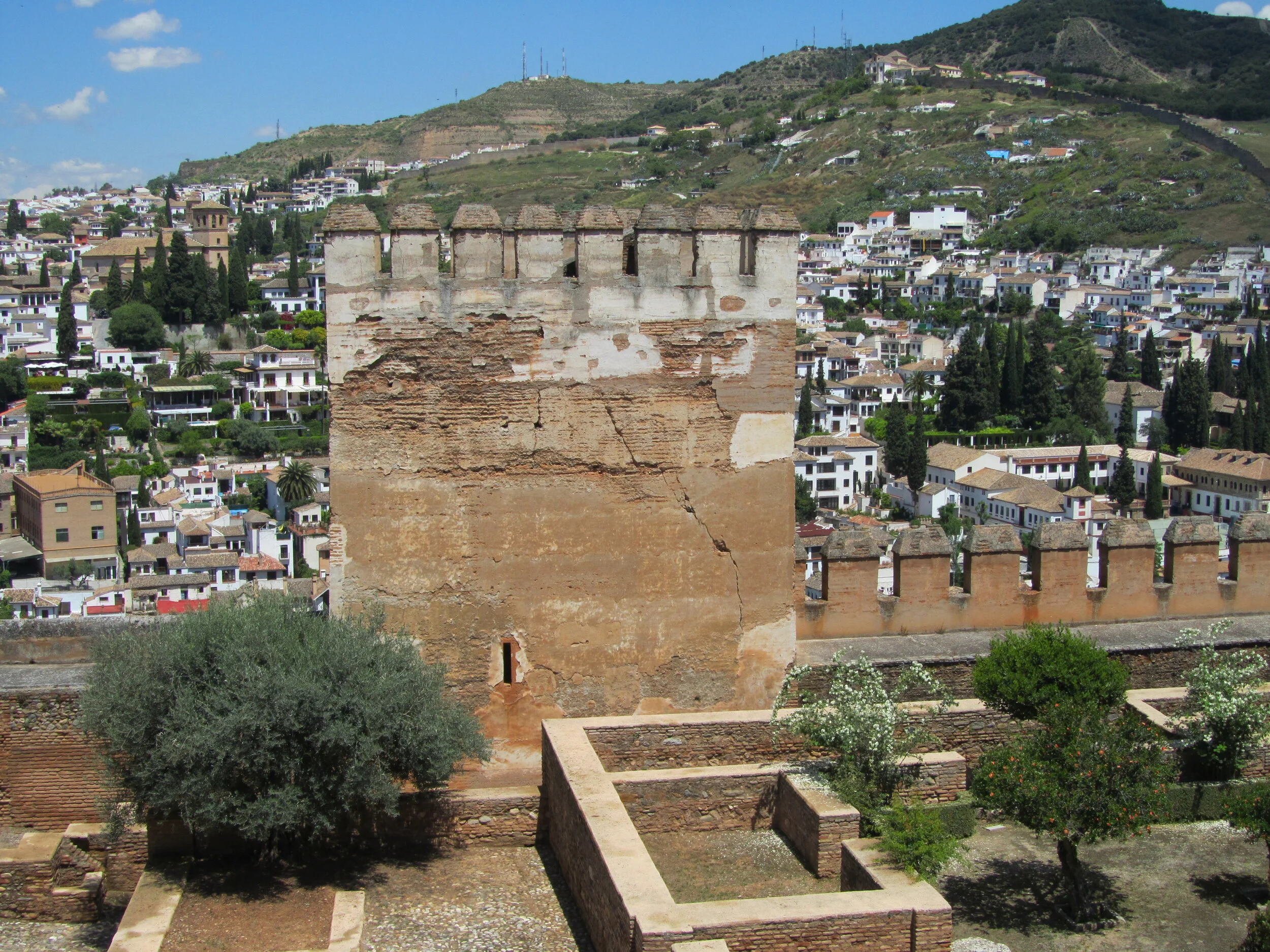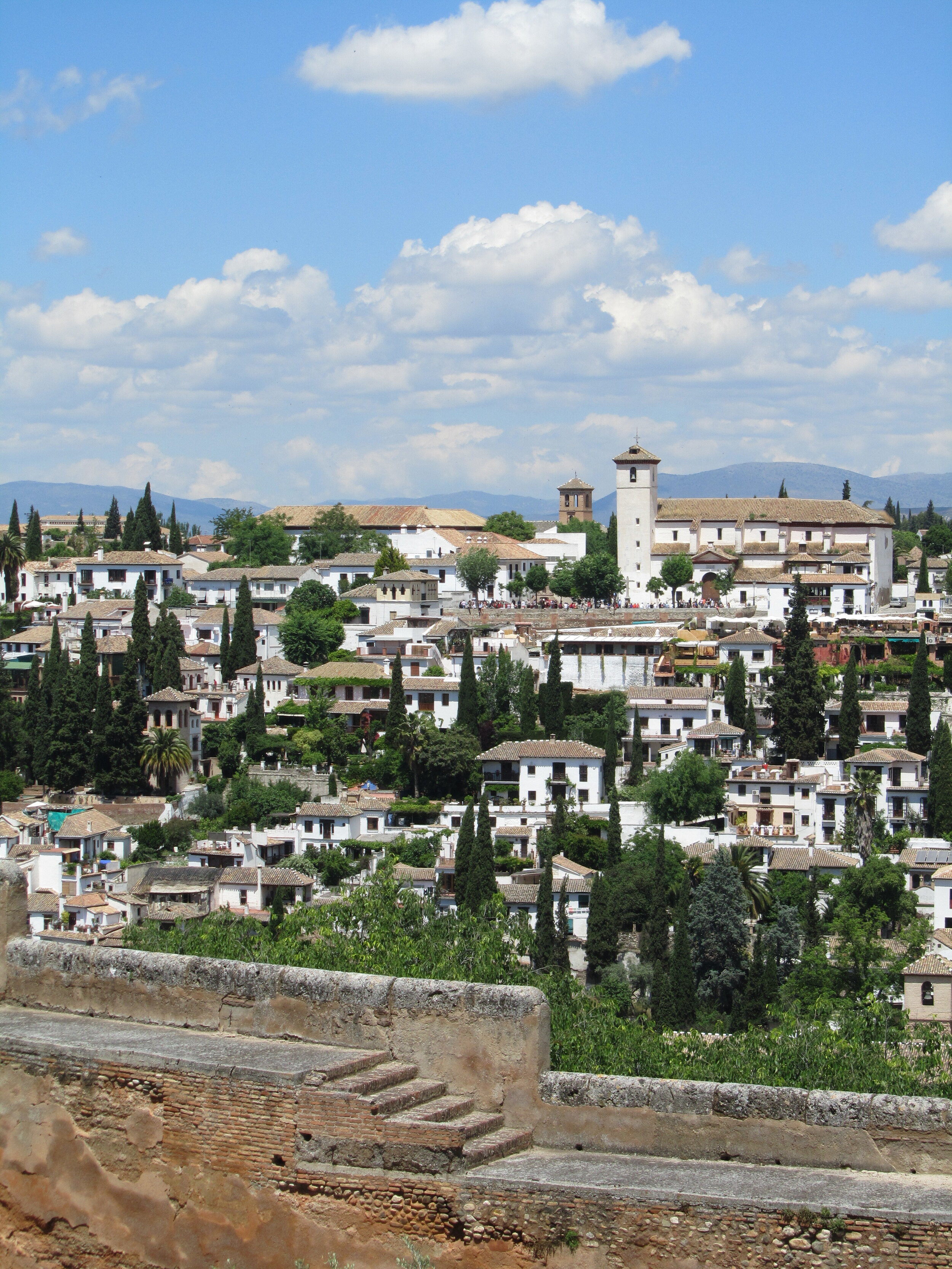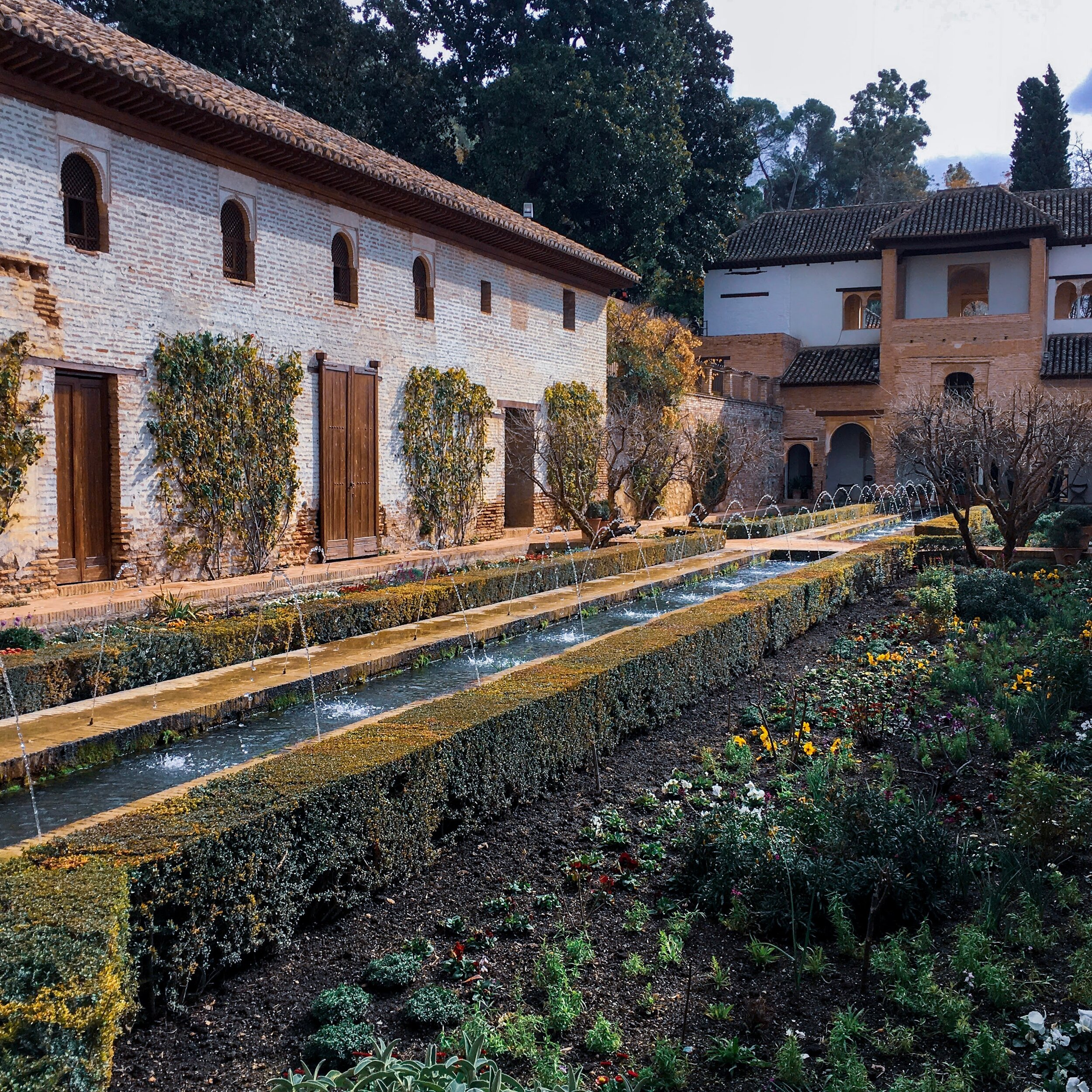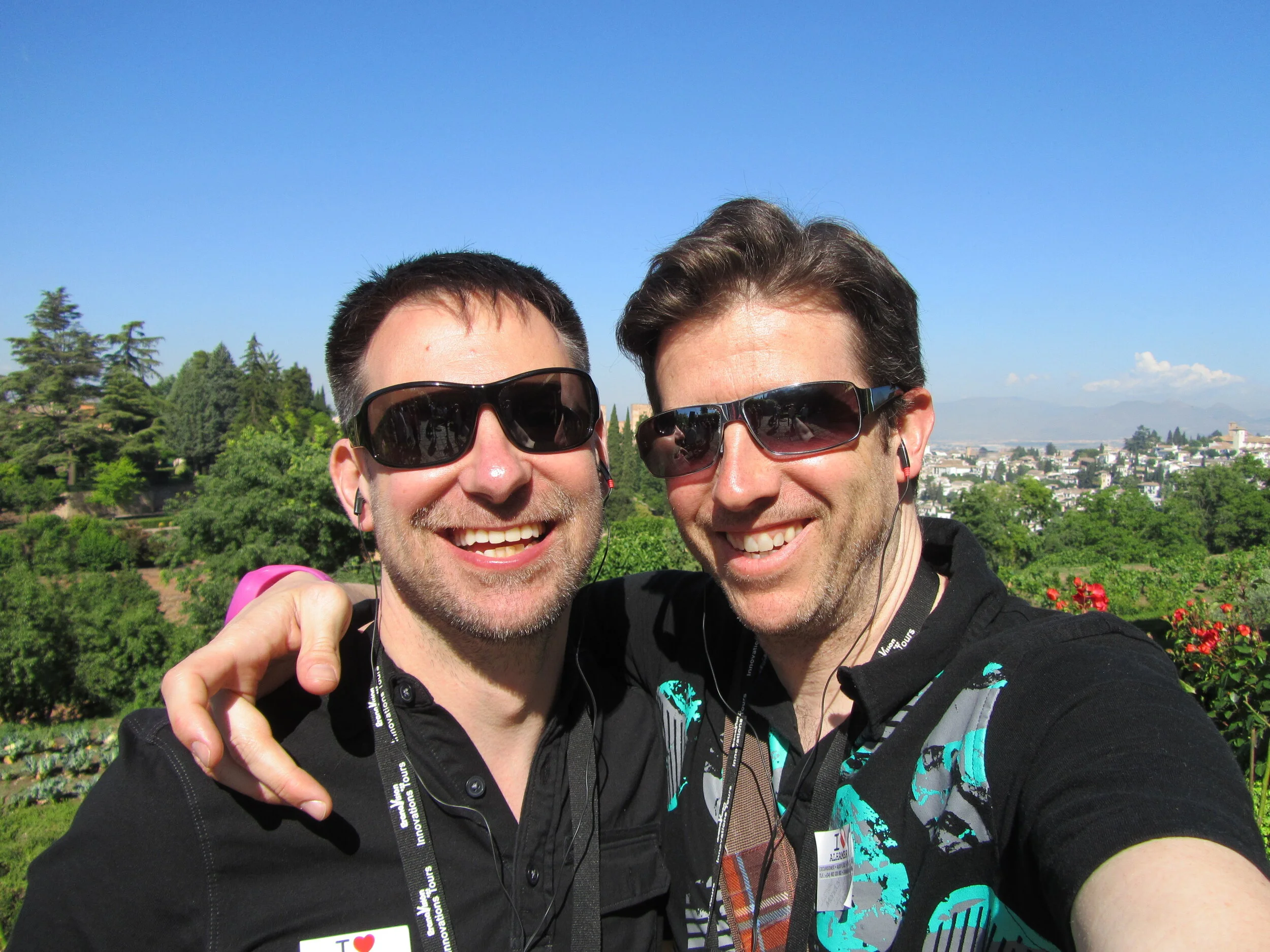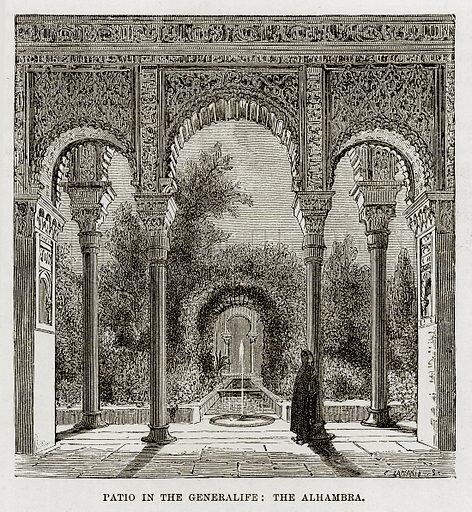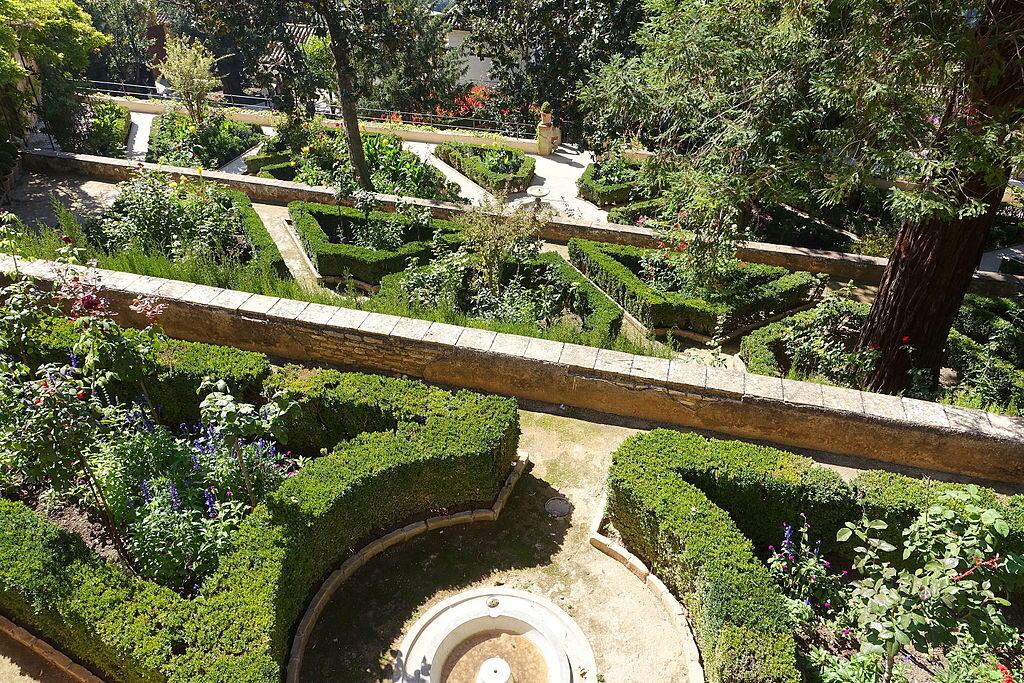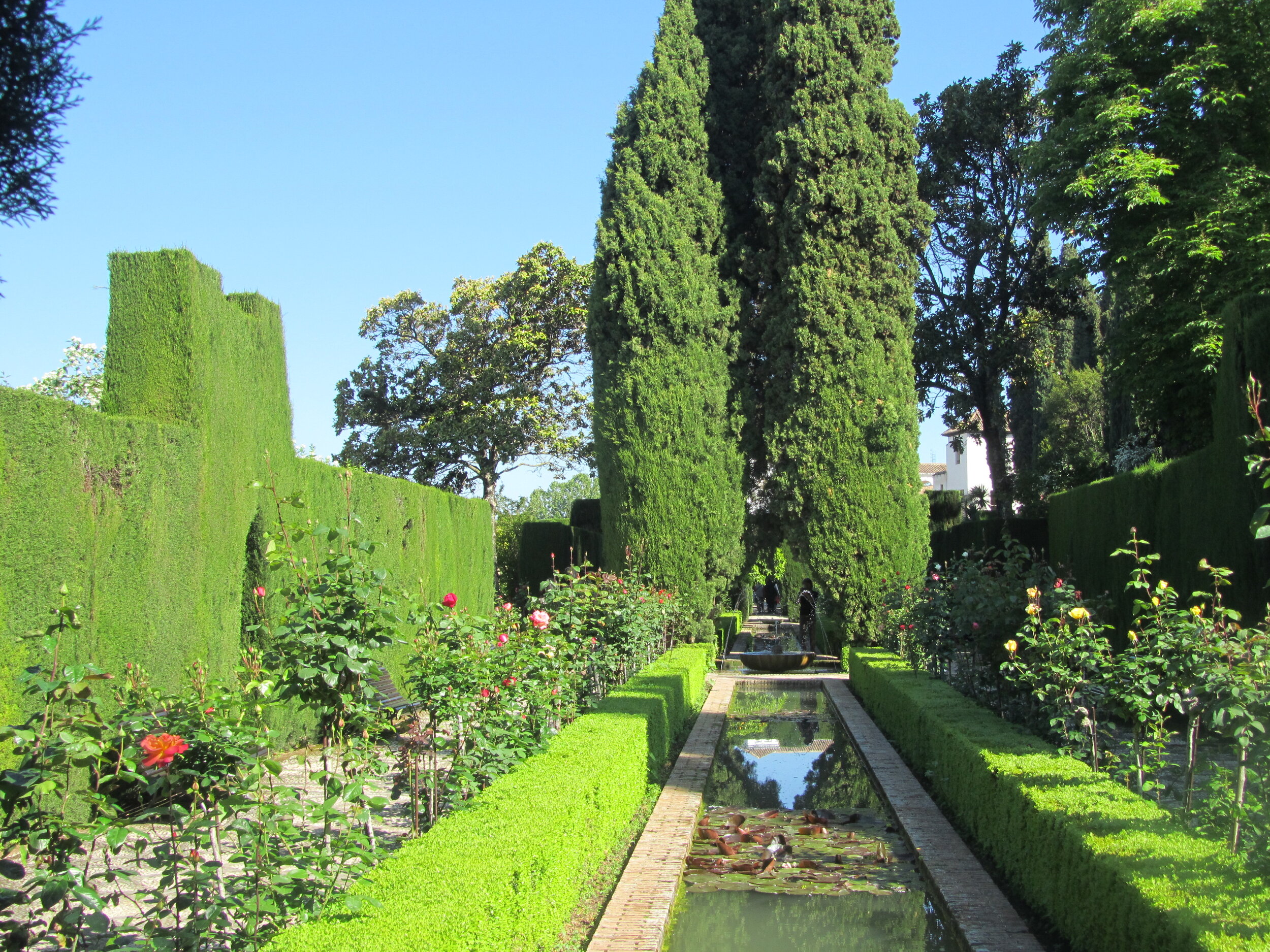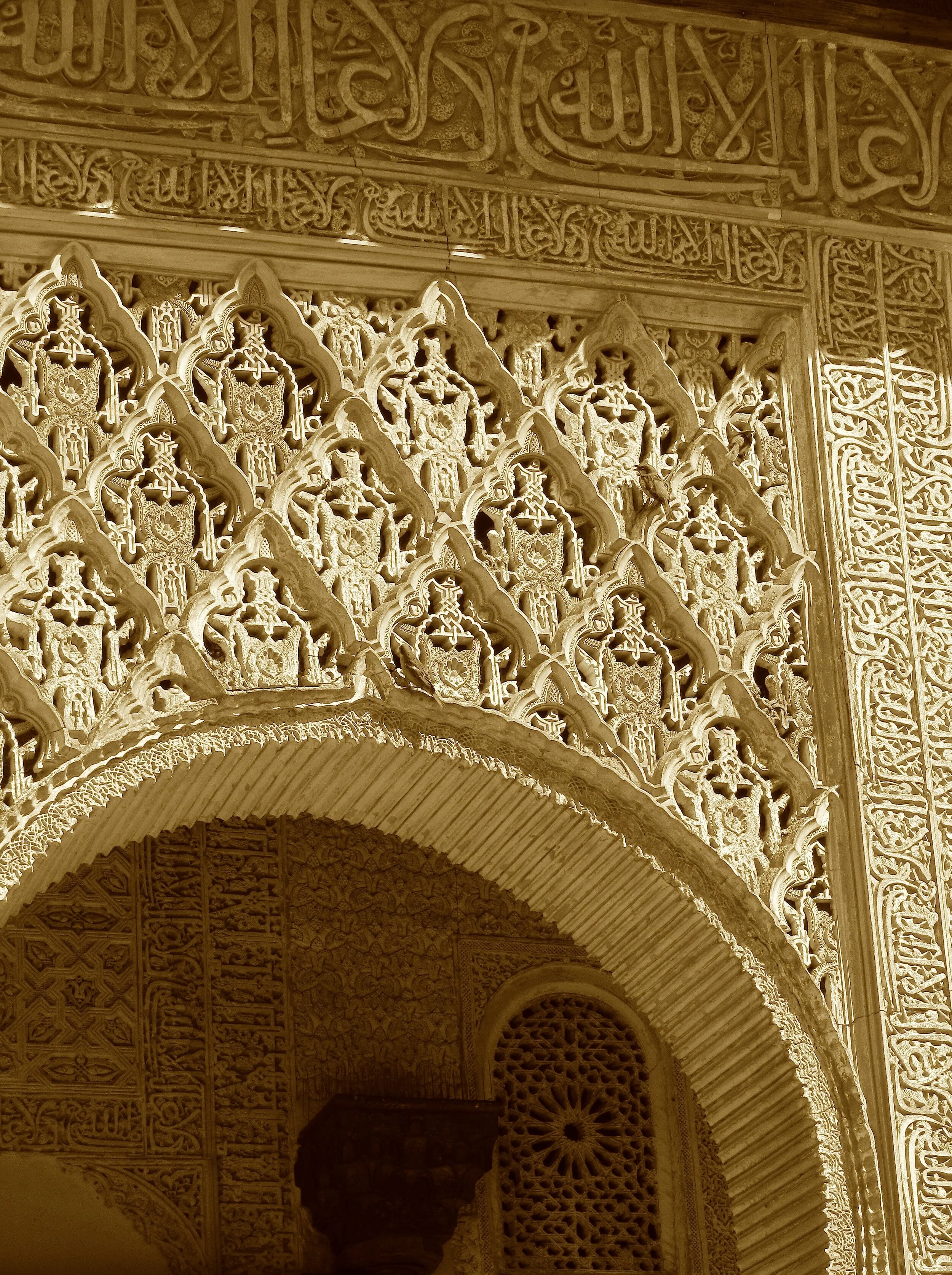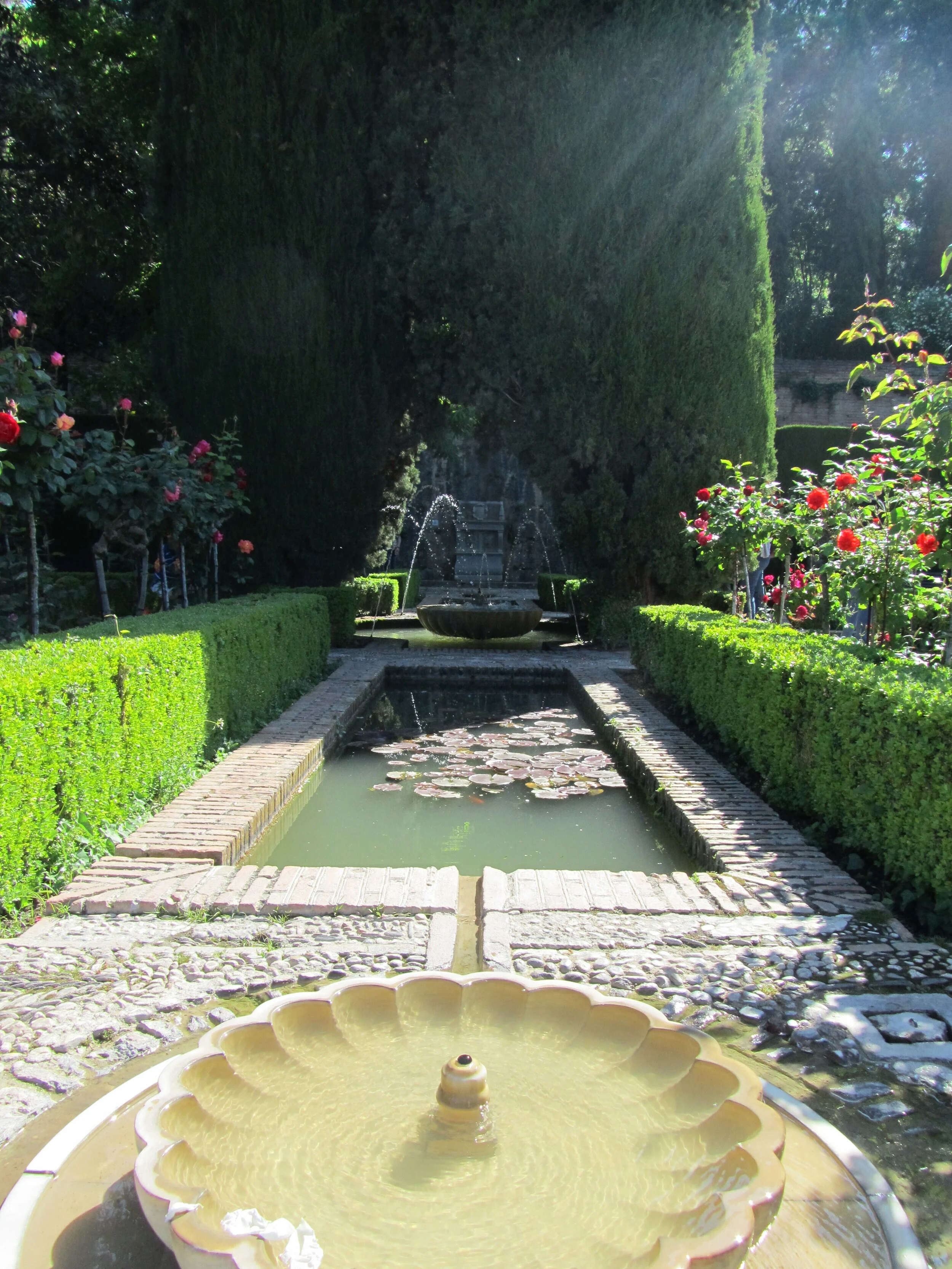Looking for things to do in Córdoba, Spain? Take a detour at the Cordoba Museum of Fine Arts and explore the city’s historic and artistic legacy.
The Cordoba Fine Arts Musuem is unassuming but provides an educational diversion for an hour or so. One gallery is dedicated to the works of sculptor Mateo Inurria and his works, including Les Tres Edades de la Mujer (The Three Ages of Woman) from 1923.
While looking for things for Wally and me to do beyond the remarkable Mosque-Cathedral of Córdoba, I stumbled upon an image of a room featuring a vibrant yellow totemic sculpture. The picture, which intrigued me, was from the Turismo de Córdoba website and was one of the galleries inside the Museo de Bellas Artes de Córdoba (Cordoba Fine Arts Museum).
Colt Fountain in Plaza del Potro is an homage to the livestock that was once sold here.
Plaza del Potro: Where Livestock (and Sex) were Sold
The modest museum is tucked into a courtyard off the Plaza del Potro (Colt Square) and a short walk from where we were staying at Los Patios del Pañuelo. While commonly called a square, the plaza has evolved over time and is now a rectangle that stretches down to the Guadalquivir River. It contains two monuments: a fountain crowned with a sculpture of a rearing colt (hence the “potro” in its name), balanced atop a pineapple-shaped vase, and a statue of the archangel San Rafael, the city’s patron saint.
Fun fact: Once a bustling hub for livestock traders, artisans and travelers, the square included the Posada de Potro (Colt Inn), a medieval brothel that was frequented by celebrated Spanish novelist Miguel de Cervantes. The author mentions the inn in his novel Don Quixote, referring to it as a “den of thieves.”
Sadly, the inn (a nicer way of saying whorehouse?), has since closed. Today, the storied property is home to the Centro Flamenco Fosforito, a small museum dedicated to renowned singer, Antonio Fernández Díaz, aka Fosforito, and the art of flamenco.
To reach the museum, Wally and I went through a passage on the exterior of the former Franciscan Hospital de la Caridad (Charity Hospital), where the words “Museo Provincial de Bellas Artes” are carved in stone above the doorway. Once inside, we found a peaceful courtyard with a fountain surrounded by orange trees and a pair of busts. One pays homage to the museum’s first director, painter Rafael Romero Barros, while the other honors novelist, diplomat and politician Juan Valera.
You enter the museum courtyard through the arched doorway seen here, underneath the fancy writing.
Andalusia is filled with charming courtyards, and this one doesn’t disappoint, with its beautiful stonework paths.
The museum’s collections span centuries and encompass paintings, drawings, sculptures and engravings by Cordoban artists from the 16th to the 21st century.
After purchasing our entrance tickets, we noticed the bronze head of Gonzalo Fernández, the “Gran Capitán,” attributed to sculptor Mateo Inurria.
Fernández earned his nickname “the Great Captain” by leading successful campaigns during the Conquest of Granada and the Italian Wars while serving the Catholic Monarchs, Ferdinand and Isabella.
Cabeza de Gonzalo Fernández de Córdoba para el Monumento al Gran Capitán (Head of Gonzalo Fernández of Córdoba for the Monument to the Great Captain) by Mateo Inurria, 1915
Notice how the head of this statue is marble while the rest of it is bronze? The original metal head can be found in the Fine Arts Museum, though we’re not sure what prompted this odd decision.
Fun fact: This is the original head of an equestrian monument in la Plaza de las Tendillas, the town’s main square. For some reason, it was replaced by a head sculpted from white marble, in contrast to the rest of the figure.
You can start your exploration of the museum by turning left into the room covering the Baroque period and seeing religious art reappropriated by the government.
The Baroque in Córdoba
We began our tour of the museum in Room IV, which held a number of impressive ecclesiastical works made at the height of Baroque painting in Córdoba. During this period, artists like Antonio del Castillo y Saavedra embraced naturalistic realism, employing chiaroscuro—the use of light and dark to emphasize the emotional narrative in their works.
Inmaculada Concepción (Immaculate Conception) by Juan Antonio de Frías y Escalante, 1667
El Sacrificio de Isaac (The Sacrifice of Isaac) by Antonio del Castillo y Saavedra, circa 1650
The majority of these artworks were acquired from convents during La Desamortización, a period from 1835 to 1868, when the Spanish government seized monastic properties belonging to the Catholic Church, turning them into “national assets,” which were then sold at public auction to the highest bidder.
One of the most coveted artistic projects after 1600 was the creation of 24 paintings for the altars of the cloister at the Franciscan Convent of San Pedro el Real by Antonio del Castillo. These canvases depict episodes from the life of Saint Francis de Assisi. In the museum’s painting, the scene depicts an angel holding the newborn saint above a baptismal font.
Bautismo de San Francisco de Asis (Baptism of Saint Francis of Assisi) by Antonio del Castillo y Saavedra, circa 1664
Fun fact: The oil painting is signed “Non fecit Alfar” (Alfaro didn’t do it). This signifies that Castillo won the commission over his competitor, Juan de Alfaro y Gámez. How delightfully petty!
Bendición Sánchez by Julio Romero de Torres, 1904
The 18th and 19th Centuries in Córdoba
The next gallery we visited contained works from the 18th and 19th centuries, predominantly featuring local landscapes, portraits and still lifes by the museum’s founder, Barros.
Bodegón de Naranjas (Still Life With Oranges) by Rafael Romero Barros, 1863
The Baroque style eventually yielded to Rococo, and around 1775, in the wake of the Lisbon earthquake, it shifted once more, leading to a wave of local artists embracing Romanticism. Around this time, the Escuela Provincial de Bellas Artes was established, and within its walls, Barros emerged as a prominent figure.
Barros assumed a dual role as both director and mentor to a group of art students, including Tomás Muñoz Lucena, Rafael Hidalgo de Caviedes and Inurria. Among them were his sons, Enrique, Rafael and Julio Romero de Torres.
Un Recuerdo de África, Novia Sefardí (A Memory of Africa, Sephardic Bride) by Rafael Romero Barros, 1878
Columbus Leaving the Mosque by Rafael Romero Barros, 1886
The painting Columbus Leaving the Mosque by Rafael Romero Barros was inspired by a poem by the Duke of Rivas titled “Romance of a Great Man.” It depicts Columbus leaving the Mosque-Cathedral after prayer and encountering his future mistress, Beatriz Enríquez de Arana, for the first time. According to legend, she brought Columbus to her home to protect him from mocking children who regarded him as a madman for seeking royal backing for his voyage to the New World.
We were pleasantly surprised to discover there was quite a large collection of modern art as well.
Art in the Modern Era: 20th Century and Beyond
Throughout the 20th century, local artists changed their styles to suit prevailing tastes, shifting from Realism to Modernism to Regionalism. They drew inspiration from contemporary artists like Rafael Botí, Pedro Bueno and Ángel López, who delved into Impressionism and Fauvism. In contrast, individuals like Antonio Rodríguez Luna and Alfonso Ariza embraced avant-garde movements such as Cubism, Abstraction and Expressionism.
Sin Título (Untitled) by José Duarte Montilla, 1981
El Cante (Flamenco Song) by Julia Hidalgo Quejo, 2005
La Fuente del Patio del Museo (The Fountain in the Museum Courtyard) by Rafael Botí Gaitán, 1990
Mujeres Vela (Sail Women) by Antonio Rodríguez Luna, 1945
A key figure among this group of artists was the sculptor Inurria. The museum has a room dedicated to his works.
Un Náufrago (A Castaway) by Mateo Inurria, 1890
While exploring the gallery, I was captivated by a peculiar painting by Ginés Liébana. His dreamlike piece Buenas Mujeres para ser Caballos (Good Women to Be Horses) was painted in 1979. Liébana creates a surreal scene by combining elements: a woman’s head adorned with a flower-covered hat on a horse’s body. He integrates local landmarks, such as the rearing colt of the Plaza del Potro and the figure of the Archangel Rafael, into this otherworldly landscape.
Buenas Mujeres para ser Caballos (Good Women to be Horses) by Ginés Liébana, 1979
Fun fact: Liébana contributed his distinctive style to Cántico, an avant-garde artistic magazine led by poet Ricardo Molina. The publication used poetry and illustration to challenge the status quo during the Franco dictatorship.
Faded religious frescos and graffiti scribbled by hospital patients line the staircase.
Stairway to Heaven: Frescoes and Graffiti
The staircase leading to the upper floor includes graffiti that most likely was the work of hospital patients. One of these is a labyrinth with seven concentric circles surrounding a central point—visible beneath a monochromatic mural of Saint Jerome.
On the rear wall, a religious scene depicts Christ on the Cross between the Virgin and Saint John the Evangelist. Flanking this central image is Saint Jerome, clutching a stone for beating his breast in penitence, and Saint Francis of Assisi in prayer.
El Retablo de la Flagelación (Altarpiece of the Flagellation of Christ), circa 1500
Gothic and Renaissance Art in Córdoba
The Gothic movement gained popularity in Córdoba in the late 14th century. However, it wasn’t until the 15th century that painters’ guilds flourished, distinguishing Córdoba from other Andalusian cities, such as Sevilla and Granada.
This environment was conducive to establishing major workshops by artists, including Alonso Martínez, Pedro de Córdoba, Jorge and Alejo Fernández, and Baltasar del Águila. Under the reigns of Charles V and Phillip II, local art underwent a transformation, departing from Gothic influences and embracing new expressions of Renaissance humanism. This worldview focused on the nature and importance of humanity that originated from the study of classical antiquity.
Here you can see an altarpiece from the chapel of a hospital founded in the 14th century by alderman Antón Cabrera and his wife, Beatriz de Heredia. The facility closed down in 1837.
El Retablo de la Flagelación (Altarpiece of the Flagellation of Christ) is a superb example of the Córdoba school’s work and showcases the unknown artist’s adept use of Renaissance techniques. The composition of the figures reflects the Northern European style, popularized through engravings, and the panel as a whole draws inspiration from a similar painting produced by the German artist Martin Schongauer around 1480.
Its side panels depict Saint John the Evangelist and Saint Anthony of Padua on the right, and Saint Anthony Abbot and Saint Francis of Assisi on the left, each with their distinctive iconography.
Fun fact: The artwork was initially misattributed to Alonso de Aguilar due to the mistranslation of a document accompanying the piece when it was acquired by the museum in 1866.
Retrato de Joaquín y Rafael Mir de las Heras Niños (Portrait of Joaquin and Rafael Mir de las Heras Children) by Enrique Romero de Torres, 1905
A Life Fit for a Museum
The final gallery featured the exhibition Museum Worthy Life, dedicated to painter Enrique Romero de Torres (yes, the entire family had serious skills). After his father, Rafael, passed away in 1896, Enrique stepped up to run the museum as the director and curator. His responsibilities for the next 30 years kept him from dedicating himself entirely to painting. But under his direction, the renovations and expansions of the museum were carried out, with him paying for part of the works and donating, along with his brothers, paintings by his father.
Take a quick lesson in local art history at the Museo de Bellas Artes de Córdoba, from Baroque to modern.
Listen, there are a lot of things you’ve gotta do in Córdoba, including La Mezquita, the Alcázar and the Palacio de Viana (not to mention taking a picture of the Roman Bridge). But if you have some free time, I recommend visiting this museum. Admission is only 1.50 euros (about $1.60) and is free to EU passport holders. The curation of each gallery is well thought out, ensuring an easy and enjoyable experience. Plus it’s a cool experience that will expose you to the artistic talents of Córdoba. –Duke
Museo de Bellas Artes de Córdoba
Plaza del Potro, 1
Centro, 14002
Córdoba
Spain








